June 29, 2009
Antonio Pappano and Friends — Royal Opera House, Covent Garden
But having been the only consistent presence in this ill-fated Royal Opera House recital concert, it was only right that “Recital: Antonio Pappano” was the strap-line on tickets purchased on the day.
’Twas not ever thus. Rolando Villazón had been booked to give a recital with Pappano at the piano, but in early May, following a repeat of the vocal problems which plagued him a couple of years ago, Villazón withdrew from all his engagements until well into 2010. The Royal Opera was relieved to secure the services of Dmitri Hvorostovsky as a recitalist, as were Hvorostovsky’s fans, particularly after a concert he was scheduled to give at the Royal Festival Hall last month was cancelled at a day’s notice after his recital partner, Anna Netrebko, became ill.
Fast forward to Monday of this week, with the recital due to take place on Wednesday, and Hvorostovsky too became indisposed following what Pappano worryingly described as ‘a nasty accident to his vocal chords’. Step forward Joyce DiDonato — currently in town rehearsing Rosina for the Royal Opera — and Joseph Calleja and Thomas Hampson, on a night off from La traviata. By the time I arrived at Covent Garden on Wednesday evening to collect my ticket, I had given up on speculating who might appear, and I really cared not a jot what any of them was going to perform. I was just pleased they were there.
As the operatic repertoire is rather short on trios for mezzo, tenor and baritone, the scene was set for a programme consisting primarily of solo pieces — and that is what we got. Against a mirrored backdrop which looked suspiciously like part of the set for the last act of Un ballo in maschera (which opens later this week), the programme consisted primarily of song with a couple of music-theatre numbers thrown in.
Calleja started off with three crowd-pleasing Italian concert bonbons; if the final moments of Tosti’s ‘A Vucchella’ were a touch flat, it didn’t detract too much from the pleasure of hearing a voice so integrated from top to bottom; there was real sunshine in the top note of Leoncavallo’s ‘Mattinata’. After the interval he had less success with ‘Ô souverain’ from Le Cid, that old Domingo favourite, which suffered from fragmented phrasing and a lack of care for legato. But his delivery has an endearing honesty — he sings from the heart, and his final solo, Guy d’Hardelot’s ‘Because’ was a real winner.
The highlight of DiDonato’s performance was a spellbinding Willow Song from Rossini’s Otello, all limpid melancholy and faultless legato, following a charming and entertaining account of the same composer’s playful song cycle La regata veneziana. She went on to finish her programme with two American musical-theatre standards, ‘Can’t Help Lovin’ Dat Man’ and ‘Somewhere over the Rainbow’. It was the Jerome Kern song that really showed off what a gifted and versatile musician Pappano is, busking an intricate jazz accompaniment, though I would personally have preferred to hear DiDonato sing a fiery Handel aria. Hampson’s programme was perhaps the most interesting of the three, starting with Mahler’s Lieder eines fahrenden Gesellen. This concert, having been cobbled together in haste, offered neither surtitles nor a translation sheet, but the eloquence of Hampson’s performance was testament to his intelligence and gift for narrative. He continued in the second half with two American songs, Harry Thacker Burleigh’s ‘Ethiopia Saluting the Colours’ and Barber’s ‘Sure on this Shining Night’. It was a shame he chose not to perform any opera, other than the barnstorming Pearl Fishers duet which we got from the two gentlemen as the final item on the evening’s programme.
In the midst of all this the Royal Opera’s Concert Master, Vasko Vassilev, joined Pappano for a brief but satisfying appearance in what felt like a private violin recital; the first two movements of Tchaikovsky’s Souvenir d’un lieu cher followed by Rachmaninoff’s Vocalise were all played with lyrical warmth and elegance.
The concert felt like a variety show at times — somewhat bitty and fragmented, and rather disappointingly (if understandably) devoid of encores — but it proved to be an interesting and unexpected evening’s entertainment. And if Pappano defied convention by being billed as the main attraction, I defy anybody to claim he didn’t earn it.
Ruth Elleson, June 2009
image=http://www.operatoday.com/pappano.gif image_description=Antonio Pappano [Photo by Clive Barda courtesy of The Royal Opera House]
product=yes producttitle=Antonio Pappano and Friends — Royal Opera House, Covent Garden productby=Above: Antonio Pappano [Photo by Clive Barda courtesy of The Royal Opera House]
Dalibor Jenis sings Renato in the Royal Opera house Un ballo in maschera.
Bratislava-born Jenis was drawn to opera from a very early age, singing Mozart from the age of 19. He’s since become an Italian opera specialist, having in his repertoire roles like Germont, Don Carlo, Don Giovanni, Figaro, and many others. Renato is a particular favourite. “The role is very full, emotionally. Renato and Riccardo are good friends and good men, but everything changes from white to black. And then in the third act, the aria ‘Eri tu’, it’s so full of feeling. Renato is remembering the past happiness even when he’s in a tragic situation. He’s full of anger, yet he loves Amelia and is torn with different emotions. It is such wonderful music”.
Jenis first sang the part in Germany in a production where rehearsal time was limited, and the soprano changed. It wasn’t easy to develop the role and he was anxious. Yet once he started to sing it, everything came together naturally. He’s now sung the part many times, including Berlin and Vienna. The more he sings it, the more he finds in the character. “It’s like a vision, when you open a door and see a new room, so many interesting things to hear”.
This London production is especially rewarding. He was very impressed when he saw how the ball scene is staged. “It’s a very strong moment”, he says, for it’s the climax of the opera, and extremely dramatic. There’s a huge mirror which reflects the action, intensifying the dramatic impact. “When I first saw it, I was quite surprised at first but now I understand how perfect it is. There is movement everywhere. When Renato stabs Riccardo, those close by are frozen in shock. But elsewhere people are moving, running about, speaking quickly. It’s like two different worlds, happening at the same time”. Those closest to the killing are traumatized, while others move in agitation. “This is one of the best productions”, adds Jenis with enthusiasm.
The conductor is Maurizio Benini, with whom Jenis has worked for many years. “He’s a very good conductor because he knows what we singers need, it’s very natural. The orchestra at the Royal Opera House is one of the best in the world. When they play, it’s like every one of them is a concert master. For us singers, it’s great motivation to hear such good musicians”. Benini is good to work with because he gets on well with the cast and listens to what they feel. “It’s team work”, says Jenis. “It’s so good to have a conductor who is responsive. We can discuss things and find compromises because we respect each other”.
In his forties, Jenis is maturing well. New roles await : he wants to sing Rigoletto and Il Trovatore, for example. He’ll soon be singing a gala concert in Dresden of arias from these operas. “I like complicated characters like these” he says, “because they are interesting”.
“I think acting is as important as singing. Years ago, you could have fat singers who didn’t move much on stage but had wonderful voices and everyone was happy. Now people expect more.” Jenis is interested in the way small details and movement can make a characterization stronger. “I search every role to find moments when I can express things better”. Sometimes it’s as simple as changing position subtly. “I don’t like to be like a machine, doing exactly the same thing every time”, he says. “In life, things change all the time”. This keeps performance fresh and natural. “Even when we’re not singing, there is a connection between singers, which an audience can feel very clearly”.
Good acting isn’t all obvious movement. When Jenis was very young, he watched a Carmen, where the mezzo was in her mid fifties. She sang the Habanera so effectively that she was utterly convincing without having to overact. “She was so strong, she didn’t have to move a lot or “be sexy”, she acted with her face and her voice. I said to myself, “This is Carmen”.
Singing at the Royal Opera House means a lot to Jenis. He first visited when he wife was singing in Kát’a Kabanová. He was greatly impressed. “It looked wonderful and the orchestra played so well. I thought, “what a pleasure it would be to sing here”. To date, he’s sung at Covent Garden several times, in La Bohème, Cosi fan tutte, Madama Butterfly and Faust, the latter with Maestro Bellini and Ramón Vargas, with whom he’ll be creating this Un ballo.
“It’s such a pleasure to work in London at this house”, he says, “Because there is such a high level of professionalism, at all levels. We singers feel that they are all behind us, not just the musicians but all the staff. It’s so well organized and everyone takes responsibility and does their best. So we do our best, too”.
Anne Ozorio
Un ballo in maschera runs from 26th June to 17th July 2009 at the Royal Opera House, London.
image=http://www.operatoday.com/dalibor-jenis.gif image_description=Dalibor Jenis [Photo by Vladimir Yurkovic]
product=yes producttitle=Dalibor Jenis sings Renato in the Royal Opera house Un ballo in maschera. productby=Above: Dalibor Jenis [Photo by Vladimir Yurkovic]
Glyndebourne : a spectacular Purcell The Fairy Queen
The estate itself is magnificent, but Glyndebourne is distinctive because it’s dedicated to excellence. Christie’s vision was to create “not the best we can do, but the best that can be done anywhere”. Glyndebourne is like Bayreuth, but with wider range.
Celebrating Glyndebourne’s anniversary with The Fairy Queen was a masterstroke, honouring Shakespeare and Henry Purcell, born 350 years ago. This production, conducted by William Christie (no relation to John), conducted by Jonathan Kent and designed by Paul Brown is spectacular in every sense. For Purcell and his contemporaries, opera was meant to be spectacle, to astound audiences with its inventiveness and wit. In the current economic climate, this glorious production may seem extravagant. But baroque is a statement of faith in the power of art to transcend grim reality.
Baroque taste was inspired by the exotic, by the possibilities offered by new worlds “discovered” in Asia, South America and Africa. Thus the first scene, in a conventional 18th century drawing room, cabinets filled with porcelain and a tree of crimson coral. But The Fairy Queen is based loosely on A Midsummer’s Night’s Dream, where, in the darkness of night, fairies rule, and the realm of dreams finds release. Bizarre as it may seem, baroque sensibilities bore fruit in Romanticism and in 20th century ideas about the subconscious.
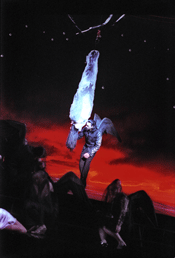 Sally Dexter as Titania and Joseph Millson as Oberon
Sally Dexter as Titania and Joseph Millson as Oberon
Oberon and Titania (Joseph Millson and Sally Dexter), and their minions are fairies with attitude, sporting sinister wings like ravens, and black costumes, part evening dress, part bondage gear. They tumble out of the cabinets, invading the rational world. Even Titania isn’t safe : Oberon’s magic potion goes awry, so she falls in love with Bottom, transfigured as an ass.
Shakespeare’s play within a play lends itself superbly to Purcell’s concept of opera as a combination of different forms of theatre — song, masques for dancing, orchestral fantasies, tracts of spoken dialogue and dramatic tableaux. Towards the end, stage overflows into auditorium, players running in through the stalls. William Christie turns to the audience, encouraging them to sing along. At the very end, rose petals fall from the ceiling, engulfing the patrons, a final coup de théâtre which evokes Glyndebourne’s lovely gardens beyond the building.
The workmen-actors enter the drawing room with cleaning tools. Their very bumptiousness is a subversive send up of the bewigged formality with which the tale begins. The play they create, complete with talking wall and cowardly lion is an anarchic parody of theatre, which is itself an illusion of ordinary life. At the performance I attended, Robert Burt who plays Flute who plays Thisbe tore a ligament in one scene, coming on later with a splint and walking stick. It was a wonderful moment where practical reality merged, yet again, into art.
In dreams, symbols hold sway. Literally, in the scene where Titania is wrapped in shrouds of muslin as she falls into deep sleep. Then a giant spider descends from the ceiling, sweeping the queen upwards like prey, suspended dangerously above the stage. It’s a shockingly potent image, dangerous and breathtaking — if the spiders thread should break, the singer might indeed be killed. A giant opium poppy appears alluding to unnatural dreams and again to the implication of danger and death. Titania and Bottom, played by Desmond Barrit, his head now an ass, float away in a boat shaped like a giant pea pod which emerged from the bowels beneath the stage. As if crossing the River Styx, they are ferried by a gondolier with the head of a fish.
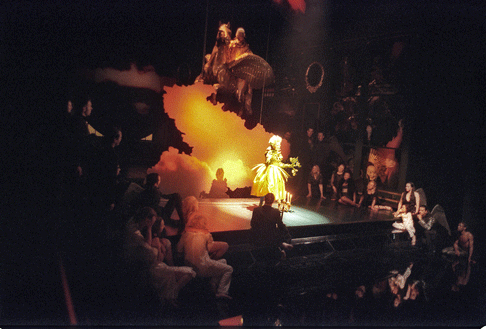 Autumn
Autumn
Purcell’s drama was influenced by the exigencies of his time. Thus the baroque taste for elaborate theatrical illusions, which this production faithfully honors with the extra benefit of modern technology and lighting. The roof opens as huge wooden cut outs of clouds descend. The clouds part to reveal a resplendent Sun King astride a golden Pegasus, wings unfurled. Then, vignettes of each of the Four Seasons. Autumn comes dressed as cabbage and pumpkin, like those paintings of men as vegetables, so popular in baroque times. These tableaux don’t serve the narrative as such, they’re pure spectacle, in true 17th century spirit.
Adam and Eve appear, naked but for well-placed fig leaves under the canopy of a huge golden apple tree. Baroque audiences liked a bit of titillation, but would have understood the Biblical allusion. Eve flirts about and Adam eats an apple, after which the fairies throw them clothing from the wings. Finally the lovers are married - in the right combinations — and there’s a masque where the god of Marriage, Hymen (Andrew Foster-Williams) appears proffering the joys of wedded bliss. Perhaps baroque audiences related to marriage as a symbol of social stability, as opposed to the anarchy of nocturnal mayhem, portrayed earlier in the opera by giant bunnies copulating in myriad ways. Certainly ribaldry runs throughout this opera and even Shakespeare as bard was bawdy.
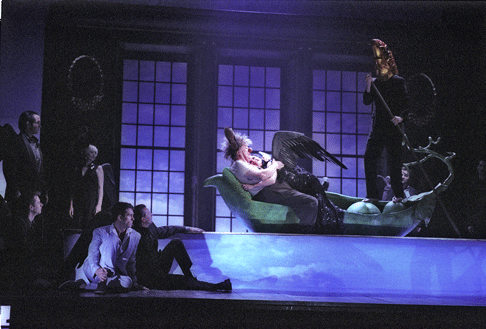 In peapod boat : Desmond Barrit as Bottom and Sally Dexter as Titania
In peapod boat : Desmond Barrit as Bottom and Sally Dexter as Titania
William Christie led the Orchestra of the Age of Enlightenment in free spirited, vivacious performance. This is the best baroque orchestra in England, so it was wonderful to hear them conducted by Christie, who is usually based in France. Very good singing, too. So many songs and ensembles flow in rapid succession that perhaps it’s better not to single out a few from the overall god work. Lovely dancing, too, and a delightfully athletic Puck (Jotham Annan).
This was an amazing Fairy Queen, which will be almost impossible to translate in the semi-staged performance to come at the Proms in London this summer. Nor will it work in theatres outside Glyndebourne which don’t have its superb facilities, so it won’t be included in the Glyndebourne Touring season. Let’s pray this production will be immortalized on film, so all can share in its glory.
Anne Ozorio
The Fairy Queen runs at Glyndebourne until 8th August 2009. This season at Glyndebourne includes Falstaff, Guilio Cesare, L’Elisir d’amore, Rusalka, Jenůfa, Tristan und Isolde and Così fan tutte. After the summer season, Glyndebourne Touring Opera can be heard in other cities in the United Kingdom. This production can also be heard in semi staged performance at the BBC Proms in London on 19th July 2009 , and will be broadcast internationally and online.
For more information please see the Glyndebourne website.
image=http://www.operatoday.com/DexterTitaniaGFO.gif image_description=Sally Dexter (Titania) [Photo by Neil Libbert courtesy of The Glyndebourne Festival]
product=yes producttitle=Henry Purcell : The Fairy Queen productby=Singers include Carolyn Sampson, Lucy Crowe, Claire Debono, Miriam Allan, Anna Devin, Ed Lyon, Sean Clayton, Andrew Ward, Robert Burt, Andrew Foster-Williams, Lukas Kargl, Adrian Ward and Desmond Barrit. William Gaunt (Theseus), Terrence Hardiman (Egeus), Oliver Kieran Jones (Lysander), Oliver Lesueur (Demetrius), Susana Wise (Hermia), Helen Bradbury (Helena), Sally Dexter (Titania), Joseph Millson (Oberon), Jothan Annan (Puck), Paul McCleary (Quince), Brian Pettifer (Snug), Roger Sloman (Starveling) Jack Chissick (Snout). Orchestra of the Age of Enlightenment. Conductor: William Christie. Director: Jonathan Kent. Designs: Paul Brown. Lighting: Mark Henderson. Choreography: Kim Brandstrup. 25th June, 2009, Glyndebourne, England. product_id=Above: Sally Dexter (Titania) [All photos by Neil Libbert courtesy of The Glyndebourne Festival]
Un ballo in maschera at Royal Opera House
No, really, ENO’s ‘controversial’ production of 2002 may have jarred with traditionalists but in many ways it made better sense than this revival of Mario Martone’s 2005 production. Martone is also a film director (cue groans from those who hated Kiarostami’s ‘Così’) and the opera is conceived as a series of tableaux, from the staid to the spectacular, but without much in the way of personenregie. The original production could boast of Mattila, Hampson and Álvarez in the leading roles, but for this revival the ROH have cast a house debutant soprano, the Chilean Angela Marambio, the Slovakian baritone Dalibor Jenis, and Ramón Vargas, and of the three it is only the tenor who produces a genuinely Verdian sound.
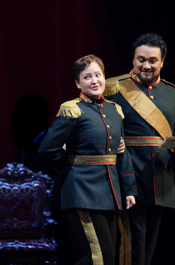 Anna Christy as Oscar and Ramón Vargas as Riccardo
Anna Christy as Oscar and Ramón Vargas as Riccardo
I have to declare a preference for the Danish setting, with the venial King Gustavus biting the dust at the ball — it simply makes more sense to me, all the ‘American’ references in the Boston version sounding daft to my ears, and exactly which Massachusetts ‘castello’ did Riccardo appropriate from his enemy? Of course I’m aware of all the censorship shenanigans, but the story is quite ludicrous enough without adding on any extras. He loves her, but he has preserved her honour? Oh please. Renato entirely fails to recognize his own wife just because she dons a veil? Give me a break. These absurdities can of course be negated in a production which focuses on gripping the emotions and making sense of the politics, but this wasn’t it.
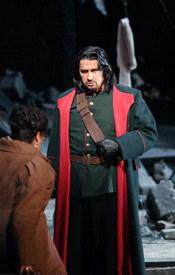 Dalibor Jenis as Renato
Dalibor Jenis as Renato
Ramón Vargas is yet another of those tenors once tipped to be one of the ‘new Three Tenors’ (groan) but he has survived this nonsense and is actually a fine musician, with a fairly light, flexible voice which he uses with taste and discretion — he lacks the big bow-wow effect beloved of many admirers of this repertoire, but there is no shortage of italianità in the singing, even though ‘Di tu se fedele’ was a little breathy and ‘O qual soave’ was rather thin on passion — that however was not exactly his fault. He did his level best to make something of the role, not exactly helped by either the direction or the Amelia.
Not only do revivals always encourage comparison — and it’s unfortunate in this context that Mattila was such a sympathetic heroine last time around — but they can also suffer from lack of work on the interactions between the principals, something which especially affected Angela Marambio, whose Amelia could blossom if she were able to actually do something on stage other than emote. Her best singing came in ‘Morrò, ma prima in grazia’ where stand and deliver is allowable, but in the Act II duet and at the death scene, she was sorely in need of some direction.
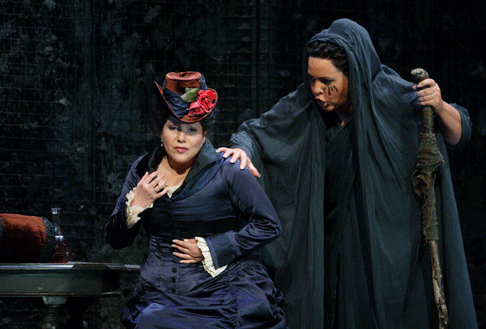 Angela Marambio as Amelia and Elena Manistina as Ulrica
Angela Marambio as Amelia and Elena Manistina as Ulrica
Dalibor Jenis has an imposing voice and stage presence, and he was often convincing as Renato, although I’m sure he would not be regarded as a genuine Verdi baritone by most aficionados of the breed. ‘Eri tu’ was however grippingly sung, in one of the few believable scenes of the evening. Elena Manistina was a sinister Ulrica, her cries about communing with Satan not once eliciting a chuckle from me — and that’s praise, by the way. Oscar is one of opera’s most irritating parts, but Anna Christy succeeded in not making me wince more than a couple of times — again, a compliment.
Orchestrally things were slow — very slow — although there was plenty of light and shade in Maurizio Benini’s conducting. In terms of the production, who would not love Sergio Tramonti’s wonderful design for the ball scene, with its framed image and brilliant use of mirrors? The only problem was that some of the characters did not quite seem to know what to do with themselves, even as their beloved ‘Governor’ was breathing his last. I liked Ulrica’s bear pit and the Act II gallows, although I imagine the latter was a trial for those who had to walk around in it. The other scenes were deeply conventional, as of course was the feel of the whole evening.
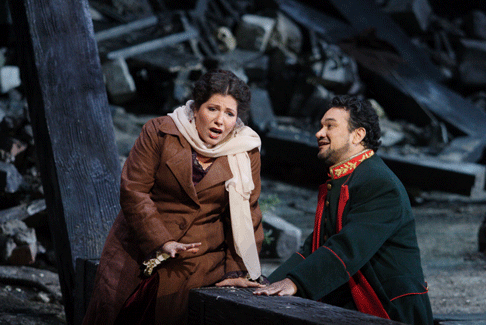 Angela Marambio as Amelia and Ramón Vargas as Riccardo
Angela Marambio as Amelia and Ramón Vargas as Riccardo
This ‘Ballo’ comes after a starry ‘Traviata’ and before an equally name-laden ‘Barbiere’ so in a way it’s a kind of breathing space, and if you like your Verdi without too many directorial surprises and your singing and acting styles traditional, you’ll be pleased with this production — first night wobbles must have taken the edge off some of the phrasing, and I’m sure that later performances will find all three principals much more settled in.
Melanie Eskenazi
image=http://www.operatoday.com/VargasBalloROH2.gif imagedescription=Ramón Vargas as Riccardo {Photo by Catherine Ashmore courtesy of The Royal Opera House]
product=yes producttitle=Giuseppe Verdi: Un ballo in maschera productby=Samuel: Giovanni Battista Parodi; Tom: Vuyani Mlinde; Oscar: Anna Christy; Riccardo: Ramón Vargas; Renato: Dalibor Jenis; Judge: Martyn Hill; Ulrica: Elena Manistina; Silvano: Changhan Lim; Amelia: Angela Marambio; Amelia’s servant: Neil Gillespie. The Royal Opera. Conductor: Maurizio Benini. Director: Mario Martone. Revival Director: Daniel Dooner. Set designs: Sergio Tramonti. Costume designs: Bruno Schwengl. Lighting design: David Harvey. Choreography and movement: Duncan Macfarland. Performance of Friday 26 June 2009. product_id=Above: Ramón Vargas as Riccardo [All photos by Catherine Ashmore courtesy of The Royal Opera House]
June 26, 2009
Gőtterdämmerung in Venice and Kőln — Sex and Politics Behind the Berlin Wall
La Fenice’s Ring, however, will not be completed until next season because of complicated programming and budgeting considerations. Consequently, the prologue, Das Rheingold, will be seen in the lagoon after the downfall of the Gods and of the Gibichungs’ Kingdom. Moreover, although the Carsen-Kinmonth-Tate team remained unchanged, many cast changes were made at La Fenice along with a revamping of the sets to fit its smaller stage.
Chronologically, the Köln-La Fenice Ring is one of the first to be staged in the 21st century. Its concepts are similar to those of the “politically oriented” Rings that prevailed from the mid-70s to the mid-80s, especially in Europe. This first of these “politically oriented” Rings was the (nearly aborted) La Scala production created by Luca Ronconi (stage direction) and the Pierluigi Pizzi (sets and costumes) in 1974. The musical director, Wolfang Sawallisch, objected to proceeding beyond Die Walküre. The entire project was revived in Florence (with Zubin Mehta in the pit) in 1979-82. The most widely known of the “politically oriented” Rings was the Bayreuth “Centenary” production in 1976 entrusted to Patrice Chéreau and Pierre Boulez. After four years in the “Holy Hill”, it became a successful television serial that was also shown in regular movie houses. Now whilst only photographs remain of the Florence production, the Chéreau-Boulez Ring is available on DVD. It is fair to say that the saga lends itself to a political allegory of industrial and political power, of lust for money and for women, of Nazism’s rise and fall, a direction taken by Luchino Visconti in his 1971 blockbuster film.
In light of this context, there is something old fashioned in the La Fenice-Köln production. Nevertheless, the Ghibichung Kingdom is not Hitler’s Reich, but rather East Germany before the fall of the Berlin Wall. Red flags are flying about the Royal Palace. The “nomenklatura” are dressed in elegant attire of the '50s, accompanied by soldiers of the National Peoples’ Army. Siegfried, Brünnhilde and the Norns, on the other hand, are shabbily dressed. The Norns live in an attic filled with broken furniture from the 1930s and the 1940s (an allusion to the defunct bourgeoisie?).
Albeit attractive, the Rhinemaidens appear poverty-striken, swimming in a polluted Rhine. As in many of Carsen’s production, politics is mixed with a fair amount of sex. At daybreak, Brünnhilde begins her passionate love duet by performing oral sex upon Siegfried. Hagen makes love to Gutrune on Gunther’s royal desk (in the presence of her brother and King). In the wife-swapping scene at the end of the first act, Siegfried (disguised as Gunther) attempts to rape Brünnhilde before remembering his pact with the King. The second-act wedding party initially appears as an orgy with rivers of wine and spirits and ladies taking off their clothes.
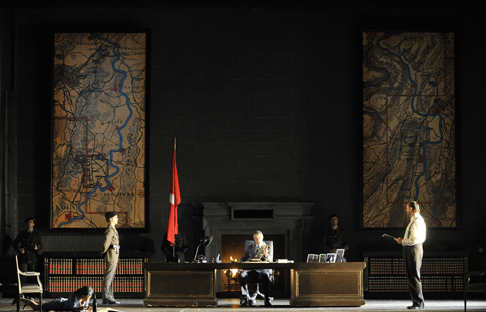
In a similar vein, the Rheinmaidens grope Siegfried all about his trousers. All of this heightens the coup-de-théâtre in the final scene. Brünnhilde is alone on stage during the holocaust, the fire of the Royal Palace, the downfall of the Gods and the flood of the river (cleansing corrupted Gods and corrupted men-in-power). During the concluding passages, a huge waterfall covers the stage. In short, although the concept goes back to the 70s, there are numerous innovations in this Ring and this Götterdämmerung in particular.
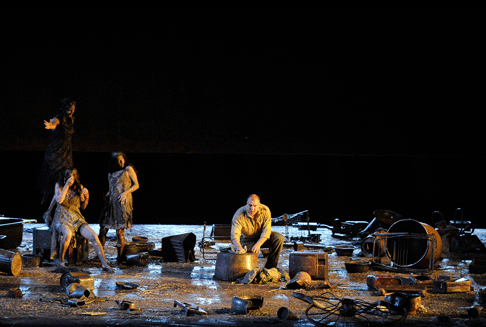
Although British, Jeffrey Tate possesses an Italian or Austrian conducting style. He caresses the orchestra with gently slowing tempi. This clashes, however, with the dramatic action-oriented stage direction. La Fenice’s orchestra fares well; but it is not that of the Maggio Musicale Fiorentino (which performed Götterdämmerung a few weeks ago) or of the Berliner Philarmoniker (which will perform Götterdämmerung in Aix en Provence in early July). Jayne Casselman was simply excellent, both vocally and dramatically, as a vibrant Brünnhilde to be remembered for some time. Her Siegfried, Stefan Vinke, performed well in the taxing third act; but in the previous two acts he displayed vocal problems (especially with the Cs) and a host of technical difficulties. He paled against Lance Taylor who performed the role in the recent Florence production. A sexy Nicola Beller Carbone was a vocally imposing Gutrune. And, the youthful Gabriel Suovane and Gidon Saks were two well-rounded bass baritones, whom, I trust, we will hear often in the future.
Giuseppe Pennisi
image=http://www.operatoday.com/Gotterdammerung_Fenice_02.gif image_description=Jayne Casselman as Brünnhilde [Photo courtesy of Teatro La Fenice] product=yes product_title=Richard Wagner: Götterdämmerung product_by=Siegfried: Stefan Vinke; Gunther: Gabriel Suovanen; Hagen: Gidon Saks; Alberich: Werner Van Mechelen; Brünnhilde: Jayne Casselman; Gutrune: Nicola Beller Carbone; Waltraute: Natascha Petrinsky; First Norn: Ceri Williams; Second Norn: Julie Mellor; Third Norn: Alexandra Wilson; Woglinde: Eva Oltiványi; Wellgunde: Stefanie Irányi; Flosshilde: Annette Jahns. Orchestra e Coro del Teatro La Fenice. Voxonus Choir. Jeffrey Tate, maestro concertatore e direttore. Robert Carsen, regia. Patrick Kinmonth, scene e costumi. Marcovalerio Marletta, maestro del Coro. Claudio Marino Moretti, maestro del Coro (Voxonus Choir). product_id=Above: Jayne Casselman as Brünnhilde [Photos courtesy of Teatro La Fenice]La Traviata at Royal Opera House
So, anticipation and expectancy were running high at this performance, the second of seven, of La Traviata. Could Fleming bring the authority, emotional passion and musical intensity which characterised her Desdemona to Verdi’s dazzling courtesan-turned-angelic sacrificial-victim?
Sir Richard Eyre’s 1994 production has had countless revivals with numerous divas in the title role (and it’s scheduled for two more showings next season), but Fleming and the rest of the cast benefitted from the director’s own, and first, return to his conception. A traditional staging, this production convinces throughout, Bob Crowley’s sets and costumes raising many a gasp and round of applause. The assemblage of the sets did, however, necessitate two long intervals but the lavish designs were worth the wait — and, inadvertently, allowed the inter-act diners to avoid indigestion.
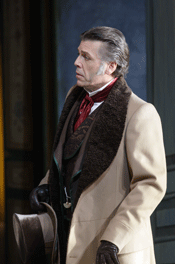 Thomas Hampson as Giorgio Germont
Thomas Hampson as Giorgio Germont
A frisson went through the audience when Fleming made her
glittering entry, sweeping into the sumptuous, somewhat crowded, salon where
revellers drifted and twirled around the sparkling ice-sculpture. But the
audience were made to wait for the trademark golden, floating tone: Fleming was
rather restrained and hesitant, holding back throughout the first act,
negotiating rather than relishing the demands of the coloratura fireworks in
‘Sempre libera’. She compensated for her musical caution with
exuberant dramatic gestures, flinging back the doors of the salon to hurl her
words contemptuously at those who judge her, tossing ice defiantly around the
room, and coughing loudly to foreshadow her demise. Fleming seemed a little
unhappy with Pappano’s tempi and, surprisingly, her voice lacked depth
and beauty in places, but she relaxed in the subsequent act and the audience
were rewarded for their patience with singing of outstanding, velvety warmth,
poise and pathos. Fleming moved effortlessly between soaring pianissimi and
impassioned exhortations: as satisfying a demonstration of the meaning of
bel canto as one could wish for.
A dilapidated mirror leaning haphazardly against the flaking wall, cast a sombre shadow over the now-bare stage for the famous death scene. Singing with sublime beauty and tender radiance, Fleming held the audience spellbound. ‘Prendi: quest’è l’immagine’, in which Violetta selflessly frees Alfredo to love another, was exquisitely poignant. Sadly, however, the final moments jarred somewhat. Violetta’s momentary resurgence of physical health, a false respite from suffering, was cleverly illuminated with a surge of light as Fleming sang ‘Rinasce’ (‘I'm reborn’), accompanied by a rising scale of pulsing urgency. But, rather than simply collapsing, overcome and exhausted by the intensity of this moment of joy, Fleming rushed around the room, grasping each astounded onlooker and informing them individually of her recovery. Then she fell to the floor, dead. This was an unfortunately anticlimactic end to an otherwise superb interpretation.
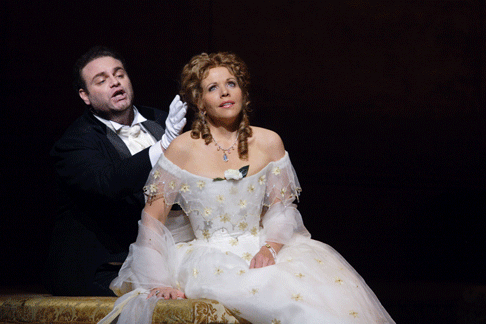 Joseph Calleja as Alfredo Germont and Renée Fleming as Violetta Valéry
Joseph Calleja as Alfredo Germont and Renée Fleming as Violetta Valéry
Fleming’s partner, in the role of Alfredo, was the Maltese tenor, Joseph Calleja. He more than matched her musical mastery. Possessing a sweet, smooth voice, he sustained an Italianate warmth and took the Alfredo’s rigorous cabaletta, ‘O mio rimorso’, in his stride, although surprisingly he offered us only one verse. Calleja is not a natural actor, and the chemistry between him and Fleming was lacking in potency, but he inhabited the role with increasing conviction as the opera progressed, and in Act 2 his anger and bitterness were truly shocking as he hurled his gambling winnings at Violetta.
There was no weak link among the central trio. As Germont - the bourgeois father who disapproves of his son’s paramour - Thomas Hampson commanded the stage, immediately establishing his stern authority. He used his flexible baritone in his second-act aria, ‘Di Provenza’, to reveal the hypocrisy of this domineering emblem of wealth and respectability and his domineering cruelty — he brutally pushes Alfredo to the ground - while also hinting at the genuine regret which troubles his soul.
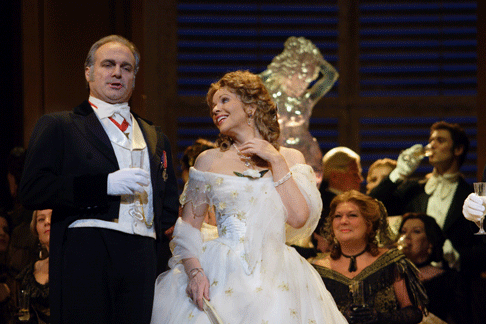 Eddie Wade as Baron Douphol and Renée Fleming as Violetta Valéry
Eddie Wade as Baron Douphol and Renée Fleming as Violetta Valéry
This stunning triumvirate put every ounce of energy, focus, musicality and dramatic commitment to their task. And they were supported by some fine singing by Jette Parker Young Artists present and past in the minor roles, Monika-Evelin Liiv (Flora), Kostas Smoriginas (Marquis D’Obigny) and Haoyin Xue (Gastone de Letorières). As Annina, Sarah Pring was dramatically feisty and musically sure. The chorus, too, were in typically fine form, most notably in the Act 2 gambling scene — stunningly lit from above in complementary reds and greens — where the gypsy girls frolicked and cavorted on the enormous green baize gambling table, while matadors strutted and postured, entertaining the dissolute guests with wild abandon.
Offering a near-prefect reading of the score, Antonio Pappano gave the cast eloquent support. The expressive dynamic range he drew from his players, enlivened even the most mundane accompanying figures, powerfully colouring the words. He coaxed a rich display of expressive hues from the members of the orchestra, especially the superb clarinet solo which accompanies Violetta’s letter writing in Act 2, where the instrument’s innate variety of timbre perfectly conveyed her inner conflict and instability. The Prelude was simply stunning: delicate, scintillating strings commented on sepia projections of times past, images which anticipate the picture that Violetta will present to Alfredo just before her death.
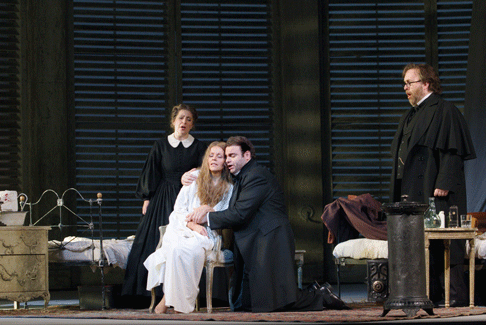 Scene from Act III — Sarah Pring as Annina, Renée Fleming as Violetta Valéry, Joseph Calleja as Alfredo Germont and Richard Wiegold as Doctor Grenvil
Scene from Act III — Sarah Pring as Annina, Renée Fleming as Violetta Valéry, Joseph Calleja as Alfredo Germont and Richard Wiegold as Doctor Grenvil
The catastrophic première of La Traviata at La Fenice in 1853 has entered the annals of infamous operatic disasters. During rehearsals, the librettist, Piave, had written to the Fenice management that the composer ‘insists with renewed firmness that to sing Traviata one must be young, have a graceful figure and sing with passion’. Fleming certainly ticks all the boxes. Her Violetta Valéry is neither angelic paragon of innocence or knowing schemer, but rather a high-spirited young woman of noble heart and pure soul whose self-contempt and fear of risking love win our sympathy and, ultimately, our tears and love.
Claire Seymour
image=http://www.operatoday.com/Fleming_Violetta_ROH.gif image_description=Renée Fleming as Violetta Valéry [Photo by Catherine Ashmore courtesy of The Royal Opera House] product=yes product_title=Giuseppe Verdi: La Traviata product_by=Violetta: Renée Fleming; Alfredo Germont: Joseph Calleja; Giorgio Germont: Thomas Hampson; Baron Douphol: Eddie Wade; Doctor Grenvil: Richard Wiegold; Flora: Monika-Evelin Liiv; Marquis D'Obigny: Kostas Smoriginas; Gastone: Haoyin Xue; Annina: Sarah Pring; Servant: Jonathan Coad; Giuseppe: Neil Gillespie; Messenger: Charbel Mattar. The Royal Opera. Conductor: Antonio Pappano. Director: Richard Eyre. Designs: Bob Crowley. Performance of Monday 22 June 2009. product_id=Above: Renée Fleming as Violetta ValéryAll photos by Catherine Ashmore courtesy of The Royal Opera House
June 25, 2009
The Lowry strikes not of discord over Royal Opera House in Manchester Lowry Centre
By Ben Hoyle [Times Online, 25 June 2009]
Plans for a £100 million outpost of the Royal Opera House in the North West suffered a potentially serious setback yesterday when one of Manchester’s leading arts complexes said a new opera house in the city would “destroy” it.
Ligeti’s Le Grand Macabre shocks Rome but only mildly
It is also one of the contemporary operas most frequently performed in Europe. Ligéti composed two different versions of Le Grand Macabre — the former had its debut in Stockholm in 1978, the latter in Salzburg in 1997. The main difference is that the second version replaces almost all the spoken parts with recitative. The production at the Teatro dell’Opera di Roma (June 18-23) is a world-wide affair. It started in Brussels a few months ago. From the Italian capital it will travel to Sidney, Australia. In the fall, it will have a long spell at the English National Opera in London and at the Liceu in Barcelona. It might go on to the US and other major European opera houses in 2010.
It is a grand, and very costly, production organized by the Catalan Group La Fura dels Baus , now very trendy — the Group has staged the entire Ring in Florence and Valencia; and it is booked by La Scala for a new production of Tannäuser, which will also be shown in Berlin and other major houses.
Le Grand Macabre reaches Rome with a reputation of scandal and even perversion. In January-February, the Brussels performances were well received by the audience but a few reviewers — including The New York Times — wrote about “debauchery” on stage. The new management of the Teatro dell’Opera advertised that the production is “for an adult audience”. At the opening nights, there were a few boos at some sexually explicit moments in the opera (in particular in the second scene of the first act) but the audience did not seem shocked. If it did, it was a very mild shock. Rome has been for centuries the Babylon of Europe and is accustomed to almost everything. There were several curtain calls, but (as it is often the case when a modern opera is on stage) a few rows and many boxes were empty.
Let us place Le Grand Macabre in its proper context. In his own comments to the second version of the opera, Ligéti said that he initially intended to compose a singspiel, but eventually he wrote a full opera because, among other things, it is difficult to find singers equally good at singing, acting and dancing. He also clarifies that, as a Hungarian, he was well-acquainted with operetta. Finally, his main operatic sources of inspiration were Monteverdi’s L’Incoronazione di Poppea and Verdi’s Falstaff. In short, even though Le Grand Macabre requires a huge orchestra and ten soloists, Ligéti thought of something light (the duration of the two acts is around 100 minutes) and very ironic. There are quotations from Verdi, Donizetti, Stravinsky, Mozart and, of course, Monteverdi in both the vocal and the orchestral score, which add irony to an otherwise late 20th century musical work (it is influenced by both the German Darmstadt School and the French ICRAM School. Along with numerous rhythmic orchestral passages, “declamation” slides easily into “arioso” and “duets”.
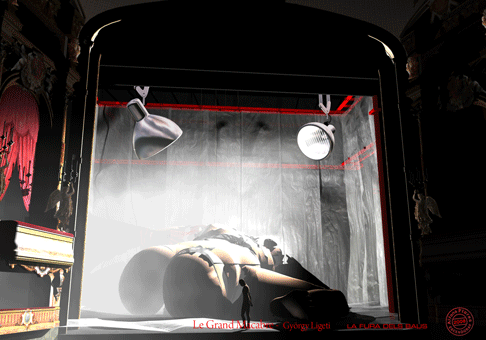
Irony also arises in the text. Based on a Belgian play, it is an allegory. In Bruegeland (a country based on Bruegel’s paintings), an asteroid is about to destroy every living thing on the planet. As the news breaks that death is near, the reaction of the populace is extreme sex (from the adolescent sex of a vigorous couple of teen agers to sadomasochistic sex of the Court’s astrologist and his wife). A few take up drinking, instead. The second part takes place in the corridors of power. As death arrives, intrigue and deception become pointless. Rather, it is better to join all in a crazy dance (a wild 15th century “ciaccona”). Mr. Death is expected to do all the killing and all the destroying, but finds more fun in joining the humanity in extreme sex and wild dancing . Thus, Bruegeland’s last day is postponed, perhaps forever.
In my opinion, La Fura dels Baus uses a very heavy hand in the stage production that clashes with Ligéti’s sophisticated and elegant score. The stage is dominated by a huge statue of woman in progressive decomposition where the characters come out from very private parts of her body. Irony does not seem to be a gift of the Catalan Group, even though, thanks to Ligéti’s music, it is manifest in the second part (especially in the “ciaccona”).
The orchestra responds extremely well to Zoltán Peskó’s conducting. Peskó is a compatriot and long-time friend of Ligéti. He is thus, fully equipped to show all the delicate nuances of the score. Chris Merritt has completed his transition from Bellini and Rossini coloratura belcanto to a high baritone for 20th century works. Brian Asawa is the best countertenor now available world-wide. Sir Willard White is as imposing as ever. Nicholas Isherwood is a master of early British music where it is quoted in the score. Caroline Stein is now a veteran of the double role a sensual Venus and a cynic Gepopo. Ning Liang is a vicious Nescalina. Annie Vavrille and Ilse Eerens are just delightful as the amorous teenagers.
Giuseppe Pennisi
image=http://www.operatoday.com/grand_macabre_01.gif image_description=A scene from Le Grand Macabre product=yes product_title=György Ligéti: Le Grand Macabre product_by=Piet the pot: Chris Merritt; Amando: Annie Vavrille; Amanda: Ilse Eerens; Nekrotzar: Sir Willard White /Roberto Abbondanza; Astradamors: Nicholas Isherwood; Mescalina: Ning Liang; Venus: Caroline Stein; Prince Go-Go: Brian Asawa; White Minister: Eberhard Francesco Lorenz; Black Minister: Martin Winkler; Gepopo: Caroline Stein. Orchestra e Coro del Teatro Dell’opera. Maestro concertatore e Direttore: Zoltán Peskó. Maestro del Coro: Andrea Giorgi. Ideazione: Alex Ollè (La Fura dels Baus) & Valentina Carrasco. Regia: Alex Ollè. product_id=Above: A scene from Le Grand MacabreAspen Music Festival goes back in time
Stewart Oksenhorn
[The Aspen Times, 25 June 2009]
It was 60 years ago this summer that the Goethe Bicentennial came to town, and there is good reason to celebrate the anniversary of that momentous event. The Bicentennial spawned the Aspen Institute, the Aspen Music Festival and School — and, oh yes, the modern rebirth of this sleepy, former mining town.
SCHUBERT: Alfonso und Estrella
Some might vote for Bizet’s Les Pecheurs de Perles, which has tunes so magnificent that they help to mitigate against a hopeless libretto, enticing companies to stage the opera from time to time. A somewhat more obscure candidate could be Howard Hanson’s Merry Mount - the suite from which sweetens the playlist of many a classical radio station. Naxos has released both the original Metropolitan Opera broadcast from the 1930s, in very poor sound, and a more recent concert recording, with Gerald Schwartz conducting. In both, the music engages while the drama distracts.
Now Naxos’s series of operas on DVD presents another possibility for that lamentable title: Franz Schubert’s Alfonso und Estrella, composed to a libretto by Franz von Schober. The score can’t be said to boast any of Schubert’s immortal melodies, but it has some fine ones nonetheless. Arias, duets, trios, ensembles - the score may be a crazy quilt of “pieces,” but each in itself is tuneful and evocative. Nikolaus Harnoncourt is not always the most stylish of conductors, but he has a flair for Schubert, especially the dramatic minor-key passages, as well as the more rhythmically exciting passages. He leads the Chamber Orchestra of Europe in an excellent performance.
The singers get caught in the middle, with such fine music to sing and such dopey drama to enact. Director Jürgen Flimm gives the drama every opportunity to succeed. On Erich Wonder’s dark, atmospheric set, the singers move about as if actually motivated by recognizable human emotions. But the story is simply too thin and predictable. An exiled king worries over his noble son, who is in love with a woman who just happens to be the daughter of the man that deposed her lover’s father. It all ends in a sanctimonious bout of forgiveness and redemption, vaguely recalling Beethoven’s Fidelio. A clumsy translation doesn’t help matters for the non-German speaker. One example will serve: “Monster! Ha, avaunt!” Avaunt to be alone.
Recorded in 1997 at the Vienna Festival, the singers are all in fine, fresh voice. Made up as an old man, Thomas Hampson lays on the “feebleness” a bit much, but his voice is strong. Olaf Bär sings the “bad” king without letting his nefariousness mar the musical line. As the young lovers, Luba Orgonasova and Endrik Wottrich are attractive both vocally and personally.
Once seen, viewers may not be interested in returning to Alfonso und Estrella as a music drama. However, such are the pleasures of its score that this DVD is well worth considering, if no other opportunity can be found for enjoying its music.
Chris Mullins
image=http://www.operatoday.com/Naxos2-110260.gif imagedescription=Franz Schubert: Alfonso und Estrella
product=yes producttitle=Franz Schubert: Alfonso und Estrella productby=Mauregato: Olaf Bär; Estrella: Luba Orgonasova; Adolfo: Alfred Muff; Froila: Thomas Hampson; Alfonso: Endrik Wottrich. Arnold Schoenberg Choir. Chamber Orchestra of Europe. Nikolaus Harnoncourt, conductor. Jürgen Flimm, stage director. Erich Wonder, set design. Florence von Gerkan, costumes. Filmed at the Theater an der Wien during performances in Wiener Festwochen, May 1997. productid=Naxos 2.110260 [DVD] price=$29.99 producturl=http://www.arkivmusic.com/classical/Drilldown?nameid1=10889&namerole1=1&compid=35838&genre=33&bcorder=195&labelid=19
Resignations, ENO Model, Might Save City Opera: Norman Lebrecht
Commentary by Norman Lebrecht [Bloomberg.com, 25 June 2009]
This is the tale of two city operas, both of which present high art at popular prices.
June 24, 2009
La Traviata in San Francisco
Even the critical intention of finding the positive and ignoring the well publicized negatives of the production endured only through the first act (overheard intermission comments “she seems very organized,” “I’ve seen worse”).
The second act, a Verdi masterpiece, was rendered nonsensical, the storytelling eviscerated — Violetta flippant, Germont deadly cold, Alfredo happen chance. Flora’s party was the occasion of an extended ballet of the sort that makes audiences laugh. Violetta’s death was enacted in the heavens, possibly a reference, maladroit, to the Eurydice myth.
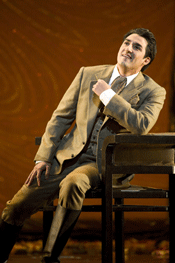 Charles Castronovo as Alfredo [Photo by Terrence McCarthy courtesy of San Francisco Opera]
Charles Castronovo as Alfredo [Photo by Terrence McCarthy courtesy of San Francisco Opera]
If there was ever any theatrical integrity to this production it had
evaporated in this strange encounter of Russian soprano Anna Netrebko, a superb
singer and a very particular artist, with the wife of Placido Domingo. Clearly
there was no connection between the emotional immediacy projected by Mme.
Netrebko, her dramatic delivery of text that was high Monteverdi in its
directness and intensity, and the stylized, content-less staging perpetrated by
Mme. Domingo.
Mme. Netrebko was in fine form for the June nineteenth performance, the third of her five performances (Elizabeth Futral takes a further three performances, Ailyn Perez one more). Her voice filled the theater with an unusual volume and richness, pitch precision sometimes subjugated to declamation in infinite tonal and rhythmic colorations. It may be noted that she did not take the ‘Sempre libera’ high E-flat, nor did she open the traditional cuts in ‘Ah, fors’é lui’ or her ‘Addio del passato’.
Mme. Netrebko nearly met her match in American tenor Charles Castronovo who brought urgency, voluptuously sculpted text delivery, beauty of tone and a handsome stage presence to this Verdi tenor, though like all of them prototypically unlikeable.
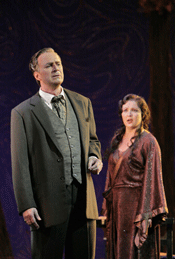 Dwayne Croft (Giorgio Germont) and Anna Netrebko (Violetta Valéry) [Photo by Cory Weaver courtesy of San Francisco Opera]
Dwayne Croft (Giorgio Germont) and Anna Netrebko (Violetta Valéry) [Photo by Cory Weaver courtesy of San Francisco Opera]
Dwayne Croft, père Germont, possesses a fine instrument that he uses with
great care, and with commendable musicality. Though naturally commanding his
stage presence and musicianship paled in his confrontations with Violetta and
his son when it needed the immediacy and authority to confuse their youthful
impulses.
Reveling in this charged musicality erupting from the stage conductor Donald Runicles melted into a rapport with the stage that is all too rare in opera, and when it occurs sublime music is sometimes heard. Mo. Runnicles’ mannered tempi and phrasing were elaborated by those mannerisms of his not particularly Italianate soprano and tenor, and tempered by the stylistic cleanliness and musical purity of his baritone. Finally the weeping minor seconds of Violetta’s death rang incisively, with a final agogic [a slight withholding of the beat] choke from the throbbing violins — representative of the Runnicles mannerism catalogue.
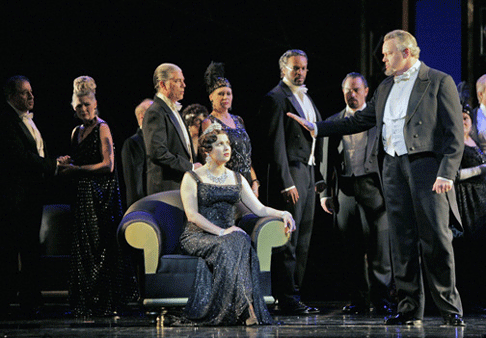 Anna Netrebko (Violetta Valéry) and Dale Travis (Baron Douphol) [Photo by Cory Weaver courtesy of San Francisco Opera]
Anna Netrebko (Violetta Valéry) and Dale Travis (Baron Douphol) [Photo by Cory Weaver courtesy of San Francisco Opera]
It could have been thrilling indeed, this death, had the stage moved in concert with the Verdi poetic. Mme. Domingo imposed the forms of the roaring twenties, a metaphor that does not seem to match the atmospheres of this mid-nineteenth century morality play, perhaps because art nouveau lines are overwhelmingly sensual, and flashing, reflective surfaces too sexually forceful. Finally La Traviata is a simple story of family life that easily disappears in fanciful images (three ballerinas floated onto the stage to drape Violetta in a bridal gown during the death scene, as one of many examples).
As this review is for Opera Today and not the Harvard Business Review the focus is on the art of opera, not the art of business. Perhaps an evaluation of the business of opera as reflected in this Traviata and last week’s Tosca would validate some of the artistic choices, and one hopes, result in more positive terms. Otherwise there can be no point to San Francisco Opera’s summer season.
Michael Milenski
image=http://www.operatoday.com/TMact1_0085.gif image_description=Anna Netrebko as Violetta [Photo by Terrence McCarthy courtesy of San Francisco Opera] product=yes product_title=Giuseppe Verdi: La Traviata product_by=Violetta Valéry: Anna Netrebko / Elizabeth Futral (6/29, 7/2, 7/5) / Ailyn Pérez (7/1); Alfredo Germont: Charles Castronovo / David Lomelí (6/29, 7/2); Giorgio Germont: Dwayne Croft / Stephen Powell (6/29, 7/2); Flora: Leann Sandel-Pantaleo; Gastone: Andrew Bidlack; Baron Douphol: Dale Travis; Marquis D’Obigny: Austin Kness; Grenvil: Kenneth Kellogg; Annina: Renée Tatum; Giuseppe: Dale Tracy; Messenger: Bojan Knezevic; Flora’s Servant: William Pickersgill; Matador: Jekyns Pelaez. San Francisco Opera. Conductor: Donald Runnicles / Edwin Outwater* (7/5). Director and Designer: Marta Domingo. product_id=Above: Anna Netrebko as Violetta [Photo by Terrence McCarthy courtesy of San Francisco Opera]MAHLER: Symphony no. 8
While Mahler’s music is heard with increasing regularly in the latter part of the twentieth century, his works were not completely ignored after World War II. Yet recordings of his symphonies were rare, especially when it comes to something as demanding as the Eighth. The Hamburg performance on this recent Gala CD dates from that time, which is just after Leopold Stokowski recorded the Eighth in 1950. Led by the composer-theorist Winfried Zillig (1905-63), this performance is a fine effort, which stands well when compared to other recordings of the time. The soloists are suited to the task and include a young Herman Prey and youthful Franz Crass; the choruses worked well together in a nicely blended sound. And if there is a weakness it is in the orchestral sound, which falls short at times. The first section of the Eighth, “Veni Creator Spiritus,” is nicely paced and the modest tempos allow for a sense of clarity to emerge. Yet those familiar with the score will find some awkward transitions and, unfortunately, a disappointing ending to the movement. The abrupt cutoff does not fit the style, sounding more tacked on than conclusive.
The second part, the setting of the conclusion of the second part of Goethe’s Faust is similar in concept. The opening section seems louder and more direct than indicated in the score, with the chorus of anchorites more prominent than later conductors might allow. Some of the other passages are well sung, but on the whole, the performance seems to be an accumulation of sections. Yet among those sections, the solo of the Pater Ecstaticus “Ewiger Wonnebrand” receives a notable and impassioned reading by Prey. Elsewhere, the tempos sometimes drag, with some uncharacteristic results in the section “Ich spur’ soeben,” a point where the solo tenor interacts with the chorus. A similar situation occurs later in the passage “Bei der Liebe,” in which the tempos flag at the expense of building toward the concluding section. It is unfortunate, though, that the final section of the second part occurs on the second disc and does not continue from the music which precedes it. While other conductors might shape the phrases differently, the Zillig does bring the performance to a satisfying conclusion. In some places the instrumentalists seem a bit taxed, but the solo voices and, especially, the chorus sustain the intensity implicit in the score.
In addition to the Eighth Symphony, this recording includes a performance on 19 August 1951 by the baritone Dietrich Fischer-Dieskau of Mahler’s cycle Lieder eines fahrenden Gesellen with the Vienna Philharmonic led by Wilhelm Furtwängler at the Salzburg Festival. This recording shows Fischer-Dieskau to fine effect with music he return to at various times in his lengthy career. Here, the involvement of Furtwängler is also of interest in a vivid recording of this familiar work. Also included is a slightly later performance by Fischer-Dieskau of Mahler’s Kindertotenlieder with the NDR-Sinfonieorchester conducted by Hans Schmidt-Isserstedt on 6 June 1955. The two-disc set also includes Hugo Wolf’s Gesänge des Harfners sung by Herman Prey and also accompanied y the NDR-Sinfonieorchester led by Schmidt-Issersted from 13 September 1955. A bonus is the inclusion of Hans Werner Henze’s Fünf Neapolitanische Lieder from 19 September 1956 (again with the NDR-Sinfonieorchester and conducted by Schmidt-Isserstedt).
As important as the Mahler recordings are to document the composer’s reception at a time when his music needed champions to bring it to performance, they also represent the work of two major German singers, Prey and Fischer-Dieskau, who would become some of the most important voices of their generation in the decades that followed. At the same time, the efforts of the Schoenberg student Winfried Zillig are preserved in this rare recording of the Eighth. At a time when Mahler’s works were rarely heard, it is reassuring to know of the efforts to perform one of the composer’s more demanding scores.
James L. Zychowicz
image=http://www.operatoday.com/Gala100806.gif imagedescription=
product=yes producttitle=Gustav Mahler: Symphony no. 8; Lieder Eines Fahrenden Gesellen; Kindertotenlieder. Hugo Wolf: Gesänge des Harfners. Hans Werner Henze: Funf Neapolitanische Lieder. productby=Annelies Kupper, soprano; Ilona Steingruber, soprano; Dorothea Förster-Georgi, soprano; Maria von Ilosvay, contralto; Ursula Zollenkopf, contralto; Lorenz Fehenberger, tenor; Herman Prey, baritone; Franz Crass, bass. Knabenchor der Oberschule Eppendorf. NDR-Sinfonieorchester und Kolner Rundfunkchor/Winfried Zillig productid=Gala 100806 [2CDs] price=$15.49 producturl=http://www.arkivmusic.com/classical/Drilldown?nameid1=7537&namerole1=1&compid=1806&genre=66&bcorder=195&labelid=262
A Masked Ball by Brooklyn Repertory Opera
Agreeable — and surprising — to find that several other shoestring companies are flourishing, despite these bad financial times, and that venues pop up in the unlikeliest parts of town — well, the rent is lower if the address is stranger.
The Brooklyn Lyceum, for example, is a 1910 public bathhouse on Fourth Avenue at President Street — they used to call it Flatbush, and now the rebuilders say “Lower Slope,” but for many decades the plain between the Brooklyn Academy of Music and Greenwood Cemetery was several miles of vacant. Today it is reviving, there are tidy homes and restaurants, and you can stroll by night and jitter-free. The Lyceum, tattered brick and the remains of tile, contains a performing space about the size of a basketball court — you could fit a dozen Amatos there — on a stage built over the former pool. The look recalls the BAM Harvey (which was left to look that way on purpose), but the stairs aren’t so steep at the Lyceum and the bathrooms far easier to find. I strolled by one recent day for the last of Brooklyn Repertory Opera’s four performances of Verdi’s A Masked Ball — Brooklyn Rep always performs in English — and I was delighted I had done so.
Full disclosure: The company prima donna, Kathleen Keske, is an old friend whose voice I have admired in such roles as Weber’s Rezia but had not heard in several years. I was eager to hear her Amelia, and she assured me the rest of the cast was good. I had misgivings — I’ve been to a lot of these little companies across the years — sometimes thrilled, sometimes appalled. You never know. And Ballo is tricky, five big roles and intricate orchestration. (Most such companies use a piano or two — not Brooklyn Rep.)
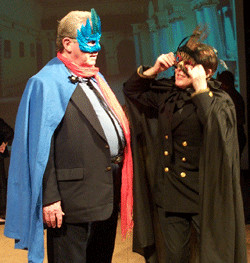 Pamela Scanlon as Oscar and Francis Liska as Riccardo
Pamela Scanlon as Oscar and Francis Liska as Riccardo
To my delighted surprise, the cast was solid, mature enough for Verdi, and
eager to sing out; the orchestra, under Stephen Francis Vasta, professional and
clear, making Verdi’s points. The chorus was on the small side, and
overly weighted towards ladies, but costs were really cut on sets (mostly
projections of the royal palace in Stockholm) and costumes, haphazard at best.
The wince-making translation was uncredited in the program — I
wouldn’t admit to it either. (But I found I could shut my eyes and think
of the Italian, and let the voices carry the show.)
I’m delaying things: To my regret, Keske was not at her best in this role. Amelia has two personalities, the defeated subject of domestic tragedy and the full-throttle Verdi passionista; Keske did not possess the weight or the well-supported power for those grand arching phrases. In her quiet aria, however — the one that, in Italian, begins “Morrô, ma prima in grazia” — she sang with well-placed tone and great feeling for a woman in despair, facing with resignation the loss of everything dear to her.
The other soprano, the boy Oscar, was sung by Pamela Scanlon, whose strong, bright soprano and clear, certain coloratura impressed me as a voice ready to tackle Violetta and likely to give a good account of it. Her acting, as called for by this trouser role, was on the cute side — but not a garish, gender-mocking space alien, as in the current Met production. Riccardo — promoted to king here but not Swedished as Gustav — was sung by Francis Liska, with a graceful lyric line and the right air of narcissistic indifference to the deep emotional waters in which he treads. Charles Karel sang Renato with a sturdy, genuine Verdi baritone, warm, heartfelt and — ultimately — grim.
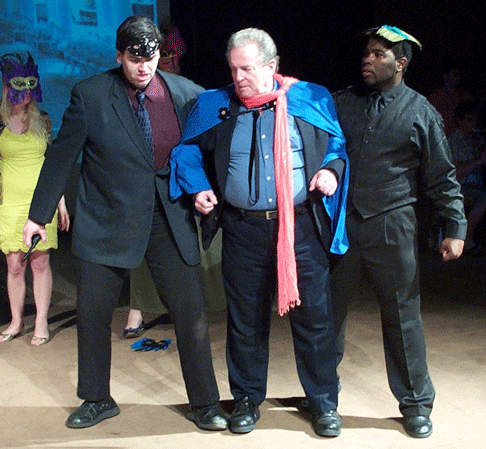 A scene from A Masked Ball
A scene from A Masked Ball
Then out came Ulrica — you know — the fortune teller — the Marian Anderson/Ewa Podles role. Already there had been intimations of surprise, in references in the first scene, to a “magician” named “Ulrico.” (Why not just Ulrich?) I seized the program and, staggered, read the name: Nicholas Tamagna. “You sprang that on me! You didn’t warn me!” I later accused Madame Keske, who smiled. “Would you have come if I’d told you?” “Maybe not.” “And did you like him?” she went on smiling.
Mr. Tamagna, a countertenor who usually sings roles like Orfeo (last April at the Brooklyn Rep, sorry I missed it) and Handel’s Cesare (in D.C. in the fall), earned his Book of World Records (and Wikipedia) moment as the first man ever to sing this diehard mezzo role in a full performance of Verdi’s opera. A slim figure with a shaven head and satanic contact lenses, he sang it all — in a room of considerable size, remember — in a seamless top-to-bottom alto with no hootiness, no doubtful support, loud as anyone (and everyone) else in a healthy cast, the phrases as beautiful as their eldritch import allowed. (Verdi didn’t want his witches to sound too beautiful, you know.) It was a totally astonishing performance, and in five minutes conquered what reservations I had — and I’m a stickler for certain traditions. Tamagna’s has an alto in which I wished to bask.
But the joy of the entire afternoon was being in a big room where big, healthy voices were singing big, healthy Verdi — up close, full throttle, no electronics, no cutting corners. Pleasure of operatic caliber. This is not lip-service lyric but a company that knows what it’s doing.
John Yohalem
image=http://www.operatoday.com/liska-keske-ball.gif image_description=Kathleen Keske as Amelia and Francis Liska as Riccardo [Photo courtesy Brooklyn Repertory Opera] product=yes product_title=Giuseppe Verdi: A Masked Ball product_by=Amelia: Kathleen Keske; Oscar: Pamela Scanlon; Ulrico: Nicholas Tamagna; Riccardo: Francis Liska; Renato: Charles Karel, Sam: Ilberto Lagana; Tom: Ernest McCoy. Couducted by Stephen Francis Vasta. Brooklyn Repertory Opera, performance of June 14. product_id=Above: Kathleen Keske as Amelia and Francis Liska as RiccardoAll photos courtesy of Brooklyn Repertory Opera.
Saint Louis: Reliably Excellent
There. I said it. Let the Glimmerglasswegians and the Santa Fesions rail and fuss, but OTSL has really got the whole package together: top quality musical offerings, exciting young singers well on the road to major careers, well-considered theatrical stagings that rival any major house (any), and an extra-musical ambiance that is just about unbeatable. Approaching the house through the lawn area profuse with candle-lit tables, free to any pre-show picnickers who care to use them, and being able to stay after the show to party, applaud, and mingle with the artists in the large Fest tent, well, it is sort of Glyndebourne without the ‘tude.
Add to the mix the fact that this troupe has consistently performed their repertoire in English, in a small house that fosters great immediacy of the theatrical experience, at competitive prices, and, good God, it is 'popular' opera! (Even when the title is not of the bread-and-butter variety). True, the Loretto Hilton lobby is cramped on SRO evenings but. . .there is always a stroll available on that candle-dotted lawn.
My recent visit found this resourceful company in its usual fine artistic form, beginning with as enchanting a production as I imagine possible of Mozart’s Il Re Pastore (The Shepherd King).
Wolfgang’s youthful (he was nineteen) work is set to a much-used libretto by Metastasio, and is of the formulaic opera seria vintage. You know, the kind that can be dead boring no matter how well it is performed. Not so here, thanks to a wholly winning, and dramatically truthful production directed by Chas Rader-Shieber.
For Mr. R-S has imagined it as a sort of Upstairs Downstairs episode with high notes, set in an English country house in a prior century, where a wealthy young woman and her fiance are hosting another well-to-do couple for a visit. After perusing the actual score of Re in this setting, our heroine becomes committed to the group’s enacting the story as the day’s entertainment, assigning roles to not only the other society figures, but also to the bustling servants.
This giddy, play-acting atmosphere yielded impressive results, not only in filling the story with meaningful (and not distracting) stage business, but also allowing for emotional honesty and invention in the many (usually) static set pieces of this genre. It did not hurt that David Zinn’s set was one of the most beautiful I can recall on this St. Louis stage, impeccably dressed. Nor that Robert Perziola’s classy costumes spoke volumes in defining the character relationships, and clarifying plot absurdities, including one drop-dead-gorgeous beaded gown for “Arminta.”
But all this technical brilliance would have been for naught without a top notch cast, and this, too, OTSL delivered in spades. The Gerdine Young Artists development program is a model of its kind, and this investment obviously pays off handsomely as four of the five soloists are former participants.
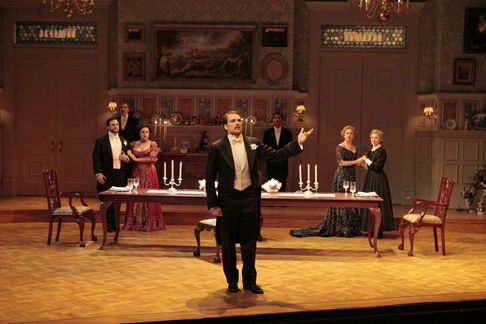 L to R (foreground): Paul Appleby as Agenore, Daniela Mak as Tamiri, Alek Shrader as Alexander, Heidi Stober as Aminta, and Maureen McKay as Elisa in Il Re Pastore
L to R (foreground): Paul Appleby as Agenore, Daniela Mak as Tamiri, Alek Shrader as Alexander, Heidi Stober as Aminta, and Maureen McKay as Elisa in Il Re Pastore
Heidi Stober was radiant as the young affianced woman who is compelled to impersonate the Shepherd King Arminta and enact his plight. Her ample, well-schooled, warm lyric soprano blossomed especially above the staff, and her stage demeanor served up a generous helping of star-quality. Miss Stober was well partnered by her “betrothed,” the tenor Alek Schrader, pressed into duty to play the emperor Alexander. Mr. Schrader has an exceptionally pleasing Mozartean timbre, and his bravura rapid-fire melismatic phrases were heart-racingly delivered.
My favorable impression of Maureen McKay in last summer’s Un Cosa Rara was here confirmed with a securely sung Elisa, a maid who briefly enjoys enacting the longings of a noblewoman. Miss KcKay is capable of regaling us with accurate cascades of fioritura, likewise deploying her crystal clear tone in melting legato phrases. Her spunky stage savvy is equally bewitching. Paul Appleby has fewer fireworks to negotiate in the role of Agenore (advisor to Alexander, in love with Tamiri), but he sang with style and panache. As Tamiri, Daniela Mack complemented her cast mates with her slightly darker rich tone and attention to every musical detail. All five offered fine English diction, coached on this occasion by soprano Erie Mills.
In the pit, conductor Jean-Marie Zeitouni discovered all the youthful spirit and buoyant lyrical possibilities in the score (after a bit of a slack rhythmic start in the first few bars), and there was wonderful solo instrumental work as well throughout the evening. His conscientious partnering of the singers seemed to free them to soar through this youthful-but-challenging work.
The baton was successfully passed the very next night to another conductor whose stock is rising, Michael Christie, who helmed a musically rich reading of The Ghosts of Versailles, by John Corigliano, libretto by William M. Hoffman. After a sensational debut at the Metropolitan Opera in the early 90’s which was followed by several other revivals in major houses, Ghosts languished, largely (it is believed) owing to the lavish original designs, and massive instrumental and vocal forces required.
At St. Louis, the production team and composer have sought to down-size the piece to make it more accessible to smaller opera companies. As evidenced here, they have been largely successful in their attempt. Corigiliano is a brilliant orchestrator, and his original score took full advantage of the huge pit and full band of the Met. Here, Ghosts was re-scored in a new performing edition commissioned by OTSL and executed by John David Earnest. It was quite a successful trade-off, and much variety and color remained, many times (favorably) suggesting the smaller scores of Benjamin Britten. While the instrumental presence was almost always ample, there were a few climactic moments that seemed a mite under-powered, not least of which was the very final sting of Act One. These minor quibbles aside, this was a very fine re-working of the piece, that retained its musical integrity.
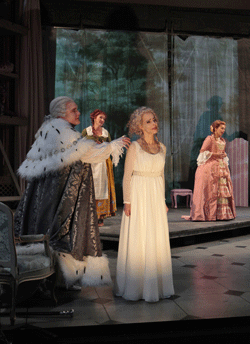 Kevin J. Glavin as Louis XVI and Maria Kanyova as Marie Antoinette with (at rear l. to r.) Dorothy Byrne as Susanna and Hanan Alattar as Rosina in The Ghosts of Versaille
Kevin J. Glavin as Louis XVI and Maria Kanyova as Marie Antoinette with (at rear l. to r.) Dorothy Byrne as Susanna and Hanan Alattar as Rosina in The Ghosts of Versaille
We were equally fortunate with the physical production, directed by James Robinson, with sets by Allen Moyer, costumes by James Schuette, and most important, highly evocative video projections by Wendall K. Harrington. As we entered the auditorium, we discovered the theatre at Versailles, on stage, being refurbished by a contemporary restoration crew in blue jump suits. That image segued into the arrival of the ghosts, attired in lavish period costumes, and superb wigs/make-up by Tom Watson (a company treasure, he). The first notes of the score sounded, sans the usual conductor’s entrance, and the lighting melded into disorienting video work that transported us to the deserted stage of long ago, “beyond time” as the program noted. It should be said that Paul Palazzo provided the uncommonly fine lighting designs for both evening’s performances.
One element of the work that resisted diminution was the large cast demand. It took a village to get this work up, and there was great depth in the entire cast largely thanks (again) to the company’s young artists, who also formed the chorus under Sandra Horst’s direction. I did find that the dancers contributed less to the overall dramatic experience than they might have, and elimination of the dance corps might be a possible further cut-back. The stage got crowded at times, although Mr. Robinson not only managed the traffic well, but focused the important dramatic moments and developed believable characters and strong relationships.
Without creating a laundry list, it is hard to single out all who were excellent in this large ensemble cast. Certainly expectations were high for Maria Kanyova (another former apprentice) as Marie Antoinette, and she did not disappoint. Ms. Kanyova has a responsive soprano, with a hint of metal that stands her in good stead in dramatic segments, but she can also scale her voice down to float effective pianissimi that veritably float above the staff. She was a worthy successor to the great Teresa Stratas who created the role. Christopher Feigum was suitably winning as Figaro, although in his first big aria all the acting seemed to be external. The internal spark of creation crept in sometime during his (quite funny) Act One finale drag moments as the harem girl and he remained fully engaged for the rest of night. His pliant, smooth baritone gave considerable pleasure and he is a talent to watch.
Mr. Corigliano apparently loves his baritones and he created a fine complementary foil in Beaumarchais, well-taken on this occasion by James Weston. As should be, Mr. Weston has a little more maturity of tone and the bronze patina of his upper register contributed to a very effective contrast. His love for the doomed heroine was wonderfully embodied and his alternately witty and sensitive delivery enabled a well-rounded character to emerge.
As stage characters in the concurrent Figaro comedy, a jewel of an ensemble worked tightly together in a slightly heightened play-acting style. Samuel Read Levine (Leon), Paula Murrihy (Cherubino), Sean Panikkar (Almaviva) were all terrific, with young artist Jeanette Vechhione capturing the most applause for her technically secure stratospheric singing as Florestine. Hanan Alattar and Dorothy Byrne were exquisite in their limpid lyrical outpouring of the extended Act Two duet for Rosina and Susanna, a musical high point.
The real-time bad guys were equally well-served by Lee Gregory, a vocally assured and physically active (and fearless) Wilhelm, and by stentorian, tireless tenor (and fine character actor) Matthew DiBattista as Begearss. Elizabeth Batton did everything possible to amuse us in her star turn as Samira. Originally created for the particular gifts of Marilyn Horne, Ms. Batton made it her own with plummy tone, a well-modulated chest voice, and sound technique in the middle and (ringing) upper reaches. Quite a comedian, she wisely eschewed the baritonal power of Ms. Horne for an equally successful and personalized performance.
If I had to mention only three more performers, I would include the characterful Louis XVI from Kevin J. Glavin, the firm-voiced Marquis of Kevin Park, and the delightful Woman with Hat sung by Erin Holland.
Upon re-visiting The Ghosts of Versailles I still found it a particularly well-calculated mix of old and new styles, in turn challenging and comfortable, telling a dramatically satisfying and captivating story of fate and acceptance. If I still feel that the arias go on a bit longer than needed to make their musical or dramatic point, they never become uninteresting, especially in the hands of such a capable roster of performers.
This production will go on to fall’s Wexford Festival, and it alone would make it worth the trip to Ireland. It deserves many more performances.
James Sohre
image=http://www.operatoday.com/11_MG_8719a.gif image_description=Alek Shrader as Alexander, Paul Appleby as Agenore, and Daniela Mack as Tamiri (all foreground) with supernumeraries Mark Goff and Elizabeth Zharoff in Opera Theatre of Saint Louis's 2009 production of Mozart's IL RE PASTORE. Copyright: Ken Howard 2009 product=yes product_title= product_by=Aminta: Heidi Stober; Elisa:Maureen McKay; Alessandro: Alek Shrader; Agenore: Paul Appleby; Tamiri: Daniela Mack. Jean-Marie Zeitouni: Conductor. Chas Rader-Shieber: Stage Director. Set Designer: David Zinn. Costume Designer: Robert Perdziola. product_id=Above: Alek Shrader as Alexander, Paul Appleby as Agenore, and Daniela Mack as Tamiri (all foreground) with Mark Goff and Elizabeth Zharoff in Il Re PastoreAll photos by Ken Howard courtesy of Opera Theatre of Saint Louis
June 22, 2009
Schwanengesang at Wigmore Hall
After a searing Die Schöne Müllerin on Monday and a definitive Winterreise on Wednesday, Matthias Goerne and Christoph Eschenbach gave the Wigmore Hall audience yet another reason to feel almost unreasonably privileged on Saturday, with a Schwanengesang of an emotional intensity and technical prowess which it is hard to imagine being equalled.
This is a melancholy, tormented ‘cycle’ in the hands of these musicians, a far cry from the ‘charm’ which some see in the Rellstab settings, and the mood is set in the very first song, with a ‘Liebesbotschaft’ which speaks not of a prettily babbling brook carrying a message of love but of the same stream in which the Miller lad drowns and which is frozen over in ‘Auf dem Flusse.’ Indeed, the sense of a raging torrent beneath the surface pervades this interpretation, the message not one so much of tenderness as foreboding. That same sense of dread hovers over Goerne’s achingly poignant ‘Kriegers Ahnung,’ where the lines ‘Lag sie in meinem Arm’ and ‘Herzliebste — Gute Nacht!’ are delivered with touching sincerity.
‘Ständchen’ is always hard to hear anew, but Goerne and Eschenbach managed to make it sound fresh, the lines ‘In den Stillen Hain herneider, / Liebchen, komm’ zu mir!’ amazingly sung on one breath, the piano’s staccato notes underpinning the sense of disquiet. Even ‘Abschied,’ that grave of many a singer’s hopes of syllabic perfection (of course, Goerne got every one in place) was more of a farewell to life itself than just to a place and the people in it.
The Heine songs were tremendous — I have never heard so tormented an Atlas, or so heartbroken a rejected lover in ‘Ihr Bild,’ the legato line here sustained with quiet intensity and the sense of disbelief at ‘Dass ich dich verloren hab!’ utterly compelling. Similar technical perfection was heard in ‘Am Meer,’ the piano forceful rather than subdued, the voice melting from the solemn grandeur of the beginning to the bitterness of ‘Vergiftet’ at the end.
‘Der Doppelgänger’ was frightening: not only for the sheer fervour of the singing, but the elemental force which seemed to be behind the words, and the command with which they were sung. No one rises to that cruelly exposed high G as this singer does, and no one manages to make that howl of despair so absolutely eloquent, the ensuing ‘Du, Doppelgänger’ phrased with ringing authority. A magisterial performance, followed by one of those silences which speak louder than any applause. ‘Die Taubenpost’ was given as an encore, sung with tenderness and unforced candour, the crucial ‘Sie heisst — die Sehnsucht!’ not isolated but part of the same unaffectedly moving whole. I had thought that his performance with Brendel was as far as anyone could go with these songs, but I was wrong.
It’s always difficult to programme with this work, but here we had a brilliant solution in Schubert’s Piano Sonata D960. Eschenbach has been doing so much more conducting and accompanying in recent years that it’s easy to forget what a highly individual pianist he is — of course, his special quality is akin to Goerne’s in that his interpretations derive from the feeling that rhythm and not metre is the life-blood of music, and that the most sublime music of all is slow — very slow indeed, in the case of the sublime Andante here, taken more Molto adagio to my ears. Naturally I loved every audacious minute, but I can quite see that many would not. Schubert was almost certainly writing this sonata at the same time as he was working on the Schwanengesang settings, and it shares the same wonderful completeness and coherence whilst possessing something given perhaps only to ‘Die Taubenpost’ — a sense of serenity amidst sorrow, brought out wonderfully by Eschenbach’s playing.
Melanie Eskenazi
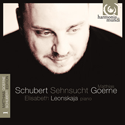 |
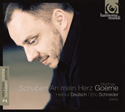 |
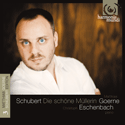 |
| Sehnsucht | An mein Herz | Die schöne Müllerin |
image=http://www.operatoday.com/Goerne-Borggreve038.gif image_description=Matthias Goerne [Photo by Marco Borggreve for harmonia mundi]
product=yes producttitle=Franz Schubert: Schwanengesang, Piano Sonata D960 productby=Matthias Goerne, baritone, and Christoph Eschenbach, piano. Wigmore Hall, London; 20 June 2009. product_id=Above: Matthias Goerne [Photo by Marco Borggreve for harmonia mundi]
June 21, 2009
John McCarthy: Charismatic choral conductor and arranger
Kenneth Shenton [The Independent, 22 June 2009]
During the second half of the 20th century, John McCarthy was perhaps the most charismatic choral conductor of his generation. Highly adept at operating on all sides of the musical divide, amid a career of great length, distinction and influence, he became one of the most powerful and potent figures in British musical life.
Madam Butterfly - English National Opera, London Coliseum
And a worthy tribute it is. This season’s cast is easily the strongest that Minghella’s staging has yet enjoyed here at the Coliseum (it’s a co-production with the Met, and the Lithuanian National Opera). Judith Howarth returned to the title role from the last revival, with a portrayal that has grown in stature since the last time. Her fullish lyric soprano remains a touch on the light side, but gives a real sense of being at one with the orchestra, and picks out the delicacy of the dialogues with Pinkerton and Suzuki; she draws the character with just the right balance of strength and vulnerability.
The two men, both appropriately imported from the USA, are new to both the production and the company; Brian Mulligan’s Sharpless is particularly worthy of praise, acting with skilled subtlety such that every inner thought came across. Bryan Hymel sings Pinkerton in a strong, clear tenor; if his phrasing is rather linear and matter-of-fact it only serves to add to the superficiality of the character.
In fact, the whole staging serves to highlight Pinkerton’s superficiality, or rather the superficiality which he ascribes to Nagasaki and its inhabitants. The drama unfolds in a world of heightened, fantastical colours, the vibrant hues of Han Feng’s costume designs contrasting with the shiny black letter-box of a set, evoking the curiously chaste exoticism which so fascinates Pinkerton. Two of Blind Summit Theatre’s brilliant bunraku puppets act as Suzuki’s co-servants, introduced by Goro in Act 1 while Pinkerton is cooing over the novelty value of his new marital home; it is quite clear before he even states it overtly that Cio-Cio-San stands no chance of being treated as a ‘real’ wife. The most fully characterised of the puppets is that used for Butterfly’s young son, the intricacy of its movements almost bringing the child to life - but retaining that layer of artificiality which underlines that even Sharpless to some extent doesn’t have a full understanding of the Japanese as human equals. The orchestral prelude to the final scene features a dream sequence in which a puppet Cio-Cio-San is reunited in a pas de deux with a human Pinkerton; a realisation of a deeply held wish on Butterfly’s part, but at the same time almost an acceptance on her part of his perception that the two belong to separate worlds.
Ultimately, this approach results in a degree of emotional frustration for the audience; somehow I want Pinkerton to be jolted too late into recognising Butterfly for the person she is. I yearn for a sudden gear-change into ugly realism at the end; for Butterfly’s suicide to be graphic and literal. Instead, the blood flowing from her body is unfurled in red silk by balletic extras. It all makes a consistent point; Pinkerton is going back to his convenient, socially-sanitised American existence, and perhaps he never will truly grasp the magnitude of what he has done to his first wife back in Nagasaki.
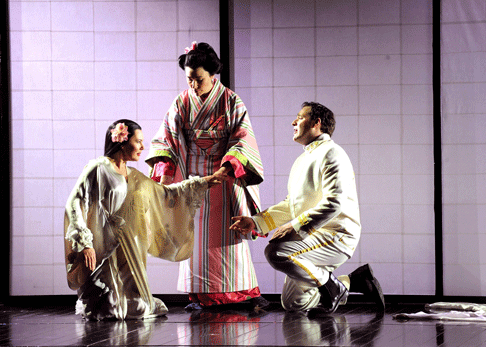 Judith Howarth as Madam Butterfly, Christine Rice as Suzuki and Bryan Hymel as F. B. Pinkerton
Judith Howarth as Madam Butterfly, Christine Rice as Suzuki and Bryan Hymel as F. B. Pinkerton
If there is a shortage of raw emotion on stage, there is an abundance of it in the pit. Edward Gardner, fresh from his revelatory Peter Grimes, gives a blazingly passionate account of the score, unequalled in my memory - and the chorus have rarely sounded better, either; the humming chorus was firm in intonation and ethereal of timbre. The supporting cast is exceptional, particularly Christine Rice’s Suzuki and Michael Colvin’s Goro.
Ruth Elleson © 2009
image=http://www.operatoday.com/MadamButterfly012.gif imagedescription=Judith Howarth as Madam Butterfly [Photo by Tristram Kenton courtesy of English National Opera]
product=yes
producttitle=Giacomo Puccini: Madam Butterfly
productby=Cio-Cio San (Madam Butterfly): Judith Howarth; Pinkerton: Bryan Hymel; Sharpless: Brian Mulligan; Suzuki: Christine Rice; Goro: Michael Colvin; Yamadori: Richard Burkhard; Kate Pinkerton: Madeleine Shaw; Imperial Commissioner: Paul Napier-Burrows. English National Opera. Conductor: Edward Gardner. Original Director: Anthony Minghella. Revival Director: Carolyn Choa. Designer: Michael Levine. Lighting Designer: Peter Mumford. Costume Designer: Han Feng. Choreographer: Carolyn Choa. Puppetry: Blind Summit Theatre.
product_id=Judith Howarth as Madam Butterfly
Photos by Tristram Kenton courtesy of English National Opera
Wagner's great-granddaughter to probe composer's family links with Hitler and the Nazis
By Allan Hall [Daily Mail, 21 June 2009]
For decades the shadow of Nazism has hung over the descendants of Richard Wagner.
His monumental music was embraced by Hitler while, 50 years after his death, the composer’s family were favourites of the dictator and his cronies.
'Ghosts of Versailles' an entertaining evening
By Sarah Bryan Miller [St. Louis Post-Dispatch, 18 June 2009]
Opera Theatre of St. Louis has a history of taking fresh looks at operas that had less-than-stellar beginnings (Britten’s “Gloriana” and Adams’ “Nixon in China,” to name two gleaming examples) and illuminating something greater within them.
Madame Says Farewell
She said it again twice more that week, in the same venue; no doubt other such occasions will occur. (In any case, there are several CDs and DVDs available. Check her Web site, www.granscena.org.)
It is easy for anyone to make jokes about opera — everyone already has. Most of them aren’t funny, never mind witty, never mind as delicious as the real thing — but that never stops the jokers. What is rare, besides jokes about opera that are actually funny, witty, and delicious, is someone who can make a joke about opera last (before a pretty knowledgeable audience, too) for three hours at a stretch, without deadening out. Anna Russell managed it — but opera, though her best-known target, was not the only string to her bow. (I’m not mixing metaphors; I’m setting them on PUREE.) Gerard Hoffnung managed it, but died too tragically young. Vera Galupe-Borszkh can still clock it in at three hours after 28 years in the saddle, which is nothing short of extraordinary — sometimes she has even been known to resort to new material! No doubt she owes some of her creativity to a long and suspiciously well-guarded but indescribably relationship with the vastly knowledgeable Ira Siff, who co-announces Metropolitan Opera broadcasts.
But how she manages to get her magnificent mane of red hair (natural, she swears by the Virgin of Kiev) out of its scruffy featherduster á la nature into a taut geisha coiffure during one swift scene change (you never saw a redheaded Butterfly? This must be the place) and then formed into a trillion sausage curls for the dying Violetta in another — that calls for skill, technique and effrontery, which have been (along with a haphazard, not to say biohazard, shtetl Bessarabian accent) the hallmarks of her career.
Born Vera Vsyevelodovna Borszkh on the outskirts, or fringes, or gym socks of Odessa, more years ago than Madame can be relied upon to count, she fled Soviet Russia “when I got tired of singing Aida in languages which got no wowels.” Later she became the last pupil and ultimately the bride of the last bel canto castrato, Manuel Galupe (“for a diva, marrying a man already a castrato is good thing — it save so much time”). Vera Galupe-Borszkh is not only a living legend (they’re common enough), she is a voice from the golden age when such things were preserved only by memory and by the rare and often unconvincing magic of scratchy shellac at 78 revolutions per minute. When you hear G-B, you not only hear the technique, the talent, the dedication of a bygone golden era, you seem always to hear in her very throat the echo of scratchy shellac. Perhaps she is one of those who has used her throat not wisely but too well — the Muse is a harsh mistress, and G-B has never been one to hold back. Fake it, yes — hold back, never.
Only a cad — or a critic — to make a distinction without difference — would point out that Madame’s sustenance of tone has begun to waver, like the breeze flitting over the Ukrainian wheat fields at noon. To put it crudely, you could drive a tractor through that tremolo. Yet, properly warmed up, she can still exquisitely float the opening tone of the opening “Pace” in Leonora’s aria from Forza del Destino so that it seems to last longer than the entire opera usually does. (Just as well she omits the rest of the aria.) Her pitch in the Philip Glass takeoff is no longer machinelike — and Glass’s music, even in sendup, does not take kindly to human performance. And was I really the only member of the audience so moved by her singing of the Sleepwalking Scene from Bellini’s La Sonnambula that I could not resist shouting: “Jump! Jump! Jump!” (A friend said he was saving the comment for Mary Zimmerman’s next curtain call.)
More grateful for her instrument in its present vocal estate (or tenement, as she has been a New Yorker for years), were five “Rossyan fok songs,” in which the audience was invited to join her. (“You are good! You must all be Juilliard drop-outs!”) Lieder, too — her signposted “Erlkönig” is justly famous, her “Morgen” sublime — were rather easier on voice and ear than the full-scale arias. Let lesser singers take note: Madame never sings with surtitles or subtitles or translations — the voice and the gestures (and the costumes) give us every drainable drop of meaning, and you’re lucky to get it.
It was a great event in the present — but it was, still more, as Madame put it herself, an evening of extraordinary mammaries. So much of the style — and the singing — and the shtick — and the annotation — seemed uncannily to recall occasions long, long ago. But it was delicious to hear her shtick it to the Met, with all the fervor of someone who might have been tactfully repressing her real opinions during a season of broadcast commentary. (“I love the Salome — where she take off everything! Even some of the high notes!”)
She was ably assisted by Maestro Sergio Zawa, engulfing the piano, and Carmelita della Vaca-Browne stealing the crumbs of the scenes Madame was chewing. Della Vaca-Browne lovingly recreated a moment I’ve never forgotten, from the very first season of La Gran Scena Opera Company di New York in 1981, when Annina beheld the gasping Violetta on her deathbed and tossed confetti in her face, then responded to her furious glare with the explanation, from the libretto: “E carnevale.” In Vera’s vocal presence, when is it not Carnival?
Ladies and gentlemen, all I can say is (to echo Tosca, one of Madame’s great roles): “Ecco un artista!”
John Yohalem
image=http://www.operatoday.com/Galupe_Borszkh.gif image_description=Vera Galupe-Borszkh [Photo by Robert Milazzo] product=yes product_title=Madame Says Farewell product_by=Madame Vera Galupe-Borszkh Back By Personal Whim (and popular demand). Conceived, written and performed by Ira Siff. Music director: Lucy Arner. Stage director: Peter Schlosser. Guest Artist: Johnny Maldonado. Leonard Nimoy Thalia Theater, New York City. Performance of May 27. product_id=Above: Vera Galupe-Borszkh [Photo by Robert Milazzo]Alceste by The Collegiate Chorale
That Gluck, halfway between the baroque revival and the Mozartean standards, is on a roll is not news. Orfeo is performed all over the place — it always has been — but in more and more headline-grabbing productions. Iphigénie en Tauride has become almost a repertory item — Susan Graham does it everywhere, and other singers are taking it up. I heard Iphigénie en Aulide in Rome last March (in a production borrowed from La Scala), Armide was recently staged in Berlin, and Alceste will be given in Santa Fe this summer with Christine Brewer. Paride ed Elena is a workout — essentially two singers in a long, aria-by-aria, seduction — so it’s not surprising that that remains a rarity.
In Alceste, Gluck uses the chorus in his stately way to set the scene in his three acts, creating a mood (somber in Act I, joyous in Act II, hellish in Act III) against which the principals create the drama by vivid contrast. In Act I, Alceste resists the helpless sorrow of the people of Thessaly, bewailing the imminent death of their king — she will take action, offering herself to death in her husband’s stead. In Act II, the rejoicing of the populace is again a setting for Alceste, when she admits to her husband what she has done, plunging everyone into mourning yet again. In Act III, the raucous Hercule breaks the spirit of the Underworld denizens and saves Alceste. The chorus is thus fundamental to the action by creating a musical backdrop against which the individual may become heroic. The mass and weight and careful diction of the Collegiate were impressive, though the many solo lines spread among them (Gluck’s idea: so we can take them for individual inhabitants of Thessaly in a national crisis and not just anonymous masses) did not sound of proper operatic caliber.
Alceste usually gets trundled out for some aging, rather placid grande dame — few characters ever lose their cool in Gluck, and Alceste’s emotions are grandly presented — seething beneath a surface of good manners. Technical control and subtle acting are cues for the part — Alceste does not have a huge orchestra to contend with, but she must express her despairs and her resolve with dignity and economy.
Deborah Voigt’s voice was once a technical marvel, though seldom expressive. For whatever reasons (and she was singing through a cold on this occasion), she is no longer fully in control of her voice. Phrases droop from pitch or blare forth undirected. Her famous aria at the conclusion of Act I, “Divinités du Styx,” was sung with full technical command but slight feeling; her quieter, more introspective aria at the opening of Act II was a rare, affecting moment when the singer was playing the part, not simply vocalizing. Voigt has been a fine Cassandre in Les Troyens, a role that would seem to offer a key to a fine Alceste, but on this occasion the music got away from her.
The singer who brought down the house was Vinson Cole, a veteran called in as Admète when Marcello Giordani had to cancel. I heard Cole sing Gluck twenty years ago, in the French version of Orphée, where he was suave, yearning, thrilling, far more effective in the part than the altos who usually sing it (in the Italian version). His Admète was a stunner: the voice so youthful (belying his white hair), so liquid, so lyrically expressive that the opera’s focus became his anguish rather than Alceste’s sacrifice. Richard Zeller made a good roustabout Hercule, Kyungmook Yim was an exciting Apollon (Admète’s friend in high places), and Ryan Kinsella effective as the oracle who decrees the substitution possible. Manahan, in the pit, was always dignified but never boring — the proper style for Gluck.
John Yohalem
image=http://www.operatoday.com/content/mort_alceste_detail.jpg image_description=Detail from La Mort d'Alceste ou L'Héroïsme de l'amour conjugal by Pierre Peyron, 1785 (Musée du Louvre) product=yes product_title=Christoph Willibald Gluck: Alceste product_by=Alceste: Deborah Voigt; Admète: Vinson Cole; Hercule: Richard Zeller; Apollon: Kyungmook Yum; L’Oracle: Ryan Kinsella; Evandre: Gregory Hostetler. Collegiate Chorale and New York City Opera Orchestra, conducted by George Manahan. At the Rose Theater. product_id=Britten’s Midsummer Night’s Dream Charms La Scala
It has a long history; it was a major hit of the 1991 Aix-en-Provence Festival International d’Art Lyrique. The rich and costly staging was then co-produced with the Opéra Nationale de Lyon. In the last 18 years, it has traveled to many countries; in Italy, in the 1990s, it had a few performances at the Ravenna Festival and Ferrara Musica. In both towns the opera house is comparatively small and the stage not much larger that that of Aix-en-Provence. Carsen has reviewed and updated the staging many a time. Further stagings are now programmed all over Europe and, supposedly, in the USA.
The opera itself had been conceived for a specific event: the reconstruction, in 1960, of the Jubilee Hall in Aldelburgh, where Britten and his lifetime partner, the tenor Peter Pears, were living. Even though the reconstruction implied an increase in space, the Hall could accommodate no more than 316 people. It had a simple wooden stage (with no modern machinery or equipment), the pit was designed for a small orchestra (nearly a chamber music ensemble), although the opera required 18 soloists and a children chorus. At that time, Britten was working on a project to reduce the cost of opera productions and to make them transportable from town to town; he thought that this was the only feasible strategy to make opera survive in the post- World War II era. As a part of this strategy, in 1945, he gave a new start to the Glyndebourne Festival in Sussex, and in 1947 he created the English Opera Group - a touring company with limited means to bring opera even to small towns of the UK, Switzerland and the Netherlands. Some of his operas (“The Rape of Lucretia”, “Curlew River”, the Church musical pieces) were composed for this project. Even his attempt at “grand opera,” “Billy Budd,” had also a version with only two pianos and a slightly reduced number of soloists.
Against this backdrop, the Scala “A Midsummer Night’s Dream” is a departure from Britten’s chamber opera yet still far from his two forays into “grand opera” (“Gloriana”, in addition to “Billy Budd”) . Britten’s writing is eclectic; it is rooted in the British tradition since Purcell but it incorporates also Berg’s technique of adopting a theme on which to build each individual musical scene, though Britten does not turn his back on a tonal approach. Another aspect - especially relevant to “A Mid-Summer”- is his capacity to obtain colour from a small orchestral ensemble and the counterpoint of a large number of vocal soloists. Finally, in “Midsummer,” he explores the magic of the night and assigns to the fairies the most “unearthy” vocal register: a coloratura soprano (Tytania) and a counter-tenor (Oberon).
After 18 years, the production is still fresh. Carlsen, then very young, saw “A Midsummer” as an exploration of eroticism - from that of the very young (the two fugitive couples) to that of the adult (Tytania and Oberon) to that of the peasants. The set is wide green with beds (two huge ones in the first act, six “queensize” in the second act, and three, suspended above the stage, in the first part of the third act) until the final scene in a white but dull Athens.
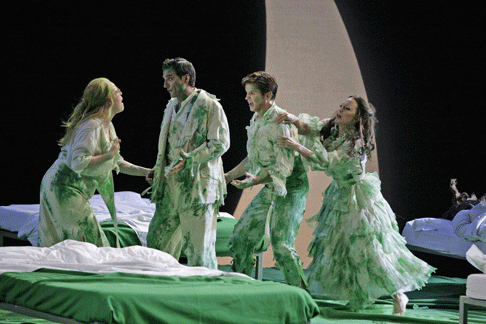
Sir Andrew Davis conducted a chamber music ensemble: two harps, a harpsichord, a small number of violins and cellos, brass and percussion. The small orchestra performance is the best part of the performance, the crystal-clear and transparent texture is a real thrill. A mostly British cast gave excellent acting performances. The Rosemary Joshua sang a sexy “coloratura” Tytania, and quite good also were the two young couples (Gordon Gietz, David Adam Moore, Deanne Meek and Erin Wall). David Daniels is a virtuoso countertenor but his volume is better suited to a small concert house than to the large La Scala auditorium (where the acoustic is less than perfect).
Giuseppe Pennisi
image=http://www.operatoday.com/MidsummerLaScala01.gif image_description=David Daniels as Oberon and Rosemary Joshua as Tytania
product=yes producttitle=Benjamin Britten: Midsummer Night’s Dream productby=Oberon: David Daniels; Tytania: Rosemary Joshua; Puck: Emil Wolk; Theseus: Daniel Okulitch; Hippolyta: Natascha Petrinsky; Lysander: Gordon Gietz; Demetrius: David Adam Moore; Hermia: Deanne Meek; Helena: Erin Wall; Bottom: Matthew Rose; Quince: Andrew Shore; Flute: Christopher Gillett; Snug: Graeme Danby; Snout: Adrian Thompson; Starveling: Simon Butteriss; Cobweb: Francesca Mercuriali; Peaseblossom: Elena Caccamo; Mustardseed: Barbara Massaro; Moth: Nicolò De Maestri. Conductor: Sir Andrew Davis. Stage Direction: Robert Carsen. Set and Costumes: Michael Levine. Lighting: Davy Cunningham. Choreography: Matthew Bourne. Orchestra del Teatro alla Scala. product_id=Above: David Daniels as Oberon and Rosemary Joshua as Tytania
La Cenerentola at the MET
For the matter of that, they didn’t get around to L’Italiana in Algeri until the present production — the one Jean-Pierre Ponnelle was doing all over the operatic world — was created for Marilyn Horne, not so terribly long ago. Il Barbiere di Siviglia was the only Rossini opera buffa so far as New Yorkers (and most of the world) were concerned, from the very first season of the Met (in 1883) — actually from New York’s very first opera season, in 1829, when Garcia, the first Almaviva, brought his own company to town — until comparatively recent times. Il Turco in Italia ran one season at the City Opera; Il Viaggio a Reims and Le Comte Ory also played that innovative company with some success; Il Signor Bruschino has been given by the Gotham Chamber Opera; others — La Scala di Seta, L’Equivoco Stravagante, Il Cambiale di Matrimonio and so on, have had occasional or student or semi-amateur stagings hereabouts.
Cenerentola can seem long — they all can seem long — if the fun isn’t fresh and the singing less than grade A — but we live in an era of grade A Rossini singers, so there’s no excuse for that any more. It contains the usual Rossini elements: masks and mistaken identities, an orchestral storm, arias somewhat familiar from other Rossini operas, at least one aria for a minor character composed by someone else because Rossini was too busy (or lazy) (this is omitted in the Met production; it was given in the City Opera production), bravura singing for everybody, dueling comic basses, and two of Rossini’s famous wacky scene finales where Italiana and Barbiere only had one each. As is usual in dramatizations of the Cinderella legend, the stepsisters get a lot of farce time — which can be amusing at first, but wears out its welcome in time. Cenerentola ought to be more fun than it proved on this outing, and perhaps it was to those unfamiliar with the jokey Cesare Lievi/Maurizio Balò production, its garish palette, oversized rooms, and fantasy sequences.
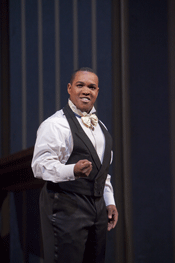 Lawrence Brownlee as Prince Ramiro
Lawrence Brownlee as Prince Ramiro
The comic basses were Simone Alberghini as Dandini, the prince’s
valet, masquerading as his master to distract Cinderella’s ghastly
family, and Alessandro Corbelli (this production’s original Dandini) now
promoted to Don Magnifico (Cinderella’s preposterous stepfather, a
snobbish, bankrupt aristocrat in the mold of the Duke of Plaza-Toro —
except the Duke is much nicer). They were the core of the evening’s fun,
stylish, absurd, graceful on the ear even when spluttering. The whole
buffa phenomenon was based on such figures and their highly personal
antics, not unlike the signature shtick of vaudeville comics — most
Italian opera houses in 1816 were small enough for any sort of nuance. Corbelli
and Alberghini are veterans who have made these sorts of roles their own.
Alberghini’s dancing prince-valet is so clearly out of musical comedy
that you wonder how anyone could fail to see he wasn’t a real prince
— except this is an opera buffa, and everyone is acting like that.
He’s just doing it better. Corbelli is a master of both the slow burn to
explosive payoff and the elegiac daydream (quoting the “voices” of
his fantasies) — he can even be romantic, as he showed in last
season’s Fille du Regiment. In contrast to this splendid buffo
fooling, the stepsisters in their mad 1920s getup rather wore out their
welcome, and the three-legged sofa is weary stuff.
One of the reasons Rossini’s operas have returned to popularity is that he wrote so many of his heroines for mezzo-sopranos, usually his lover (later wife) Isabella Colbran. The distinction was not made in Rossini’s lifetime — a soprano was a soprano; if she lacked top notes and had low notes, the composer wrote different music for her; if another singer came along, someone — not always the original composer — wrote her something new. (Sopranos often stole Rosina. Mezzos sometimes sang Rossini’s Otello.) We are living today in an age of wonderful light mezzos (one can trace the revival back to Horne, or to Simionato and Berganza if you prefer), and I believe we can all agree that they deserve more prima donna stage time than they tend to get.
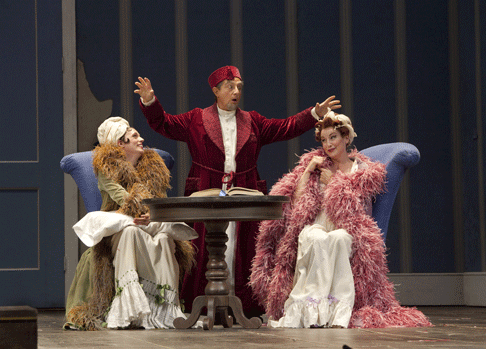 Rachelle Durkin as Clorinda, Alessandro Corbelli as Don Magnifico, Patricia Risley as Tisbe
Rachelle Durkin as Clorinda, Alessandro Corbelli as Don Magnifico, Patricia Risley as Tisbe
Cenerentola — or Angelina, as she is actually named — was sung this year by Elina Garanča, a Latvian mezzo who made her Met debut last year as Rosina. She is a beautiful woman with a beautiful voice — a combination still welcome but no longer uncommon on the opera stage. She looks good in anything, including — no, especially — trousers, as Bellini’s Roméo, and she has a sweet metallic sheen that easily fills the house. What she is not, on the evidence of this performance, is a Rossini coloratura of the Rossini buffa variety, capable of torrents of notes where other composers would settle for an attractive stream. When Rossini revs it, he really revs it. Garanča sings three notes for every five written in the racy cadenzas, and those cadenzas were composed to be sung five for five — as the performances of Simionato, Berganza, von Stade, Horne and Bartoli demonstrate. Therefore I am delighted that Garanča has joined the Met roster, but puzzled why she chose Rossini to do so — perhaps just to get her foot in the door, a worthy objective — and eager to hear her in more suitable repertory.
Another reason I was eager to attend this season’s Cenerentola was finally to hear Lawrence Brownlee, the young American contender in the Rossini tenor stakes and, by the sound of audience response, already a singer the Met has taken to its heart. Brownlee has, on the evidence, a larger, more liquid sound that Juan Diego Florez’s more nasal tone or Barry Banks’s more brilliant but less sensuous instrument, and he appears to be the equal of both in rapid-fire coloratura. Don Ramiro, the prince, is, alas, not much of a role — besides a couple of duets (with Angelina and Dandini) and parts in the concertati, he only has one bravura scene — I have always been surprised when a leading tenor like Florez or Vargas condescends to take it on. Brownlee seemed comfortable on stage in all the silliness required of Don Ramiro in this production, but he does not cut a terribly romantic figure beside the taller and slimmer Miss Garanča. I look forward to hearing him again this summer in the semi-staged operas being performed at Caramoor.
Maurizio Benini led a sprightly performance without the affectations that sometimes marred his conducting of Don Pasquale. The longueurs that crept in were often as not Rossini’s fault.
John Yohalem
image=http://www.operatoday.com/CENERENTOLA_Garanca_as_Ange.gif image_description=Elīna Garanča as Angelina [Photo by Ken Howard courtesy of The Metropolitan Opera] product=yes product_title=G. Rossini: La Cenerentola product_by=Angelina: Elina Garanča; Don Ramiro: Lawrence Brownlee; Don Magnfico: Alessandro Corbelli; Dandini: Simone Alberghini; Alidoro: John Relyea. Conducted by Maurizio Benini. Metropolitan Opera. product_id=Elīna Garanča as AngelinaAll photos by Ken Howard courtesy of The Metropolitan Opera
Claudio Abbado Introduces the Complete Pergolesi
He was born in Jesi — also the birthplace of Gaspare Spontini — on January 4th 1710 to a poor family (and most likely affected by many hereditary diseases). At a young age he left the small and pleasant little town on the Marche hills near the Adriatic Coast to move to Naples. There he studied at the San Pietro in Majella Conservatory. Upon graduation, he found employment as a musician and composer with a family, the Maddaloni, closely linked to the Austrians and thus not on good terms with the new powers-to-be in Naples (the Spaniards). He died young , at the age of 26, in a Monastery near Pozzuoli, in the suburbs of Naples. In his short life, he composed several opera serias, Church music and intermezzos. He was, it seems, well-known and appreciated in Naples and Rome (where the Maddaloni family went to find shelter when the Spanish Bourbons took over the Government in the Southern State).
He became internationally known several years after his premature death when his intermezzo La Serva Padrona, generally credited as the first opera buffa, precipitated a major artistic controversy (la Guerre des Bouffons) in France as well as elsewhere in Europe in the decades immediately preceding the Revolution. The first performance of La Serva Padrona in Naples in 1733 passed unnoticed; it was performed as a intermeszzo among the three acts of the opera seria Il Prigionier Superbo. La Serva Padrona was produced in Graz in 1739 by an Italian touring company without much notice. Its big splash was in Paris in 1752. Then, it provoked such a tumult of enthusiasm that it can be said to have caused a revolution in French opera; it played to almost full houses for nearly three years. At that time, French opera dominated and domineered European stage. The plot of La Serva Padrona is simple and satiric. Most of the dialogue is written the rapid recitative secco , unknown elsewhere in Europe except for Naples. The real charm of the short two parts intermezzo resides in the set numbers arias and duets where comedy and pathos intermingle. It was a real shock in Paris where the baroque opera was at its sunset and the tragédie lyrique was losing his hold. La Serva Padrona became an opportunity to inveigh against tradition and to promote the new culture of free expression of feelings- in short, to bring enlightenment to the opera stage and to the opera houses. The philosopher Jacques Rousseau became the leader of the movement; he himself composed an opera buffa in the new style, Le Diven du Village.
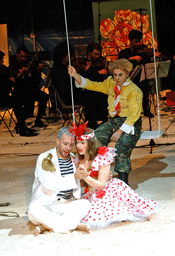 A scene from La Serva Padrona
A scene from La Serva Padrona
Internationally, Pergolesi is mostly known for La Serva Padrona and two of his sacred pieces, Salve Regina and Stabat Mater, but he was a prolific composer in his brief life; at least six operas, mostly opera serias, are attributed to him. For the 300th anniversary of his birth, the Jesi-based Pergolesi Foundation has the ambitious program to stage all of them; the six operas will be staged in Pozzuoli, where, as already mentioned, the composer died.
It is fair to say that only two of the six operas would be new productions. In the last few years, the Foundation has already staged four of them in programs co-produced with the Festival of Radio France in Montpellier and with the Baroque Festival of Beaune as well as with the theaters of Modena, Piacenza, Ravenna, Reggio Emilia and Treviso. The full schedule is available at www.fondazionepergolesispontini.com and summarized at the end of this article.
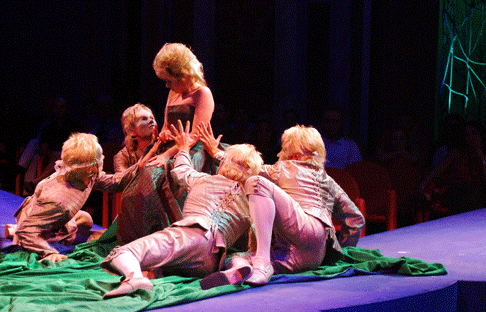 A scene from L’Olimpiade
A scene from L’Olimpiade
A jump start to the festival was, on June 5th, a concert of the Mozart Orchestra with Claudio Abbado conducting a fine group of soloists and the Swiss Radio Chorus. The concert was performed in the lovely Pergolesi Theatre in Jesi, with live and free maxi-screen video on the main square of the town. Only the initial number of the concert came from an opera, the aria Manca la guida al piè from the Neapolitan music drama Li Prodigi della Divina Grazia nella Conversione e Morte di San Guglielmo, a dramatic play Pergolesi composed when he was 21. The play has never been staged in modern time; it is programmed for December 2010 as a part of the performances of Pergolesi’s complete oeuvre. The rest of the concert was devoted to Church music with the Missa in F major taking up the entire second part. Abbado conducted with sublime elegance. All the soloists were of high standard, especially the alto Sara Mingardo. The audience was enthusiastic.
Our readers are most likely more interested in the operatic full immersion in Jesi and Pozzuoli than in a review of concert. I have seen in Jesi all the four productions that will be revived as a part of 2010 program. All of them are of high quality and show a Pergolesi very different than the composer generally known to international audience - mostly through La Serva Padrona, Salve Regina and Stabat Mater. I would recommend especially two of the four operas: La Salustia and L’Olimpiade. The former is one of the early opera seria by Pergolesi: it is passionate, nearly lascivious (also due to the staging by Jean-Paul Scarpitta), and thus very modern as compared to the standard and style of the time. The latter uses the Metastasio libretto previously set to music by Vivaldi, Galuppi and others, but it is unusually powerful in capturing friendship and competition among two young men; the staging of Italo Nunziata is a dramatic masterpiece.
Giuseppe Pennisi
The Opera performances in Jesi:
Il Prigionier Superbo- 11-12 September 2009 La Serva Padrona - 11- 12 September 2009 Il Flaminio - 4-6 June 2010 Adriano in Siria - 10’-12 June 2010 Livetta and Tracollo - 10-12 June 2010 La Fenice sul Rogo - 13 June 2010 Lo Frate ‘Nnamoratu 3-5 September 2010 L’Olimpiade - 10-12 Sempter 2010 Li Prodigi de la Divina Grazia 11September 2010 Il Prigionier Superbo 19-21 November 2010 La Serva Padrona 19-21 September 2010 La Salustia 10- 12 December 2010
Dates of the Opera Performance in Pozzuoli 4-13 September 2010
image=http://www.operatoday.com/Giovanni-Battista-Pergolesi.gif image_description=Giovanni Battista Pergolesi
product=yes producttitle=Giovanni Battista Pergolesi: Manca la guida al piè (from Li Prodigi della Divina Grazia nella Conversione e Morte di San Guglielmo); Laudate Pueri Dominun; Salve Regina in F minor; Missa in F major. productby=Veronica Cangemi, Racherl Harnisch, Teresa Romano, Sara Mingardo. Chorus of the Swiss Radio. Orchestra Mozart. Conductor: Claudio Abbado. Jesi - Teatro Pergolesi, June 5 2009.
June 20, 2009
Bach's St. Matthew Passion at BAM
He does not seem to have had any interest in the operatic form and, too, he never lived in a major court city (such as Dresden or Berlin), where an opera company would have been part of any composer’s focus — much less an urban center with its own opera tradition, such as Hamburg, Venice or London. Why, then, would we want to have one of his grander compositions — in this case, the St. Matthew Passion — enacted on stage, with the singers playing parts, when Bach seems to have intended the music and the message to reach our ears without benefit of stage pictures at all?
Handel’s oratorios are sometimes based on stage plays (Esther, Athalia, Hercules), and the laws against staging Bible stories in England were only withdrawn in the twentieth century — the arguments for presenting them fully staged are clear and often convincing, as are staged productions. Besides, Handel had plenty of stage experience and knew how to run the machine as well as anybody. Bach never got that experience.
What has been achieved in Jonathan Miller’s long-celebrated staging of St. Matthew, recently presented at the Brooklyn Academy of Music, is an emphasis on the story to vie with the music, an urgency to the unfolding drama, an intensification of the (perhaps obscure) message of the crucifixion. The singers are acting, and they are catching our eyes, and they are putting a force behind the meaning of the music that is rare in even the most intense concert or church performance — they are underlining the theatricality of ritual, the ritual nature of theater — they are pulling us into an event of two thousand years ago with the intent of obliging us to think about it, take it seriously, of not permitting us to pass it off, whether we agree with Bach’s (and St. Matthew’s) interpretation or not. Further to bring it home to an Anglophone audience, the work is sung not in Bach’s German but in Robert Shaw’s singable English translation.
Since the singers are in street clothes of our era (who ever thought of Jesus as a rather pudgy fellow in a red sweatshirt? — the dignified Curtis Streetman), the result is to make the story very “lived,” very immediate, to highlight the emotions of which Bach’s melodies sing. My date, a Christian lady of a certain age, said it added to her appreciation of the story that so many of the chorales were hymns she is used to singing in church. I associate them with concerts of Bach — but perhaps this ties us to something like the feelings of the audience for the original classical tragedies, when the Aeschylean chorus interrupts the action to sing of some relevant myth or other. We were getting an active story, portrayed by modern-dress “actors,” while the chorus gave us their asides as well as their active participation in the drama’s many small roles. But this theatricality was intentionally undercut, not only by costume but by positioning — the players, orchestra and singers, sat in the center of the stage, and audience members were seated around them, indistinguishable — except they were the ones with programs. We were asked to see this as a tale of the people, of ourselves, being told among ourselves, by performers who were also ourselves. Theater and ritual alike were deemphasized.
We could imagine that we were in Jerusalem that holy week, seeing these things as they happened — as Bach perhaps wished us to imagine ourselves. This called for singers (chorus as well as soloists) capable of acting out the story as well as singing it, and the self-deception allowing us to imagine we could sing as well as Rufus Müller (the Evangelist), Suzie LeBlanc and Daniel Taylor. I mention LeBlanc and Taylor particularly, because I am familiar with their work in various early music venues, and because both of them were exceptionally fine in their arias in St. Matthew: clear, focused voices so clear and full of belief as to give the illusion they were singing at no more than conversational volume.
For believers, I imagine, this approach would pack a thrilling punch. For those of any faith who believe in Bach and in the expressive possibilities of the voice, it was a joy to be part of so powerful a performance.
John Yohalem
image=http://www.operatoday.com/Bach_Haussmann.png image_description=J. S. Bach by Elias Gottlob Haussmann (1748) product=yes product_title=J.S. Bach: St. Matthew Passion product_by=Evangelist: Rufus Müller; Jesus: Curtis Streetman; with Suzie LeBlanc, Phyllis Pancella, Daniel Taylor, Nils Brown, Stephen Varcoe. Conducted by Paul Goodwin. Staged by Jonathan Miller. BAM Harvey Theater, performance of April 24.June 19, 2009
Goerne and Eschenbach : Winterreise
Obviously, he was too young to understand all the complex emotions in the piece but what he recognized was that they mattered. Winterreise is so powerful that even a child, albeit a talented one, could be inspired to commit it to memory.
There have been hundreds of Winterreises at the Wigmore Hall over the years. This is an audience that knows the work bar by bar and isn’t easily impressed, so when most of the house stood up in applause it was serious praise indeed. I first heard Goerne sing Winterreise some 15 years ago, near the start of his adult career (he was a child prodigy in East Germany). He was only 26, yet Irwin Gage was playing, and Alfred Brendel was listening in the stalls, rapt with attention. Goerne and Brendel became a legendary partnership, creating some of the finest Schubert performances ever produced. Their recording of Winterreise is one of the must-hear classics.
Christoph Eschenbach is a superlative Schubert performer too, so this new series of Schubert cycles at the Wigmore Hall is a significant event. Goerne and Eschenbach have already recorded Die schöne Mullerin as part of the new Harmonia Mundi Schubert Edition. Goerne’s earlier recording of that cycle is exceptional. Quite frankly, you can’t “know” that cycle without having heard that recording, because it puts paid to the myth that the cycle is sweet and innocent. Darker undercurrents almost always flow through the Romantic.
With Eschenbach, Goerne’s refining his approach to Winterreise yet again, this time even more cognizant of the structural underpinnings beneath the text. Each song marks a different stage in the journey, and those stages are in themselves significant, to be savoured for what they portend. The journey starts in a huff, the protagonist impulsively dashing out of town, the wind images in ‘Die Wetterfahne’ expressing turbulent confusion. Gradually the woman who caused the problem fades into a more generalised image on which the man can hang his feelings. ‘Der Lindenbaum’ is a temporary halt, a short moment of calm before “Die kalten Winde bliesen..” Then the true impact of the words “ich wendete mich nicht” sinks in.
This is a psychological journey, away from the town and its bourgeois values. The protagonist is out in the wilderness, in uncharted territory, where only animal spoor marks a path. Thus Goerne and Eschenbach employ a deliberate, watchful pace: paying close attention to each passage, every detail counts. Eschenbach even brought out the faint pre echo of the posthorn that appears as early as ‘Der Lindenbaum’. Similarly, the village dogs appear, in the rhythms that start ‘Im Dorfe’.
Landscape is important in Winterreise: it is a mirror of the protagonist’s soul. Schubert builds images of nature into the piano part not merely to illustrate text, but to act as an alter ego, almost a third party commentary beyond the protagonist’s highly subjective anguish. Pathetic fallacy operates, of course, for the protagonist hears his troubles reflected in the storm and swollen river, and sees frost patterns as flowers. But there’s infinitely more to the idea of Nature in the Romantic imagination. It stands as a symbol of something greater than mankind, something that endures beyond the personal and immediate.
This has implications for interpretation. Some performances depend on exaggeratedly emotional singing, on the assumption that the protagonist must be mad, since he gives up civilization to follow a crazy old beggar. Thus follows the idea that the journey can only end in death. But that trivializes the whole logic behind the cycle. If the protagonist is mad, why are we so drawn into this psychodrama? Wilhelm Muller – and Schubert – wanted us to experience the journey through the man’s feelings, to sympathize with why someone should choose a wilder path in life. Perhaps in more psychologically repressed times the idea of madness and death prevailed but for the Romantics angst was a code for what we now call the subconscious. The Romantic interest in emotional extremes was a reaction to the tidy elegance of classicism. Schubert’s contemporaries were troubled by the world Winterreise revealed, and rightly so.
The protagonist is driven to his limits but never loses sight of the world around him, even though he interprets it in terms of himself, for example when he thinks the crow is a companion. In that sense he’s not a depressive, turned entirely away from reality. Some point to ‘Der Nebensoonen’ as evidence that the man must be nuts if he sees three suns in the sky. But it’s a physical phenomenon that in extreme cold, the sun appears distorted in this way. For a century, we’ve become so used to electricity and urban living that we can’t imagine such things as reality. Goerne sings with quiet, understated dignity, as if he’s witnessing a miracle in nature. True, the protagonist still sees the eyes of his beloved wrought as huge cosmic images in the sky, but perhaps there’s something more.
The cycle ends with the strange hurdy-gurdy of ‘Der Leiermann’. The Leier isn’t a lyre, but a primitive instrument, turned rather than played, making a mechanical circular sound. The old man is “Baarfuss auf dem Eise”, barefoot on the ice, exposed to the elements, without a shred of bourgeois respectabilty. And yet he doggedly makes his way from village to village, despite being hounded by dogs and men. “Wunderlicher Alter!” sings the protagonist, what kind of phenomenom is this? Orpheus in rags?
Goerne sings the final sentence with overwhelming grace and wonder. “Willst zu meinen Liedern deine Lieier drehn?” Will the man follow the old beggar, who perhaps once set out on a similar journey? Perhaps he’s like the crow, whose companionship is coincidental not real. But the old man is human and plays a vaguely musical instrument. Perhaps he’s a symbol of the power of music, which like Nature endures whatever may happen to an individual. Throughout the cycle, the rhythms of the hurdy gurdy and lurching footsteps lurk in the shifts of pace and intensity. The Leiermann haunts the whole piece, though it takes performance of this very high standard to bring them out.
Anne Ozorio
 |
 |
 |
| Sehnsucht | An mein Herz | Die schöne Müllerin |
No Redemption for Munich’s Dutchman
It all began very promisingly indeed with a realistic period setting, gorgeously painted, and with luxurious Old Dutch Masters costumes, both designs courtesy of Johannes Leiacker. I was not completely taken with the invention of the mute character “An Angel” (Christina Polzin) who somewhat tailed the leading man as a premonition of Senta, I guess, but never mind. Because, in a stunning directorial stroke, Konwitschny set the second act ladies in a gleaming white contemporary fitness center spinning class! No fooling, this really worked. Mary was the attendant who circulated and dispensed water bottles and towels.
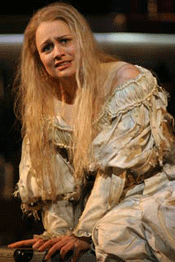 Erik entered in a white bathrobe and slippers (apparently having taken a
sauna) and it is hard to explain the rather carnal element that that visual
introduced into a scene that we usually simply suffer through. And when the
Dutchman arrived, completely anachronistic in his period Flemish drag, wow! Did
it ever hammer home the time warp he was trapped in, and the irrational
inevitability of Senta’s obsession. This was truly powerful theatre, heightened
by the fine lighting design with its isolated areas by Michael Bauer.
Erik entered in a white bathrobe and slippers (apparently having taken a
sauna) and it is hard to explain the rather carnal element that that visual
introduced into a scene that we usually simply suffer through. And when the
Dutchman arrived, completely anachronistic in his period Flemish drag, wow! Did
it ever hammer home the time warp he was trapped in, and the irrational
inevitability of Senta’s obsession. This was truly powerful theatre, heightened
by the fine lighting design with its isolated areas by Michael Bauer.
And then…Peter lost his way. The final act took place in a harbor-side warehouse with Fest tables/benches, the Dutchman crew visibly partied stage left, and lots of metal drums filled with flammable materials crowded the stage. The face-off between the locals and the spooks, shorn of its element of surprise, looked like a lame “Dance at the Gym” confrontation from West Side Story. And in a critical artistic mis-step, after Senta’s last outburst she torched one of the storage drums, and a huge explosion blew everyone away. Everyone.
And…The…Music…Stopped.
Somewhere in the far distance, perhaps on a boom box in the ladies dressing room, we faintly heard the final bars playing as the cast was revealed standing down lit and ghostly behind a scrim. Dead as door nails. Or Dutchmen. In a box, house left, a pained spectator yelled “For God’s sake, play the rest of the music!” No one shushed him. He was articulating our collective grief.
It is inconceivable that the producers allowed Wagner’s opera to be shorn of its soaring redemption at the expense of an ineffective and inappropriate theatrical effect. Nor can I conceive that a Bernstein, or Karajan, or Maazel, or Barenboim would have allowed this musical cut to happen.
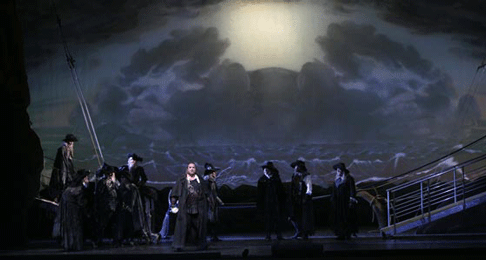
Apparently, young (talented) conductor Cornelius Meister did not have such leverage. Maestro Meister is the youngest General Music Director in Germany (Heidelberg) and his star is justifiably rising. Much of his leadership was richly incisive, with well-judged tempi and fine consideration of his singers. But it has to be said that the tricky ensemble woodwind attacci were a might ragged, and the brass were too many times perfunctory. The string section however, had a fantastic night characterized by warm and accurate tutti playing.
Even a willful re-writing of the story by a bad boy stage director, however, could not steal the focus from the brilliance of Bryn Terfel’s assumption of the title role. Surely this is one of the most glorious vocal instruments currently to be heard in the lyric theatre. From his first intense sotto voce utterance, Mr. Terfel served notice that his Dutchman was more resigned than tortured, more refined than bombastic, more rounded and musical by miles than most park-and-bark Wagnerian practitioners.
That rolling, richly burnished tone poured out with ease and power, and his acting was subtle and noble. His great duet with Senta was as tender and persuasive as I have yet experienced, and his stamina and sound technique found him sounding as fresh at opera’s end as at the start. Richly colored, finely detailed, superbly shaped phrases characterized Terfel’s tremendous musicianship, and they were wedded to an easy, engaging stage presence. If we are ever searching for members of A New Golden Age (and aren’t we always?), we can start with Bryn Terfel.
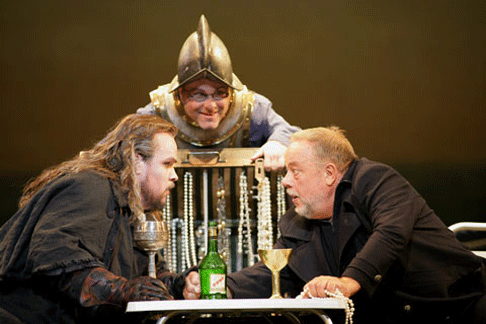
He was not alone in his success. Anje Kampe served up a radiant and vocally generous Senta, building on her already fine reputation as a Sieglinde of choice. While ample in volume, and secure in all ranges and volumes, the voice is just a bit drier than, say, Hildegard Behrens, a great Senta of the recent past. Still, her restrained vibrato made Ms. Kampe’s impersonation more youthful than womanly, and that certainly was a rewarding take. Her acting was passionately committed.
Nikolai Schukoff was a very fine Erik, with plenty of thrust to his substantial, essentially lyric tenor, and a handsome and youthful stage presence. There were plenty of sparks between him and our doomed heroine. I first saw Matti Salminen’s seasoned Daland in Savonlinna some years ago and his definitive performance has only deepened over time, with very little perceptible loss in vocal allure or power. Julia Oesch contributed a handsome, securely sung Mary. Kevin Conners seems to be a local favorite, but I found his stentorian Steersman a bit longer on power than finesse. The hard-working chorus performed well under the direction of Andrés Máspero.
Can this Dutchman yet be saved? Restoring the finale Wagner wrote would be a good start. Seriously, a musically and dramatically honest re-look of Act Three could transform this otherwise inventive and rewarding production into a memorable one.
James Sohre
image=http://www.operatoday.com/Dutchman_Munich04.gif image_description=A scene from Der fliegende Holländer [Photo courtesy of Bayerische Staatsoper] product=yes product_title=Richard Wagner: Der fliegende Holländer product_by=Daland: Matti Salminen; Senta: Anja Kampe; Erik: Endrik Wottrich; Mary: Julia Oesch; Der Steuermann: Kevin Conners; Der Holländer: Bryn Terfel. Musikalische Leitung: Cornelius Meister. Inszenierung: Peter Konwitschny. Produktionsdramaturgie: Werner Hintze. Bühne und Kostüme: Johannes Leiacker. Chöre: Andrés Máspero. Licht: Michael Bauer. product_id=Above: A scene from Der fliegende HolländerAll photos courtesy of Bayerische Staatsoper
June 18, 2009
Martinů’s cheerful Mirandolina, Garsington Opera
Garsington Opera is quintessential English Country House opera. Garsington Manor is a private house, not normally open to the public, but for a few weeks in early summer it hosts a season of opera in a temporary theater. The whole manor is a piece of theater. It stands on a hilltop overlooking the rural Oxfordshire countryside. It’s designed so the distant horizon looks like an extension of the garden. It’s spectacular trompe d’oeil. At night, statues around the vast, formal lily pond are spotlighted so they glow softly in the darkness. The theater itself is completely open on one side, overlooking a beautiful walled English garden, which can be used to extend the stage area. Indeed, wind, rain and the occasional bird sometimes take part in shows. The atmosphere is unique
It’s an ideal setting for a light hearted opera like Mirandolina. Martinů delighted in commedia dell’arte and saw the possibilities of adapting Goldoni’s La Locandiera for the modern stage. Onto this Martinů builds musical jokes, complete with recitatives, arias, moments of Italianate color and stretches of spoken dialogue. This isn’t farce, it’s far too warm hearted and funny. Nor is slapstick, as it’s too relaxed. As Martinů said it’s “a light, uncomplicated thing”, fun for the sake of fun.
Mirandola is the hotel owner who likes to tease men but loses interest once they fall for her charms. Her suitors are noblemen whose very names are jokes, like “Albafiorita” and “Forlimpopoli” announced with great flourish. |When she gets the woman-hating Cavaliere to love her, she marries her waiter instead. There is room for spicier things, like the sub plot where tarty “actresses” try to pass themselves off as ladies of the nobility, but Martinů chooses not to develop these ideas, focusing instead on sunny insouciance.
The set is gorgeous, bright vivid shades of orange, yellow red and blue, a reference to the “sunny Italy” in the plot, or perhaps to the life the composer was enjoying on the Riviera when the opera was written. Special mention should be made of the costumes, as vivid as the cartoons in 18th century broadsheets. They are so watchable that they make up for the lack of character development.
The translation is by Jeremy Sams. It’s so deadpan and maudlin, it evokes cackles of laughter. Indeed, there are choruses made up entirely of laughs “ha ha ha ha”, and “oh oh oh, ha ha ha” weaving merry rhythms. Mirandolina ‘s grandmother taught her a ditty, “Long live wine and love and laughter”. It’s banal but sung with such fervour it’s funny. Word setting otherwise misses the mark, but again, this isn’t High Art but fluff.
Performances could have been more polished, livening up the pace to sharpen comic delivery, but this isn’t the kind of opera where or feats of vocal fireworks are needed. Juanita Lascarro, the heroine, is the only naturalistic role in a company of caricatures, so her part gave her range to show her skills.
Mirandolina would fall flat as serious opera, heard in more formal surroundings, but at Garsington, where you’re mellow with the ambience and fuelled with good champagne, it’s plain good fun. So grandmother had it right after all. As long as you have “wine and love and laughter”, things can’t be all bad.
Anne Ozorio
Mirandolia runs to 5th July at Garsington Opera. See http://www.garsingtonopera.org/
image=http://www.operatoday.com/garsington.gif image_description=Garsington Opera
product=yes producttitle=Bohuslav Martinů : Mirandolina productby=Juanita Lascarro (Mirandolina), Mary Hegarty, Jean Rigby (actresses), Daniel Norman (Fabrizio), Mark Wilde (The Count of Albafiorita), Geoffrey Dolton (The Cavaliere of Ripafratta), Andrew Slater (The Marquess of Forlimpopoli), Stuart Haycock (servant of the Cavaliere(, Martin André (conductor), Martin Duncan (director), Francis O’Connor (design). 18th June 2009, Garsington Opera, Oxfordshire, England.
Aldeburgh Festival — New Buildings, New Birtwistle Operas
Like Britten himself, Birtwistle is fascinated by early English music. So his new music grows on ancient roots, much like the new buildings at Snape rising from the remains of granaries that occupied the site in Victorian times. The new Britten Studio is a minimalist structure, with open beams in the roof and rough hewn brick walls. Architecture as abstract art. It was a perfect setting for the austerity of Birtwistle’s two new works.
Semper Dowland, simper dolens takes its cue from John Dowland's Seven Teares figured in seven passionate Pavanes. To Birtwistle, the Dowland sequence is "unique in the history of music". The basic unit is a song Lacrimae, which is set in seven versions, with the same chord sequence, each only a slight variation on the former, so the whole flows endlessly like the tears in the text. "It's like making music into a three dimensional object", says Birtwistle, "like seeing something in different facets".
In a musical puzzle piece like this, simplicity is of the essence. Dowland played the lute and sang it himself to small audiences. Mark Padmore sings, accompanied by austere yet limpid harp, a lute writ large with deeper sonorities. At critical moments, low voiced murmurs from bass clarinet, viola and alto flute, then sudden lyrical flights on piccolo.
The Corridor is Birtwistle's latest exploration of the Orpheus myth. Again, it springs from a simple idea, a freeze frame focus on a single, fleeting moment in the saga, when Orpheus, leading Eurydice out of the Underworld, suddenly looks back. In an instant, he loses her and she's swept back into eternity. So Birtwistle makes the split second extend into a half hour meditation on past, present and future. He layers mood on mood, infinitely extending the moment, which once past cannot be retrieved. So don't expect a storyline or development. This is a different concept of time in music.
The text is by David Harsent, whose poetry is poignant because it's direct and seemingly simple. He wrote the libretto for Birtwistle's The Minotaur where the Minotaur's fierce exterior hides his innocent, childlike soul. An even better comparison with The Corridor is The Woman and the Hare, a 15 minute jewel Harsent and Birtwistle wrote some several years ago. Birtwistle has come a long way from Punch and Judy. His more introspective work is delicate and intricately constructed - like his fascination with clockwork and mazes.
Indeed, Harsent's text in The Corridor is particularly elegaic and beautiful, Birtwistle hardly has to "set" it as such, for the phrases and words flow melodically. Elizabeth Atherton's was nicely warm blooded and lusty, making her fate all the more distressing. You could "hear" the vibrant young woman who dies on her wedding day. I wasn't so sure about the film projections and dancing, though I can see why the spartan staging might need elaboration to keep an audience happy. London audiences will get a chance to see a concert performance at the Queen Elizabeth Hall on 6th and 7th July.
But again, the best writing is for the male voice. As the poem goes:
"...there's only one word dark enough, one word as bleak, as cruel....to tear the heart, a word to blacken rain....to bring to ruin all joy or gift or courage...."
Orpheus cannot bring himself to say the word. Padmore sings the name instead, Eurydice, over and over, each time differently, as if reluctant to lose hold of the moment.
Anne Ozorio
image=http://www.operatoday.com/Birtwistle.gif
image_description=Harrison Birtwistle
product=yes
product_title=Sir Harrison Birtwistle : The Corridor, Semper Dowland, semper dolens
product_by=Mark Padmore (Orpheus), Elizabeth Atherton (Eurydice), Helka Kaski and Thom Rackett (dancers), Peter Gill (director), Ryan Wigglesworth (conductor). London Sinfonietta. 15th June, 2009, Britten Studio, Snape Maltings, Aldeburgh, Suffolk, England.
June 17, 2009
Ian Bostridge at the Chicago Symphony Orchestra
The concert opened with a contemporary arrangement of early music, Steven Stucky’s transcription of Henry Purcell’s Funeral Music for Queen Mary, this version receiving its first performances by the Chicago Symphony Orchestra. The second half of the program offered a masterful account of Dimitri Shostakovich’s Symphony No. 15, the performance here yielding considerable opportunity for both soloists and orchestral ensemble.
The brief transcription of Funeral Music in four parts, beginning and ending with a march, honors the musical spirit of Purcell while offering a modern interpretation of the same. After an introduction emphasizing low notes for the flute, a steady piano accompaniment gives way to the drums signaling a dignified realization of death. Following this opening, the CSO brass played an appropriately somber dirge, indeed one associated with the elevated stance of passing royalty. An oboe solo, performed here with great effect by Eugene Izotov, was echoed by the brass, such types of musical dialogue informing much of the remainder of Stucky’s transcription of Purcell. Sustained notes held by the use of the vibraphone introduced a continuity leading to a final stately reprise, with the repetition of drums calling the funereal tone into an ultimate focus.
The significance of Purcell’s music for Benjamin Britten is certainly recognized from the latter’s instrumental compositions, and the pairing in this concert with Les Illuminations functioned as yet further homage to the earlier composer. Britten was first inspired by the poetry of Arthur Rimbaud in the late 1930s and finished in 1940 his cycle of songs, Les Illuminations for high voice and strings, based on Rimbaud’s texts of the same name. The singer’s approach to the poetic texts by Rimbaud and interaction with the string orchestra is key to a unified approach in a performance of this cycle. Bostridge has given ample consideration to a multi-faceted approach evident in this program. He injects a sense of drama without appearing overwrought in tone while, at the same time, maintaining sufficient ironic distance so that his performance serves as both song and commentary on the text and music being performed. In the introductory lines of “Fanfare” Bostridge declares with proud conviction “J’ai seul la clef de cette parade” [“I alone have the keys to this parade”]. When these words are repeated and varied ending piano on the phrase “cette parade sauvage” [“this savage parade”], the singer becomes a keeper of secrets, one who bears the mask of an omniscient observer. With this alternating perspective Bostridge guided the listeners through the following series of poems chosen and set by Britten. “Villes” [“Cities”] details the varied and stirring activity of the modern city, filled with moving individuals and their means of transportation. To illustrate the mix of ancient and modern — the seeming paradox of nature, myth, and metropolis — Bostridge intoned, in effective succession, a rising followed by a descending scale on the verbal forms in the phrase “la lune brûle et hurle.”[“the moon burns and howls”]. At the close of this song the paradox of frenetic movement and ancient model was capped softly by Bostridge as he asked “d’ou viennent mes sommeils…?” [“from where does my sleep come …?”] with tender inquisitiveness. In the following text of “Phrase” the lyrical I speaks, almost as one of the fates, stretching cords from one pinnacle or window to another. While describing movement here with the statement, “et je danse” [“and I dance”], the tenor emphasized the physical verb starting on a crystalline high note that progressed, glissando and gracefully all-encompassing, to a concluding low. In the following three pieces, before an orchestral interlude, the tone sways between the private and the open spheres. “Antique” is a direct address to the son of Pan, both description and attempt to communicate, during which Bostridge used his voice to suggest the musical instrument associated with the deity. The range of notes struck so effectively by the singer in the conclusion to this song evoked the female and male aspects of the “double sexe” as cited. In “Royauté” an unidentified couple indeed play at the roles of royalty for an extended day, their self-absorption brought out especially in the ironic detachment of this performance. The movements of the ocean and foam slapping against a boat in “Marine” were convincingly imitated by melismatic effects on “l’écume” [“foam”] and the final emphasis of “tourbillons de lumière” [“whirlpools of light”].
As the first in the second group of texts following the orchestral interlude, “Being Beauteous,” as titled by Rimbaud, is replete with contrasting images that call into question the concepts of actual and idealized appearance. Through notable shifts in tempo Bostridge underlined these contrasts while allowing the text to maintain its own organic flow. The tone of the song was aptly concluded with a low, almost heavy vocal projection on the words “de l’air leger” [“of the soft air”], suggesting by the performer antithesis in one’s perceptions of beauty. In the final two songs, “Parade” and “Départ,” the soloist released a crescendo of varied emotions as he observed and commented on the parade of humanity, a further and elongated assurance here given that the key to the parade rested with the perception of this voice. In “Départ” Bostridge looked truly weary as he sang “Assez vu” [“Enough seen”], the slow and quiet intonations now concluding a cycle of contradictions, as the final phrase, “l’affection et le bruit neufs” [“the new affection and noise”] trailed softly into memory.
In the Symphony No. 15 by Shostakovich, performed after the intermission, Haitink gave cohesive direction to a sprawling work that blends original motifs with ample quotation. In the first movement, marked Allegretto, an initial motif was introduced by the solo flute, played poignantly by Mathieu Dufour and leading into a series of other solo parts in succession. After the bassoon, oboe, and trombone contributed their parts, combinations of instruments — e.g. flute and brass, piccolo and strings — were punctuated by intermittent references to the William Tell overture by Rossini. In the second, Adagio movement a solo for cello was played exquisitely by John Sharp, who was subsequently joined by Dufour in a duet followed by the full complement of strings. The concluding movements of the Symphony, with various tempo markings including — again — Allegretto, contain yet further quotations from the composer’s own works as well. The integration of the past and transformation into a new composition remained the guiding force behind Haitink’s memorable interpretation.
Salvatore Calomino
image=http://www.operatoday.com/bostridge-portrait.gif image_description=Ian Bostridge product=yes product_title=Ian Bostridge at the Chicago Symphony OrchestraBostridge trades fey for Kray
The Kray Brothers were notorious gangsters in 1950’s London, who mixed crime with “gentlemanly” smoothness, so the image fits well with Brecht’s adaptation ogf the 18th century English original. MacHeath, or Mackie Messer, is an inscrutable sleazeball who always manages to slip away from tight situations. He oozes, like slime, his lines replicated in saxophone and slide trombone. So Bostridge’s lounge lizard characterization was very apt, understated but with an edge of febrile menace.
Driegroschenoper (Threeprenny Opera) was first performed as part of the agit prop cabaret world of Brecht and Weill’s Berlin. The 1931 recording and subsequent film (rather too naturalistic) has defined its performance history. It made Lotte Lenya the iconic Weill personality. Dozens of singers have colonised the image since then, as if Lenya’s rough voice was a licence for bad singing. Certainly Brecht and Weill used actors rather than singers in those early years, because they were poor and their politics meant they wanted to reach audiences in clubs, not opera houses. It’s a “Beggar’s Opera” after all.
But therein lies the contradiction that makes the piece so interesting. It masquerades as cabaret theatre, but it’s actually quite sophisticated musically. Just as Brecht turns the 18th century John Gay play on its head, Brecht turns musical genres upside down. The rousing Finale is a Bach Chorale in disguise.
This performance was conducted by HK Gruber who also sang Peachum, “the poorest man in the world” who is also The King of the Beggars (another contradiction. Gruber can do sardonic irony better than anyone else, so his approach to 3dO is in a whole other league from the usual straightforward “entertainment” mode. Beneath the cute tunes, Brecht’s message is savage : all the world’s a stage and a mad one at that. So Gruber ropes in Klangforum Wien as his “orchestra”. They are one of the best contemporary music ensembles around and can do “difficult” anytime. Here they are playing banjos, guitars, saxophones and rinky tink piano. And the chorus, who’re used to singing such complex things they need to use tuning forks, get to do “backing vocals”. It’s nice to see them all in different colourful costumes)
Proof of this musically astute approach are the soloists. Luxury casting this : Angelika Kirschlager sings a brilliantly saucy Jenny, slinking like a snake, a perfect partner to Bostridge’s louche MacHeath. Dorothea Röschmann’s usual sweetness is here laced with poison - she can act as well as sing. In this performance Polly sings Seeraüber Jenny, not Jenny herself. This works well, because it adds another level of musical cross-dressing.
More good performances from Florian Boesch as Tiger Brown the corrupt cop and Cora Burggraf as his daughter, Hanna Schwarz as Mrs Peachum, a coloratura foil to Gruber’s burlesque Peachum. His lines are half speech, half ham, so having a proper singer as his wife is a telling contrast. There’s plenty of proof as to the value of proper voices in Weill.
Lotte Lenya was the Tracey Emin of her time, and a sledgehammer persona was probably needed to bring Weill success on Broadway. If the public persona of Brecht and Weill was a caricature, their real message could be packaged in a less overtly political way. In the former East Germany, socialism wasn’t scary, so there was nothing to prove or defend. Thus the DDR Weill performance tradition diverged from the Lenya model. Weill and Eisler were performed by “real” singers like Gisela May and, of all people, Peter Schreier, consummate Mozartean, Bachophile and Liedermeister.
These are the recordings to seek out : you can actually hear the words, enunciated with the same precision as there is in the writing. Because Lenya dominated the western market, we’re been persuaded that hers is the only way to do Brecht, and we’re rewarded by pop stars and amateurs who are fun, but not necessarily best placed to reveal the real Weill.
More proof of the value of agile voices came in the rapid fire ensembles, crackling with staccato. The Kanonen Song was especially impressive, where Bostridge and Boesch bounced off each other with military precision. Perfect timing and panache are of the essence here to reveal the clarity of Weill’s writing, too often obscured by less sharply focussed performances.
Anne Ozorio
image=http://www.operatoday.com/weillmedium.gif imagedescription=Kurt Weill
product=yes producttitle=Kurt Weill/Bertholt Brecht : Die Dreigroschenoper productby=Ian Bostridge (Macheath), Angelika Kirschlager (Jenny), Dorothea Röschmann (Polly), HK Griber (Peachum and conductor), Florian Boesch (Tiger Brown), Hanna Schwarz (Mrs Peachum), Cora Burggraf (Lucy Brown), Klangforum Wien
Andreas Scholl at Wigmore Hall
Scholl’s exquisite tonal beauty and superb clarity of diction are well-known to, and relished by, lovers of song, and both were much in evidence here. But few in the audience can have been familiar with the songs of the fifteenth-century German composer, Oswald von Wolkenstein, or with the startling timbral blend of the voices and instruments of the ensemble, Shield of Harmony — although after this stunning performance there is no doubt they will be eager for more.
Oswald von Wolkenstein was a poet, musician, nobleman and diplomat. An aristocrat, he was deeply involved in the political events of his time; moreover, travels in Europe, from the early age of 10, exposed him to an eclectic range of musical influences. In particular he absorbed the sophistications and developments of French song and incorporated troubadour idioms from the Romance languages into the German court context, revolutionising the German tradition.
His songs reflect the variety of his life; indeed, mimicking the songs of the early troubadours, they provide an autobiographical passage through his travels, exploits, loves and careers, spiced with philosophical ruminations, political observations and humorous drolleries. Typical of the period, the sacred blended subtly with the sexual. This recital presented a variety of forms, long narratives interspersed with shorter lyrics and instrumental solos.
Scholl’s enunciation was superlative throughout. Indeed, there is a spoken quality to many of these songs — Spruchdichtung — forming a continuum with Wolkenstein’s poetry, and reflecting the unity of poetry and song in this period. Like a story-teller, Scholl enhanced the narrative effect by occasionally beginning with a spoken introduction which evolved naturally into song - as in ‘Es fuegt sich’ (‘It happened’), whose three parts formed a framework for the recital. Here Scholl deftly recreated Wolkenstein’s character, telling of his travels in distant lands, his musical, mercantile and military accomplishments, and his amorous adventures.
Scholl’s voice was unfailingly sweet and warm, never cloying, and loveliest in the upper range, as in one of the evening’s highlights, ‘Herz, müt, leib’ (‘Heart, mind, body’). His soothed and lured the audience, drawing them into his tale: we celebrated his pride and success - ‘Many a wise man has valued my advice,/ like my tuneful songs’ - and laughed at his mischievous opportunism: ‘Many things then came easily,/ when I wore the monk’s hood,/ in truth, never before or after were girls so friendly, as they listened to my chatter’.
And we experienced the intensity of his passion — his anguish and yearning for transfiguration being worthy of a Schubert lied:
‘When I’m with her, I lose my equilibrium,
because of a woman I must travel a bad road,
into the wilds, until her dislike mercifully vanishes;
if she would help me, my sadness would become bliss.’ (‘Es fuegt sich’, part 2)
Most of Wolkenstein’s songs are monophonic, but Scholl was joined by Kathleen Dineen in two duets, ‘Ach senliches leiden’ (‘Alas heartfelt pain’) and the mesmerising ‘Nu rue mit sorgen’ (‘Now rest from your cares’), in which the exquisite union of these two unaffected voices effortlessly conveyed the erotic charge of the text and the poignancy of loss and pain.
The instrumental pieces provided variety and charm, the players of Shield of Harmony demonstrating considerable rhythmic dexterity and delighting in the complex, simultaneous use of duple and triple rhythms.
So hypnotising was this performance that I suspect many in the audience, like this listener, failed to notice when Scholl slipped effortlessly to a baritone voice for final song.
Scholl and Shield of Harmony demonstrated total mastery of this material: golden voices appropriate to this golden age of German minnesang.
Claire Seymour
image=http://www.operatoday.com/AndreasScholl.gif imagedescription=Andreas Scholl
product=yes producttitle=Andreas Scholl at Wigmore Hall productby=Andreas Scholl countertenor. Shield of Harmony: Crawford Young lute, director; Kathleen Dineen voice harp; Margit Übellacker dulce melos; Marc Lewon vielle, lute, checker. Wigmore Hall, London. product_id=Above: Andreas Scholl
Die schöne Müllerin at Wigmore Hall
I first reviewed Goerne’s interpretation of Die schöne Müllerin in 2000, a revelatory experience in that his was the first version of this work which seemed to belong more to the world of Winterreise than to the gemütlichkeit with which Schubert’s first Müller song cycle is generally associated. In conversation a couple of years later on, he gave his view of the work — “All this naïveté — the boy walking through the trees… finding love and all that, is not what the work is about; it is much, much more involved with what might be called ‘Sturm und Drang’” — and he regarded the songs after ‘Pause’ as ‘a descending spiral for which the only culmination is death by suicide.’ Judging by this evening’s performance, he has now decided that the descent begins much earlier than that.
Goerne has at times appeared to shop around for his accompanists, seemingly in a quest to find the one who most nearly comes close to his own unique concept of Lieder. Previously it was Eric Schneider who filled that role, but in Christoph Eschenbach he seems to have found the ‘Seelenfreund’ whose playing is, if anything, even more rapt, mesmerizingly slow and intense than his singing. If ever a singer and pianist were as one in their freedom from the constriction of the bar lines, then these two are.
This is the ultimate serious This is the ultimate serious Schöne Müllerin, barely leavened with a touch of lightness — all the humour is sardonic, all the beauty deceptive, all the tempi so slow as to seem at times in danger of standing still. Of course I loved every phrase, but I can quite see that for many, this is not “their” Schöne Müllerin — for that, you need to go to Quasthoff or just about any other Lieder singer around today. barely leavened with a touch of lightness — all the humour is sardonic, all the beauty deceptive, all the tempi so slow as to seem at times in danger of standing still. Of course I loved every phrase, but I can quite see that for many, this is not “their” Schöne Müllerin — for that, you need to go to Quasthoff or just about any other Lieder singer around today.
‘Das Wandern’ is not a jolly romp but prefigures what is to come — within the subtle variations of “vom Wasser” and “Wandern” we are made aware that this is not a frolicsome lad but one whose ultimate fate is to be in thrall to an illusion — the spirit of that other deceptive piece of “rural idyll” Tennyson’s ‘May Queen’ seems to hover over us throughout — “They say he’s dying all for love, but that can never be: / They say his heart is breaking, mother — what is that to me?” Goerne seems to have decided that the crucial turning point in the cycle comes much earlier than generally supposed — here, with the line “Ist das denn meine Strasse?” sung in tones of suppressed fear and anguish, we are virtually in suicide land with the second song.
The wonderful ‘Danksagung an den Bach’ is so often sung as pretty ditty, but here we had frank, straightforward questions about the speaker’s future, culminating in superficial yet ultimately doomed exuberance. I have never heard ‘Der Neugierige’ performed with such intensity — singer and pianist united as if in prayer, the little questioning phrases after “ob mich mein Herz belog” played almost in a reverie, “die ganze Welt mir ein” taken so slowly that it became a kind of litany. I need hardly add that the earth stood still as far as most of the audience were concerned, but I can quite see how some might find it a little, shall we say, over-wrought?
‘Eifersucht und Stolz’ like most of the more vigorous songs was taken at a cracking pace, the diction at “da steckt kein sittsam Kind den Kopf zum Fenster ‘naus” remarkably crisp despite the speed, and this was followed by a ‘Die liebe farbe’ only just short of psychotic — the amount of sheer hatred packed into the seemingly innocent line “mein Schatz hat’s Grün so gern” had to be heard to be believed.
The bleakness never really lets up, ‘Trockne Blumen’ touching new depths of the most profound sadness, no triumph at “der Mai ist kommen” instead only the sense that the coming of May is cruel in the same way as Eliot’s April is, because it brings the Spring and hope so welcome to all but the poet. The final “lullaby” was again taken at a “slow and stopping pace” and some of the words were a little mangled in the process — indeed, scrupulous though his concern for the language is, Goerne does have a tendency, alarming to those of nervous disposition, to be somewhat free with what goes where in a song. One could put this down to his fervent intensity getting the better of him, since it cannot surely be lack of familiarity with the text.
Goerne says that “People always think of Winterreise as being dark, gloomy, but the man does not die at the end, he goes on, unlike the youth” (in Die schöne Müllerin). Indeed, and the wanderer’s “Nun weiter denn, nur weiter” of the later work seems positively rosy-cheeked cheeriness compared to this miller lad’s desire to weep the green grass “ganz totenbleich.” One anticipates Wednesday’s Winterreise and Saturday’s Schwanengesang with eagerness tempered with apprehension — this first installment of Goerne and Eschenbach’s interpretation of these works (recorded on Harmonia Mundi, and soon to be followed by further discs) promises evenings of an intensity as troubling as it is breathtaking.
Melanie Eskenazi
 |
 |
 |
| Sehnsucht | An mein Herz | Die schöne Müllerin |
image=http://www.operatoday.com/Goernemedium.png imagedescription=Matthias Goerne
product=yes producttitle=Franz Schubert: Die schöne Müllerin productby=Matthias Goerne, baritone, and Christoph Eschenbach, piano. Wigmore Hall, London, June 15. product_id=Above: Matthias Goerne
Mozart: Idomeneo
Somehow this masterpiece needs director Dieter Dorn to work a “minor miracle” and present the characters of the opera seria as “genuine human beings” (Stewart Spencer translated Ms. Becker’s thoughts). Too bad in his maturity, Mozart and his music weren’t able to accomplish that feat…
Dorn provides a staging that could serve as an encyclopedia entry on regietheater in the opera world. The overture gets a pantomime that ostensibly provides background story but mostly serves to distract from the music. The set is not just bare, but denuded, with the rear of the stage, including rigging and exit doors, visible. A mishmash of costumes (designed by Jürgen Rose) range from a Samurai get-up for John Mark Ainsley’s Idomeneo, to a velvet evening gown for Annette Dasch’s Elettra, and some hideous prints for the other singers and chorus (are the men in Dockers, or the German equivalent?). Granted, Dorn doesn’t titillate with sex as much as he might, but he does have Rainer Trost as Arbace strip to the waist and then cut himself with a knife, letting the stage blood run down his arm. In a regietheater masterstroke, for the ballet sequence Dorn foregoes dancers and has supernumeraries drape white sheets over the props on stage at that point, and then some of the singers amble on to leisurely examine the scene.
Possibly this staging felt fresh and bold seen live. As captured by the cameras of the experienced Brian Large, the affair feels dated and dopey. As is usually the case with failed regietheater stagings (acknowledging that there are successes), Dorn doesn’t trust the material to hold an audience’s attention, and so tries a bit of updating, a bit of anachronism, a lot of unmotivated movement, and hopes it all adds up to a show, coherent or not.
The musical side of things, however, is mostly strong. Kent Nagano finds a nervous energy that moves the score forward while retaining classical form. All Ainsley is asked to do is glower and grimace, but he does that well. His “Fuor del mar” is an angry roar, yet never ugly, and he has the technique for runs that sound heavier with many an other tenor. Annette Dasch doesn’t chew the scenery as so many Elettras have done. Maybe that’s due to the lack of scenery, but Ms. Dasch has fire enough to bring the role off anyway. Nagano uses a tenor as Idamante, and Pavol Breslik is excellent in the role. As Arbace, Rainer Trost has moments of roughness in his delivery, but the weakest link is Juliane Banse as Ilia, who has some beautiful music but whose pitch in unreliable throughout the performance.
The Metropolitan Opera video with Luciano Pavarotti can be slow-moving and undramatic, but much of the singing is as strong, when not superior, to this performance, and the staging, while dull, at least makes a modicum of sense.
Chris Mullins
image=http://www.operatoday.com/MA2072448.gif image_description=W. A. Mozart: Idomeneo
product=yes producttitle=W. A. Mozart: Idomeneo productby=Idomeneo: John Mark Ainsley; Idamante: Pavol Breslik; Ilia: Juliane Banse; Elettra: Annette Dasch; Arbace: Rainer Trost; Gran Sacerdote di Nettuno: Guy de Mey; La voce: Steven Humes. Bavarian State Opera Chorus. Bavarian State Orchestra. Kent Nagano, conductor. Uwe Eric Laufenberg, stage director. Recorded live at the Cuvilliés-Theater, Munich on 11 and 14 June 2008. productid=Medici Arts 2072448 [DVD] price=$39.99 producturl=http://www.arkivmusic.com/classical/Drilldown?nameid1=8429&namerole1=1&compid=15901&genre=33&bcorder=195&nameid=56914&name_role=3
June 16, 2009
Vu et entendu : Carmen à l’Opéra-Comique
La critique d’Emmanuel Dupuy [Diapason, 16 June 2009]
C’est l’événement le plus antidémocratique de la saison : Carmen à l’Opéra-Comique, pour sept représentations. Mais l’art et la démocratie font-ils bon ménage ? Vaste débat, auquel le degré de jouissance que l’on atteint en ce soir de première apporte un élément de réponse. Carmen chez elle, rendue à ses dimensions d’origine, dans ce théâtre qui abolit les distances et rend inutiles les surtitres.
A classic confection that's near perfection
By William Randall Beard [Minneapolis Star Tribune, 16 June 2009]
Skylark Opera’s second annual summer festival includes a trademark operetta, Sigmund Romberg’s “The Desert Song,” and one of the great comic operas, “Don Pasquale” by Gaetano Donizetti. The latter is the only one worth seeing.
June 15, 2009
Anna Netrebko returns to S.F. in 'La Traviata'
By Joshua Kosman [San Francisco Chronicle, 15 June 2009]
From its second act onward, the San Francisco Opera’s new production of “La Traviata” attempts something radically new with Verdi’s familiar melodrama.
AOP & Opera On Tap Present 2nd Part Of Opera Grows In Brooklyn Series 7/11
[Broadway World, 15 June 2009]
AMERICAN OPERA PROJECTS (AOP), “known for bringing cutting-edge vocal production to the masses,” (New York) and OPERA ON TAP (“…raucous and sublime…un-elitist, imperfect, and fun…”- NY Sun) will present the second installment of its Opera Grows in Brooklyn series, an evening of all new opera scenes and songs from contemporary composers, including new music from David T. Little and the NYC premiere of Stefan Weisman’s opera Fade.
Anna Netrebko - an opera superstar but no diva
By Carolyne Zinko [San Francisco Chronicle, 14 June 2009]
Anna Netrebko rushes into the lobby of her rental apartment at Opera Plaza lugging a big Saks Fifth Avenue bag while her sister hurriedly pushes a stroller with Netrebko’s 9-month-old son, Tiago.
Kiri Te Kanawa emerges with a song in her heart
By James C. Taylor [LA Times, 14 June 2009]
Reporting from New York — In her four decades of performing on the international stage, Kiri Te Kanawa has appeared to live a fairy-tale existence. Adopted as an infant, Te Kanawa enjoyed a modest New Zealand youth until the age of 19 when she placed second in that country’s most important singing contest: the Mobil Song Quest. Suddenly she was a popular recording star, recording the small country’s first gold album.
Goddesses Have Their Moment in Boston
By Allan Kozinn [NY Times, 12 June 2009]
BOSTON — The Boston Early Music Festival prides itself on the catholicity of its programming, which makes sense if you consider that its mandate covers nearly eight centuries of music, from medieval works to the dawn of Romanticism.
G&S’ ‘Iolanthe’ offers old fun, new relevance
By: Janos Gereben [San Francisco Examiner, 11 June 2009]
SAN FRANCISCO — “Kakistocracy,” an idea flung about in the last presidential campaign, also figures in the Gilbert & Sullivan opera “Iolanthe,” being performed by the San Francisco Symphony next week. It means ineffective, dim-witted government.
Haydn’s Bicentenary : 20 Capitals Salute “The Creation” With Standing Ovations
Because of different time-zones, Die Schöpfung day started in New Zealand and ended in Honolulu. An earnest radio listener could enjoy the different performances over 24 hours and appreciate the difference in conducting as well as in singing. Opera houses were included because in certain countries (e.g. Germany) Die Schöpfung is also staged as a music drama: computer technology and animation are a superb support to show the initial chaos , the creation of the animals, of the flowers, of the lakes, of the rivers and of the mountain as well as the Eden garden with the passionate Adam and Eve duet.
In Rome, the Orchestra Sinfonica - Fondazione Roma (OsFr) was selected for the task. The OsFr is a peculiarity in the Italian musical landscape: it is the only fully private symphony orchestra. It does not receive any State, Regional., Provincial or Municipal support but it is financed by the Fondazione Roma ( a nonprofit foundation) and by a few companies. It has 90 permanent elements (average age: 30), a budget which is less than one-fifth of that of the main symphony orchestra in the Italian capital (l’Accademia Nazionale di Santa Cecilia) and a low- priced ticket policy to attract young and old people with modest income (season tickets for 30 concerts vary from € 260 to € 90 according to the category). Its music director and permanent conductor is Maestro Francesco La Vecchia, who is also principal guest conductor of the Berliner Symphoniker. La Vecchia has been music director of Opera Houses and symphony orchestras in Central Europe (Budapest), Latin America (Rio de Janeiro) and Portugal (Lisbon). The OsFr started some eight years ago after a EU-supported training program for young graduates from European conservatories. It has gained an important place in the international music scenes also due to its tournée in Germany, Poland and China.
In January, the Accademia di Santa Cecilia had offered a different version of Die Schöpfung — performed by Frieburger Barochester conducted by René Jacobs and with Julia Kleiter, Donat Havar and Johanner Weisser as soloists. The difference, of course, is not in the score (both Jacobs and La Vecchia conducted the full score without cuts or intermission) but in the style: dry, albeit almost religious, Jacobs’; passionate (even in the approach to religion) La Vecchia’s .
Die Schöpfung is well known. Thus, there is no need to provide Opera Today readers with background on its composition, on its Austrian and London premières and on its contents. Its three parts are operatic acts. In the first and in the second, the three archangels Gabriel, Uriel and Raphael observe the Creation by following very closely the biblical text. In the third act, we are no longer witnessing from a distance the works of the Creator. The scene is the Eden Garden. After an introduction of Uriel, the act is long love scene of Adam and Eve that includes a duet supported by a choral background. As Haydn planned, there are five characters but three singers: the bass and the soprano are Raphael and Gabriel in the first and second act but become Adam and Eve in the third act. The roles are taxing both for the duration (nearly two hours of music ) and for the “virtuoso” singing — they imply “coloratura”, “agility”, quite a few high Cs and many Fs.
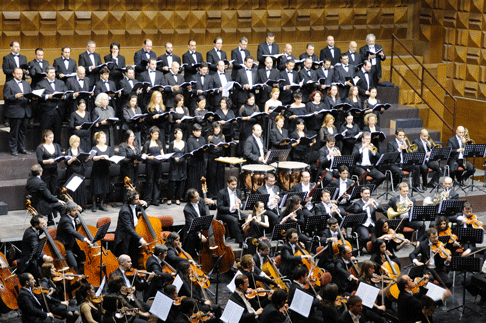
Maestro La Vecchia recalls that in 1992 he had conducted Die Schöpfung in the Amazonian Forest, at the vey confluence of the Rio Branco with the Rio Petro. Over 10,000 Indios attended the performance thrilled by the Haydn’s score. Most likely, the memory of that performance influenced conducting on May 31st. In the first part, it is noteworthy how conductor, orchestra and singers amplified the transition from the chaos (C minor) to the newly lit world (A major) . In the second act, the emphasis is on the descriptive imagery as in the portrayal of the animals: the cheerful, but rude, trombone blast of the lion, the pouncing tiger, the placing grazing of cattle, the sinuous music for the worm. The third act is less contemplative than normally performed: the love between Adam and Eve is powerful, not merely platonic; their duet is rapturous and timeless, an essential transition to the glorious final chorus.
La Vecchia and the symphony orchestra had three excellent singers to work with. Anita Selvaggio is a “soprano assoluto” better known outside Italy than in her own country. Both as an archangel and as Eve she displayed a a remarkable flexibility in the upper extension and an extraordinary use of messa di voce (a quality that many sopranos seem neither to care for nor to practice enough). Michael Smallwood is an up-and-coming Australian tenor with a delicate sensuous “legato”. David Wilson Johson is the best known of the three soloists. He once again confirmed his talent and versatility.
Giuseppe Pennisi (Based On May 31st Rome Symphony Orchestra Performance)
image=http://www.operatoday.com/OSR_Creazione-0717-2.gif image_description=Anita Selvaggio product=yes product_title=F. J. Haydn: Die Schöpfung (The Creation) product_by=Anita Selvaggio, Soprano; Michael Smallwood, Tenor; David Wilson Johnson, Bass; London Symphony Chorus. Joseph Cullen, Chorus Master. Francesco La Vecchia, Conductor. product_id=Above: Anita SelvaggioLa Scala at the Movies: Donizetti's Maria Stuarda and Wagner's Tristan und Isolde
In Maria Stuarda most of the best music and arguably all of the drama takes place in the first half of Giuseppe Bardari’s adaptation of Friedrich Schiller’s play. After Maria loses her cool and defiantly slanders Queen Elizabeth, act two becomes a somber dirge as Maria’s inevitable execution grows closer. To make the evening worthwhile, that first half has to be delivered by committed, top-notch artists unafraid of bold emoting (OK, overacting). And that’s what we get here from the mature but still exciting Mariella Devia as Maria and the brilliant, courageous work of Anna Caterina Antonacci as Elizabeth.
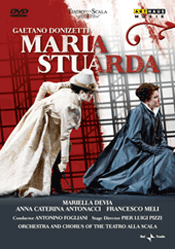 Pier Luigi Pizzi’s concept follows the “modern set/traditional costumes” route of contemporary opera production. It’s an effective gambit, avoiding the delays inherent in the scene changes of most traditional productions, and yet giving the audience something familiar and appealing to look at. The fairly clever set up begins with Elizabeth’s first scene resembling a prison, suggesting the confined emotions of the bitter Queen, as the opera portrays her. But when the scene shifts to Maria Stuarda, who actually is imprisoned, we find her outside, in a lovely grove. Once Elizabeth appears on the scene, the grove descends from view and the grim backdrop of cage walls reappears. This gets the maximum impact out of the minimum of stage design.
Pier Luigi Pizzi’s concept follows the “modern set/traditional costumes” route of contemporary opera production. It’s an effective gambit, avoiding the delays inherent in the scene changes of most traditional productions, and yet giving the audience something familiar and appealing to look at. The fairly clever set up begins with Elizabeth’s first scene resembling a prison, suggesting the confined emotions of the bitter Queen, as the opera portrays her. But when the scene shifts to Maria Stuarda, who actually is imprisoned, we find her outside, in a lovely grove. Once Elizabeth appears on the scene, the grove descends from view and the grim backdrop of cage walls reappears. This gets the maximum impact out of the minimum of stage design.
The focus here remains on the performers, and they deliver. Made-up to make her attractive self as unattractive as possible, Anna Caterina Antonacci uses the steely edge to her voice effectively, and her tightly wound fury at Maria Stuarda’s refusal to acknowledge Elizabeth’s power and authority helps to strengthen Mariella Devia’s portrayal, which isn’t as imaginative as acting. Devia takes a while to warm up, and even late in the evening her pitch strikes your reviewer’s ears as just a bit off too often. Nonetheless, she has total command of the music’s idiom, and her technical displays are enthralling, certainly capturing the love of a besotted La Scala audience. It’s not the singer’s fault that in act two Donizetti’s score asks her a few too many times to rise to a climatic high note, to less and less effect, even though Devia delivers some good ones.
The males in this opera are satellites in the orbit of these two women, but Simone Alberghini makes his Talbot a somber but warm presence by means of his dark, steady instrument. Francesco Meli takes on the tenor role, which is dramatically inert but features some challenging music. Though not a matinee idol, Meli looks presentable enough to make a romantic interest on both women’s part understandable. His voice, while not particularly distinctive, manages the score’s challenges with admirable facility. Conductor Antonino Fogliani, a new name to your reviewer, makes a very positive impression, managing the fluid tempos and dynamic shifts that keep the score fresh.
Carlo Tagliabue’s TV direction is acceptable except for the act one finale, where frenetic editing lessens rather increases the excitement. ArtHaus Music appends a model bonus feature in the familiar form of the backstage documentary. At only 12 minutes, it captures a real sense of that frantic environment, while still including some thoughtful comments from the artists. Unfortunately, the translator of the booklet essay into English, High Keith, must have been rushed. What else could explain the fractured syntax in places? But Keith deserves no blame for the bland pronouncements on the historical figures. The last paragraph on the opera’s performing history would have been sufficient.
The booklet for Virgin Classics release of Tristan und Isolde, recorded at La Scala in December 2007, has no track listing and only minimal credits. Other than presenting some high-quality photographs - not exactly essential when accompanying DVDs - the booklet exists to share Patrice Cherau’s notes, which are alternately - sometimes even simultaneously - fascinating, dopey, insightful and banal. The various section headings give some clue as to their content: “The death drive,” “Two different people,” “Sexual desire,” “The corridor to death.” Chereau might have been better off just letting his work speak for itself, for his direction of this production, along with the magnificent conducting of the La Scala orchestra by Daniel Barenboim - make this an essential viewing experience.
Isolde and Brangäne are caught in a very masculine world, a bare platform before a stony facade that somehow manages to be both a sea vessel and the two castle locations of the latter acts. In acts one and three, the leads are never really alone. Sailors work behind the singers in act one, and in act three, the mortally wounded Tristan has a small group of his men around him, waiting for him to regain consciousness. The grim set (by Richard Peduzzi) risks the tedium of visual monotony, but Chereau’s ability to keep the stage picture fluid and energized obviates the risk. Moidele Bickel’s costumes feature almost no color, either, except for a bold red robe for Isolde in act two. Somehow, the production still deserves to be called “vivid,” for such is the heart-pounding inspiration of the performances.
Two of the stars have made their roles key parts of their repertoire. Waltraud Meier recorded her Isolde with Barenboim some years ago. She will never be the ideal Isolde vocally for many listeners, as her top narrows to a copper wire intensity, and she is often less concerned with accuracy of pitch than evocation of mood. But as a total performance, Meier’s Isolde on this night recorded here encompasses more of the role than most any other singer has captured: the rage, the mysticism, the sensuality. Towering over most of the cast (only Ian Storey’s Tristan comes close in height), Matti Salminen’s King Marke makes his late appearances in each act imposing and even threatening, both physically and vocally. This is a sad man, but with an edge of physical violence, as he manhandles those, like Melot, who have brought him face to face with a reality he did not want to see.
Supposedly Barenboim personally selected Ian Storey for this, the singer’s first go at Tristan. He certainly looks more like a Tristan than most other singers, with a handsome, silver-haired head and a tall, strong physique. Vocally he seems right at the edge of his resources almost all night, but he makes it through, and the totality of her performance is quite affecting. Made up to look older and plainer than she is, Michelle DeYoung’s Brangäne helps Meier’s Isolde to look younger and even more beautiful than she is. Their voices, however, bear a bit too much of a resemblance to each other, including a proclivity on DeYoung’s part for wiry, intonation-challenged top notes. Gerd Grochowski’s Kurwenal is a slender, wild-eyed mascot to Storey’s Isolde, with an obsessive love for his master. The voice is far from handsome but matches this characterization well.
Patrizia Carmine’s TV direction opts occasionally for some cheesy dissolve effects. Each of the acts gets its own disc, with curtain calls included, which are, understandably, quite lengthy at the end of the evening. Your reviewer appreciates the inclusion; others might wish to see a two disc-set with a lower price. The Maria Stuarda has little competition on DVD. There are many strong versions of Tristan und Isolde available, including an earlier Barenboim-led effort filmed at Bayreuth which is excellent. Anyone seriously interested in opera performance today should still want to view both of these titles.
Chris Mullins
image=http://www.operatoday.com/TristanBarenboimDVD.gif image_description=Richard Wagner: Tristan und Isolde
product=yes producttitle=Richard Wagner: Tristan und Isolde productby= Matti Salminen, Will Hartmann, Gerd Grochowski, Ian Storey, Waltraud Meier, Michelle DeYoung. Milan Teatro alla Scala Orchestra, Milan Teatro alla Scala Chorus. Daniel Barenboim, conducting. productid=Virgin Classics 51931599 [3DVDs] price=$50.99 producturl=http://www.arkivmusic.com/classical/album.jsp?album_id=211078
Gaetano Donizetti: Maria Stuarda ArtHaus Musik DVD 101 361
PUCCINI: Turandot — Buenos Aires 1965
Music composed by Giacomo Puccini (1858–1924). Libretto by Giuseppe Adami and Renato Simoni based on Turandot, Prinzessin von China (1802), Johann Christoph Friedrich von Schiller's adaptation of Turandotte (1762) by Carlo Gozzi.
First Performance: 25 April 1926, Teatro alla Scala, Milan.
| Principal Characters: | |
| Princess Turandot | Soprano |
| The Emperor Altoum, her father | Tenor |
| Timur, the dispossessed King of Tartary | Bass |
| Calaf, the son of Timur | Tenor |
| Liù, a young slave-girl | Soprano |
| Ping, Grand Chancellor | Baritone |
| Pang, General Purveyor | Tenor |
| Pong, Chief Cook | Tenor |
| A Mandarin | Baritone |
| The Prince of Persia | Silent role |
| The Executioner (Pu-Tin-Pao) | Silent role |
Setting: Peking in the distant past.
Synopsis:
A Mandarin announces that any prince seeking to marry the Princess Turandot must first answer three riddles. If he fails, he must die. The latest suitor, the Prince of Persia, is to be executed at the moon's rising. In the crowd is Timur, banished King of Tartary, who is reunited with his son, Calaf, who he thought died in a battle. The Prince of Persia passes on his way to the scaffold and the crowd calls upon the Princess to spare him. Turandot bids that the execution proceed. As the death cry is heard, Calaf, transfixed by the beauty of the Princess, strides towards the gong that announces a new suitor. Turandot's ministers, Ping, Pang and Pong, try to discourage Calaf. Timur and Liù (who is in love with Calaf) also beg him to reconsider, but he strikes the gong and calls Turandot's name.
Ping, Pang and Pong lament Turandot's bloody reign, hoping that love will conquer her icy heart and peace will return. They think longingly of their distant country homes, but the noise of the populace gathering to hear Turandot question the new challenger brings them back to reality.
The people, eager for another execution, have gathered in the square. The Emperor asks Calaf to reconsider, but he refuses. Turandot describes how her ancestor was dishonoured and killed by a conquering prince; the cruel trial her suitors have to undergo is revenge for that crime. Turandot asks Calaf three riddles, which he answers correctly. Turandot begs her father not to give her to the stranger, but to no avail. Calaf, hoping to win her love, offers Turandot a challenge: if she can learn his name by dawn, he will forfeit his life.
Calaf hears a proclamation: on pain of death, no one in Peking shall sleep until Turandot learns the stranger's name. Ping, Pang and Pong try unsuccessfully to bribe him to learn his secret. As the mob threatens him, soldiers drag in Liù and Timur. Calaf tries to convince the mob that neither knows his secret. Liù declares that she alone knows but will never tell. She is tortured, but remains silent. Impressed by such endurance, Turandot asks Liù's secret: "Love" replies Liù. Fearing that she will weaken under torture Liù seizes a dagger and kills herself. The crowd, fearful of her dead spirit, forms a funeral procession. Left alone with Turandot, Calaf first reproaches her for her coldness and cruelty, then kisses her. Feeling emotion for the first time, Turandot weeps. Now sure of his victory, Calaf reveals his identity. Before the assembled crowd, Turandot announces the stranger's name: it is Love. As Calaf embraces her, the court hails the power of love and life.
[Synopsis Source: Opera Australia]
Click here for the complete libretto.
Click here for the complete libretto (English translation).
Click here for the complete text of Turandot, Prinzessin von China.
image=http://www.operatoday.com/nilsson_turandot.gif image_description=Birgit Nilsson as Turandot audio=yes first_audio_name=Giacomo Puccini: Turandot first_audio_link=http://www.operatoday.com/Turandot2.m3u product=yes product_title=Giacomo Puccini: Turandot product_by=La principessa Turandot: Birgit Nilsson; Calaf: Dimiter Uzunov; Liù: Montserrat Caballé; Ping: Ricardo Catena; Pang: Nino Falzetti; Pong: Virgilio Tavini; Timur: Victor De Narké; L'imperatore Altoum: Italo Pasini; Un mandarino: José Crea. Orquesta y Coro del Teatro Colón de Buenos Aires. Fernando Previtali, conducting. Live performance, Buenos Aires, 3 September 1965.Czech Bass Wins BBC Cardiff Singer Of The World Song Prize
After being presented with his Welsh crystal trophy this modest artist said, “I am very tired and very happy and feel wonderful. It could have been better but it was okay, I now need to get some sleep before Sunday’s concert.” Jan is also taking part in the main prize final on Sunday, along with competitors from Japan, Ukraine, Russia and Italy.
He then joked with Julian Smith, the Competition’s musical adviser who had selected Jan for the Competition in auditions held in Berlin, where Jan is based with the Komische Oper, “This is all your fault - you are responsible!”.
Afterwards Adam Gatehouse, Editor of Live Music at BBC Radio 3, said the Competition reflected the growth in interest and standing of song. “Song has been the Cinderella of the singing world but over the last two decades has been transformed and that change has been seen over this week with the attention of the audiences. We have heard more than 160 songs over six days and that is quite something.”
The other contestants in the final at a packed St David’s Hall, Cardiff were Javier Arrey, aged 27, baritone, from Chile; Eri Nakamura, aged 31, soprano, from Japan; Yuriy Mynenko, aged 30, counter-tenor, Ukraine and Natalya Romaniw, aged 22, soprano, Wales.
Chairman of the panel of international judges John Fisher made the announcement after they made exhaustive deliberations as to who should win the competition and its £5,000 prize.
Mr Fisher, Chief Executive and Artistic Director of Welsh National Opera, said the judges had heard wonderful singing this week in what he had earlier in the Competition described as “such a demanding art form”.
Judging the BBC Cardiff Singer of the World Song Prize were Adam Gatehouse, Editor Live Music BBC Radio 3, John Fisher, singers Kurt Moll and Ann Murray and accompanist and lieder specialist Helmut Deutsch. The Song Prize jury is chaired by John Fisher. The official accompanists were Phillip Thomas, Simon Lepper and Llŷr Williams.
Each of the 25 singers who are competing for the title BBC Cardiff Singer of the World were eligible to enter the separate Song Prize with its £5,000 prize and a trophy.* The winner may also join BBC Radio 3’s New Generation Artists Scheme.
Three of the finalists will also compete on Sunday for the title BBC Cardiff Singer of the World 2009. Jan Martiník, Eri Nakamura and Yuriy Mynenko will be joined by 21-year-old Italian tenor Giordano Lucà and Russian soprano Ekaterina Shcherbachenko, aged 32. Both competitions are organised by BBC Cymru Wales.
The 25 singers taking part in this year’s Competition are representing nations as far afield as Chile and Russia, Australia and Italy were selected from more than 600 singers from around the world who took part in auditions in 44 locations in more than 30 countries for the biennial competition.
This year all singers are also be eligible to benefit from a new bursary to help towards the development of their musical careers. A follower of BBC Cardiff Singer of the World, Annie Sankey, has left the competition a bequest and a new bursary in her name to support singers who take part in the competition has been established. Menna Richards, Director BBC Cymru Wales said, “The bursaries will help support the studies of competitors, including helping with travel and the purchase of musical scores”.
Both competitions are receiving extensive coverage by the BBC across the networks including BBC Cymru Wales, Radio 3, BBC Two and BBC Four and online.
image=http://www.operatoday.com/JanMartinik.gif imagedescription=Jan Martiník
product=yes producttitle=Czech Bass Wins BBC Cardiff Singer Of The World Song Prize productby=Above: Jan Martiník
Russian Soprano Wins BBC Cardiff Singer of the World
The elegant 32-year-old soprano delighted the packed St David’s Hall, Cardiff audience with a stunning programme that brought the week of competition to a thrilling close.
The decision of the panel of international judges was announced by John Fisher, Chief Executive and Artistic Director of Welsh National Opera. Ekaterina was then presented with her Welsh crystal trophy and £15,000 prize by the Competition’s Patron Dame Joan Sutherland.
The elegant and graceful singer said at the end of the exhilarating and hotly contested competition, organised by BBC Cymru Wales, Ekaterina said, “This is the happiest day of my life”.
The concert hall audience included opera casting agents, opera house directors and music lovers from around the world - and the other Competition contestants who hung on every note of their fellow young singers.
Ekaterina was the last singer of the evening that had opened with a sparkling performance from young Japanese soprano Eri Nakamura from Japan that set the standard.
That was followed by the youngest competitor, tenor Giordano Lucà, aged 21, from Italy, who only won his place in the final in the Competition’s last concert round on Thursday, with a programme of Italian arias.
Bass Jan Martiník, aged 26, from the Czech Republic who on Friday night had won the Song Prize which runs in parallel with last night’s operatic competition gave a performance of dramatic arias that was full of character. Both competitions are organised by BBC Cymru Wales.
The only counter-tenor in the Competition, 30-year-old Ukrainian Yuriy Mynenko gave a masterly performance that ranged from Handel to Rossini and delighted the audience. Ekaterina then appeared and charmed the audience with an elegant and sophisticated performance in French and Italian and closing in English with Stravinsky’s The Rake’s Progress.
Sir Michael Lyons, chairman of the BBC Trust announced the winner of the Audience Prize, worth £2,000, which is chosen by a public telephone vote and supported by the Royal Welsh College of Music and Drama, was Italian tenor Giordano Lucà.
In the concert rounds the singers sang with either the BBC National Orchestra of Wales conducted by Lawrence Foster or the Orchestra of Welsh National Opera conducted by Lawrence Foster. In the final BBC NOW was conducted by whichever of the two conductors had worked with their concert round.
The 25 singers taking part in this year’s Competition represented nations as far afield as Chile and Russia, Australia and Italy and were selected from more than 600 singers from around the world who took part in auditions in 44 locations in more than 30 countries for the biennial competition.
This year all singers are also be eligible to benefit from a new bursary to help towards the development of their musical careers. A follower of BBC Cardiff Singer of the World, Annie Sankey, has left the competition a bequest and a new bursary in her name to support singers who take part in the competition has been established. Menna Richards, Director BBC Cymru Wales said, “The bursaries will help support the studies of competitors, including helping with travel and the purchase of musical scores”.
image=http://www.operatoday.com/photo-%28c%29BRIAN-TARR2009.gif image_description=Ekaterina Shcherbachenko
product=yes producttitle=Russian Soprano Wins BBC Cardiff Singer of the World productby=Above: Ekaterina Shcherbachenko
June 14, 2009
Berlin: City of Three Operas
It was, for example, an ordinary Monday late in the season at Berlin’s Staatsoper. On stage was an Elektra new two years ago. Even with Deborah Polaski in the title role one expected at most a solid but routine performance. How wrong one can be!
This, it turned out, was an Elektra light years beyond the highest expectations that one might have — or have had, in every way: cast, orchestra. conductor and production team made this an evening that packed an unprecedented wallop — even for someone with 60 years of Elektras behind him.
Elektra has long been Polaski’s favorite and signature role. She first sang it, one reads, in 1984 on her 35th birthday. Since then she’s been on stage in the work — sometimes in concert — over 300 times.
And on May 25 it was, of course, Polaski who made the Staatsoper Elektra a soul-shattering experience. She’s a tall, well proportioned woman of infinite energy. Even after 100 minutes singing at emotional extremes almost without a break, there was no sign of fatigue.
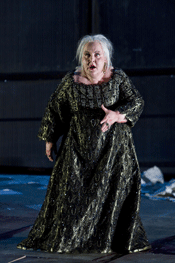 Jane Henschel as Klytemnästra [Photo by Clive Barda for Royal Opera House]
Jane Henschel as Klytemnästra [Photo by Clive Barda for Royal Opera House]
The audience was near collapse from the wrenching performance, but Polaski — exuberant in relishing the murder of mother Klytemnästra and step-father Aegisth — seemed capable of singing the entire opera again.
Polaski speaks of herself as a member of a functional family who thus has special insights into the dysfunctional household of these mythic Greeks.
In a recent interview she stressed that we know nothing of these characters earlier in their lives. Elektra, for example, might have once had a tender and loving mother in Klytemnästra and even in their heated confrontation in the opera might long again for such warmth.
It the kind of thinking that accounts for the intense profundity of Polaski’s portrayal. Great as she was on this evening, however, Polaski was almost upstaged by American mezzo Jane Henschel who took the tormented Klytemnästra through successive stages of despair, anxiety and dementia.
In the States, Henschel’s departure from the stage in hysterical laughter would have evoked wild applause, and even in Berlin one felt that the staid German audience was fighting the temptation to acclaim the singer‘s achievement.
Anne Schwanewilms was an unusually virginal sister Chrysothemis, and ageing Reiner Goldberg an impressive Aegisth.
In supporting roles, however, it was young German bass-baritone Hanno Müller-Brachmann who was a third star of the evening. He portrayed brother Orest as a totally autonomous individual who arrives with the single purpose of double murder and walks towards it essentially unperturbed by the fate of his sister. This, in turn, left Elektra doubly pathetic as she realized that she had failed to give him the axe that had killed father Agamemnon and that she had consecrated as the weapon of revenge. Director Dieter Dorn focused perceptive attention both on music and text and eschewed all theatrical trappings. And conductor Michael Boder made clear that the Staatskapelle, recently returned from its 10-concert New York Mahler cycle, is one of the world’s great orchestras.
More than in any of his other operas it is in Tannhäuser that Richard Wagner drew a clear line between a good girl and a bad one. The eponymous knight hero wallows first in Venus’ cesspool of seething sexuality, while virginal Elizabeth pines in vain for his affection.
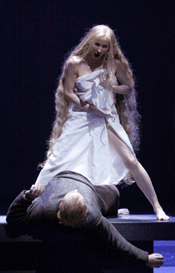 Nadja Michael as Venus
Nadja Michael as Venus
Yet the whore-virgin dichotomy does not hold — especially not when the two women are portrayed by a single singer, as was the case at the Deutsche Oper here on May 31. As Venus Germany’s Nadja Michael, famed elsewhere as a nude Salome, was a double for Lady Godiva. She was cloaked solely in copious knee-length blond locks, otherwise teasingly covering herself with a somewhat diaphanous white cloth. But as she moved toward transcendence as Elizabeth, Venus’ blond hair fell again from her head. But then it was only Elizabeth who had any understanding of Tannhäuser’s Act Two praise of sensuality to which his puritanical contemporaries responded with such horror.
The current DO production, new last January, did little to clarify matters. Director was Kirsten Harms, controversial general director — Intendantin — of the DO. Harms’ major mentors were the late Ruth Berghaus and Achim Freyer, mastermind of the current production of Wagner’s Ring des Nibelungen at Los Angeles Opera. (Both Berghaus and Freyer served apprenticeships in Bert Brecht’s Berlin Ensemble, where the concept of didactic theater was developed.) Harms’ production is a collage of brilliant — and original — ideas, but like so much of today’s Regieoper (a concept sometimes translated as “Eurotrash”) its many parts do not add up to a meaningful whole. And one can only marvel at a budget that makes such a staging possible.
Central to it was a stage that can be raised and lowered even with the company’s magnificent full chorus on it. Elizabeth’s “beloved hall” is peopled with a troop of armed men that bring to mind China’s terracotta warriors. It turns out, however, that they are mere props — tin Men of Oz, as it were — that then rise above the stage, where they remain suspended at various levels throughout the second and third acts. The pilgrims of Act Three, returning ill from Rome, are confined to a full stage of hospital beds, among which Elizabeth seeks her errant knight. (Did Harms perhaps have AIDS in mind?) Interesting, to be sure — but did it all throw new light on Tannhäuser? One rather had an image of Harms backstage — the kid in the toy shop — gleefully pushing buttons to raise and lower the stage. Happily, all this was offset by the musical excellence of the May 31 performance.
The chorus, the work of William Spaulding, is one of Berlin’s major musical glories and it brought new awareness to the immense role played by the ensemble in this work. And the chorus had its equal in the DO orchestra, conducted by French-born Philippe Auguin, who early in his career served as an assistant to Herbert von Karajan and Georg Solti.
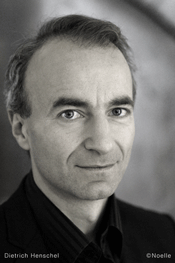 Dietrich Henschel [Photo by Noelle]
Dietrich Henschel [Photo by Noelle]
Although Michael was mesmerizing in her double role, the evening was stolen vocally by Dietrich Henschel, a late replacement for an ailing Markus Brück. Germany’s Henschel, a baritone often viewed as the successor to Dietrich Fischer-Dieskau, brought a depth to Wolfram von Eschenbach that left one wondering why Elizabeth did not respond to his wooing rather than holding out for the redeemed Tannhäuser of husky, Colorado-born Scott MacAllister.
After two decades with several German companies MacAllister has only recently moved into the heroic Fach. His is at best an adequate voice, and in a production focused so sharply on the visual an unlikely lover. In addition to the splendor of his voice and his interpretation of Wolfram, Henschel is well remembered as Don Giovanni at Berlin’s Komische Oper a few seasons ago. He sang the first act of the Mozart opera clad largely in white Jockey’s.
A new production of Tales of Hoffmann at Berlin’s Komische Oper is always of special interest, for Walter Felsenstein, who founded the company in 1947, made the Offenbach work a signature piece.
Indeed, Felsenstein’s 1958 staging of Hoffmann was the sensation of the final pre-Wall seasons in this then-divided city, when art-oriented West Berliners had two items at the top of their wish-list — both of them in the East of the city: a ticket to the Berlin Ensemble, whose master Bert Brecht had died only in 1956, and one to Felsenstein‘s Hoffmann at the Komische Oper.
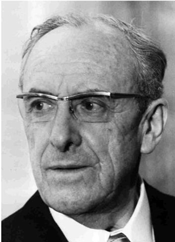 Walter Felsenstein
Walter Felsenstein
And although a half-century later that Hoffmann is vivid in the memory of those who saw it, others are today unaware of Felsenstein’s achievement not only in staging the opera, but in preparing an edition of it that gave the work the stature that it now enjoys in the international repertory.
For Offenbach died without leaving the world a definitive edition of this score that elevated him to a level above the operetta composer as which he was first famous. Yet there is no doubt much in the Hoffmann currently on stage at the KO that would cause Felsenstein to blush, for the East Germany that supported his theater so handsomely was a prudish society that would have winced at the open sexuality of Thilo Reinhardt’s production that was new two years ago.
Reinhardt moved Hoffmann to the present, staging all five act in a single setting by Paul Zoller that was easily transformed to accommodate the changing locales of the story.
True to Felsenstein’s concept of opera as music theater, the KO assembled a cast astonishing in its combination of physical appearance and vocal splendor. Best of the lot was Cornelia Götz, who played Olympia as a Marilyn-Monroe look-alike in blond wig and a heavy fur coat, under which she wore very little. Tatjana Gazdik was a mellow-voiced Antonia, while Karolina Gumos fell below the standard of her colleagues as Giulietta.
Andreas Conrad was a less-than-ideal Hoffmann, for his somewhat strident tenor was alien to the illusion-ridden Romantic that this figure is.
Nonetheless, the performance on May 30 was an evening of the high entertainment that confirmed the often-encountered opinion that the KO is the most adventurous and interesting of Berlin’s three opera houses.
Francois Xavier Roth conducted the superb KO orchestra with elan. Costumes were by Katharina Gault. (Newsreel footage of Felsenstein’s 1958 Hoffmann is available, by the way, in the 12-DVD documentation of the director’s work issued by ArtHaus a year ago.) [N.B. Click here for Opera Today’s review.]
A disquieting aspect of musical life in Berlin is the number of empty seats encountered at many events. At the May 31 performance of Tannhäuser at the Deutsche Oper, for example, the second balcony was half empty, and in the front rows of the orchestra dozens of seats went unsold.
At the Komische Oper, famous for its provocative stagings, empty seats abound despite the fact that it is by far the cheapest of Berlin’s three opera houses and that generous discounts prevail. Could this be in any way related to the fact that the KO still sings all operas in German?
And even a mostly-Wagner concert by Simon Rattle and the Berlin Philharmonic on May 28 was not sold out. This is especially sad for those who knew Berlin decades ago when there was never an empty seat anywhere. Indeed, many performances then were sold out by subscription at the outset of the season.
One hesitates to read the handwriting on the wall, for here too the audience is aging, and the interest in classical music among the young — although markedly stronger than in the States — is declining. Add to this the fact that Germany also is haunted by the world-wide financial crisis. One hears of budget cuts everywhere.
Yet behind all this looms a larger cause for alarm. It is still the vast amount of public money invested in them that makes Germany’s musical organizations unique — and great. How long will the taxpayer who never attends an opera be willing to continue such support?
Wes Blomster
image=http://www.operatoday.com/PolaskiElektraParis2005.gif imagedescription=Deborah Polaski as Elektra [Photo by Eric Mahoudeau]
product=yes producttitle=Berlin: City of Three Operas productby= product_id=Above: Deborah Polaski as Elektra [Photo by Eric Mahoudeau]
June 12, 2009
Tosca in San Francisco
Over the years some of the performances have even been memorable — fiery Carmens and intense Toscas, mesmerizing conducting, productions that have occasionally been gripping. And there have been those performances that are imminently forgettable.
We may all have had our favorite performance, the one to which we compare all others. Or perhaps none of the productions we have seen have come near our idea of what the perfect Carmen or the perfect Tosca should be. This latest San Francisco Opera rendition of Tosca will be many things to many people, though it is unlikely to be anyone’s favorite, more likely for most of us it is one to be forgotten. The sooner the better.
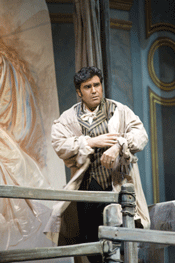 Carlo Ventre (Cavaradossi) [Photo by Terrence McCarthy courtesy of San Francisco Opera]
Carlo Ventre (Cavaradossi) [Photo by Terrence McCarthy courtesy of San Francisco Opera]
Back in 1997 SFO general director Lotfi Mansouri had the kitsch
idea of reviving the 1923 San Francisco Opera production (the first SFO season)
to reopen the repaired War Memorial Opera House. Kurt Herbert Adler had also
once dragged it out for some occasion, maybe it was to commemorate the
company’s fiftieth anniversary. Just now David Gockley must have
calculated the savings to be had by hanging these old canvases instead of
paying for a modern production. And perhaps he believes that these old rags are
like an old sweatshirt, just too comfortable and lovable to throw out.
Here in San Francisco we were once promised the Tosca of Maria Callas, but instead we had the brilliant Marie Collier. We had the Tosca of Magda Olivero at age 71 (she is now 99), a holdover from the golden age of verismo to show us how it was supposed to have been done. And we have had a host of lesser and greater Toscas over the years. The latest one is Canadian soprano Adrienne Pieczonka, whose full, rich and even voice makes a plush, comfortable Tosca quite at odds with the quixotic temperament of the high strung murderess who crosses herself and then hurls herself into the void. Need one be reminded that Puccini’s Tosca is a character defined role.
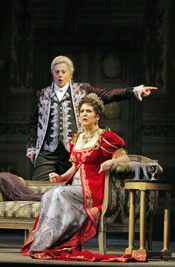 Lado Ataneli (Scarpia) and Adrianne Pieczonka (Tosca)
Lado Ataneli (Scarpia) and Adrianne Pieczonka (Tosca)
Cavaradossi was Italian tenor Carlo Ventre who brought bona fide Italianate
vocalism, and bona fide stock Italianate acting gestures. Mr. Ventre comes from
the Carreras mold, heaving his voice from his throat and chest, igniting an
exciting squillo when needed. Preoccupied with tenorial sound he found
none of the sweetness Puccini imbued into the arias of his sentimental painter,
leaving this tenor under appreciated by a crowd ready to cheer. He was however
a strength of the production.
Georgian baritone Lado Ataneli seemed a more versatile artist than his colleagues as he was able to combine singing with character. The sheer power of Puccini’s Scarpia though must tower over the artistic personalities of his victims. He must embody both spiritual and temporal power, and the brute force of pure libido. Mr. Atanel’s more sophisticated approach to his role was instead overwhelmed by the more operatic, less dimensional performances of his colleagues.
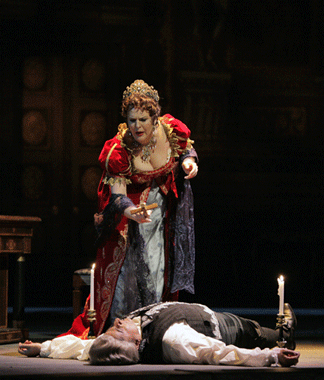 Adrianne Pieczonka (Tosca) and Lado Ataneli (Scarpia)
Adrianne Pieczonka (Tosca) and Lado Ataneli (Scarpia)
Both conductor Marco Armilliato and stage director Jose Maria Condemi
confused verismo with realism, meticulously illustrating every twist
and turn of the text. Verismo is direct, immediate emotion, not
elaboration of detail. It is thus that verismo lends itself to melodrama
— a sudden shocking action that unleashes a huge emotion. Rather than
build to the melodramatic moments that cap each of Puccini’s three acts,
this production lost itself in tedious detail, exacerbated by a Tosca and
Cavaradossi physically incapable of inhabiting their characters. Mo. Armilliato
sometimes took his musical illustration to extremes, forcing his singers to
establish and hold the beat of the text while he dragged it emotively. It was
here that tedium became torture.
Of the smaller roles, the Spoletta of Joel Sorensen was effective, the scenes involving Scarpia’s henchmen were in fact skillfully drawn by stage director Condemi. The Sacristan of Dale Travis and his scenes were terminally cute, the San Francisco Boys Chorus proving itself once again one of our city’s great treasures.
It is time for a new Tosca in San Francisco, a theatrical one.
Michael Milenski
image=http://www.operatoday.com/Picture034.gif image_description=Adrianne Pieczonka (Tosca) [Photo by Cory Weaver courtesy of San Francisco Opera] product=yes product_title=G. Puccini: Tosca product_by= product_id=Above: Adrianne Pieczonka (Tosca) [Except as otherwise indicated, photos by Cory Weaver courtesy of San Francisco Opera]Otto Nicolai: Die lustigen Weiber von Windsor
Rarely performed outside Germany, the opera begins with a tuneful, energetic overture which remains a staple of classical radio stations — but then again, those aren’t in the best health either. CPO does its part to remind the opera-loving public of Nicolai’s last and greatest work by issuing this well-recorded live performance from February 2007, with Ulf Schirmer leading the Bayerischer Rundfunk forces at the Prinzregententheater in Munich.
A comparison of Verdi and Arrigo Boito’s take on Shakespeare’s The Merry Wives of Windsor and that of Nicolai and his librettist (the wonderfully named Salomon Hermann von Mosenthal) demonstrates the difference between genius and talent. Falstaff begins with the title character, putting him on stage in three full dimensions, in a way that does tribute not only to the role in this late, little respected comedy but as well to the Falstaff of the Henry plays. Die lustigen Weiber von Windsor follows the play more closely, with Sir John not even entering until act two and having relatively few musical highlights to himself. As a result, act one drags, with little of the memorable melodic material from the overture appearing. Act two is more lively, and act three has some wonderful moments, including (at last!) some development of the overture’s best tunes. Nonetheless, Nicolai’s music remains comfortably familiar but rarely inspired, whereas Verdi’s late score burns and bustles with invention.
As other CPO recordings of his have shown, Schirmer is an excellent conductor, rhythmically spry and alert, with few if any lapses in tension. The cast, with one exception, sings characterfully. Verdi kept the name Ford, but for some reason Nicolai has Sir John Falstaff involved with Herr and Frau Fluth. Markus Eiche and Juliane Banse take the latter roles; Eiche has a handsome baritone that suggests he would do well in some of the Italian repertory’s great roles, while Banse uses the steely nature of her upper range to give her character an edge appropriate to the character’s female resourcefulness. Alfred Reiter impersonates Falstaff, and although the role offers nowhere near the opportunities for greatness that it does in Verdi’s opera, Reiter fills the role’s requirement of comic bluster. As the young lovers Anna and Fenton, Anna Kornodi sings with appealing sweetness, but Ferdinand von Bothmer’s tenor wavers and strains too much of the time.
Unfortunately for Bothmer, a comparison to the 1960s’ EMI set really puts him in the shade, as Fritz Wunderlich sang Fenton with an outpouring of both taste and beauty that makes Fenton’s act two romance sound like a greater aria than it probably is. With a cast also featuring Gottlob Frick and Edith Mathis, that EMI set should be first option for anyone interested in the opera. These days it may be hard to find, however, and this CPO set, in excellent live sound despite a couple of instances of audience noise, does a fine job overall of bringing some life to Nicolai’s otherwise dormant creation.
Chris Mullins
image=http://www.operatoday.com/0761203731725.gif image_description=Otto Nicolai: Die lustigen Weiber von Windsor
product=yes producttitle=Otto Nicolai: Die lustigen Weiber von Windsor productby=Juliane Banse, Anna Korondi, Annette Markert, Markus Eiche. Chor des Bayerischen Rundfunks, RO München. Ulf Schirmer, conducting. productid=CPO 777 317-2 [2CDs] price=$33.99 producturl=http://www.arkivmusic.com/classical/Drilldown?nameid1=8692&namerole1=1&compid=32950&bcorder=15&labelid=1118
BBC Cardiff Singer of the World Finalists Named
They comprise the Competition’s youngest and eldest competitors and are two sopranos, a bass, a tenor and the only counter-tenor in this year’s competition.
Each were winners in the concerts they took part in during the last five days in front of packed audiences at St David’s Hall, Cardiff and the panel of international judges.
Chairman of the judges John Fisher, Chief Executive and Artistic Director of Welsh National Opera made the announcement to hushed audience members, each eager to hear if their choices matched those of the experts.
The five finalists who will compete on Sunday at St David’s Hall for the title BBC Cardiff Singer of the World 2009 are: soprano Eri Nakamura, aged 31, from Japan; soprano Ekaterina Shcherbachenko, aged 32, from Russia; tenor Giordano Lucà, aged 21, from Italy; bass Jan Martiník, aged 26, from the Czech Republic 30-year-old counter-tenor Yuriy Mynenko, from Ukraine.
Huw Edwards and Aled Jones present the final of BBC Cardiff Singer of the World from St David’s Hall with expert analysis and comment on BBC Two from 5.30pm BBC Radio 3 live coverage of the final is presented by Petroc Trelawny with commentary from Catherine Bott from 5.30pm. Nicola Heywood Thomas presents coverage of the final on BBC Radio Wales from 5pm and Sian Pari Huws, Alwyn Humphreys and Beti George present BBC Radio Cymru’s coverage from 5pm.
The 25 singers are competing for the title BBC Cardiff Singer of the World and receive a £15,000 prize, which is provided by the City and County of Cardiff. The Competition is organised by BBC Wales.
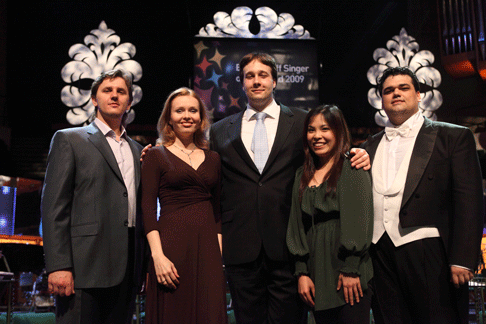 Yuriy Mynenko, Ukraine; Ekaterina Shcherbachenko, Russia; Jan Martiník, Czech Republic; Eri Nakamura, Japan and Giordano Lucà, Italy.
Yuriy Mynenko, Ukraine; Ekaterina Shcherbachenko, Russia; Jan Martiník, Czech Republic; Eri Nakamura, Japan and Giordano Lucà, Italy.
The 25 singers who represent nations as far afield as Chile and Russia, Australia and Italy were selected from more than 600 singers from around the world who took part in auditions in 44 locations in more than 30 countries for the biennial competition.
This year all singers taking part will also be eligible to benefit from a new bursary to help towards the development of their musical careers. A follower of BBC Cardiff Singer of the World, Annie Sankey, has left the competition a bequest and a new bursary in her name to support singers who take part in the competition has been established. Menna Richards, Director BBC Cymru Wales said, “The bursaries will help support the studies of competitors, including helping with travel and the purchase of musical scores”.
Twenty of the singers also took part in the BBC Cardiff Singer of the World Song Prize which had its own final at St David’s Hall on Friday, June 12.
image=http://www.operatoday.com/BBC-Logo.gif image_description=BBC Singer of the World
product=yes product_title=BBC Cardiff Singer of the World Finalists Named
June 11, 2009
Ein Buh für die Sterilität
By Lisa Sonnabend [Süddeutschen Zeitung, 9 June 2009]In einem weißen Gewand vor einem grauen Gebäude, das kein ägyptischer Tempel ist, sondern wie eine unbelebte Neubausiedlung aussieht, windet sich Aida in ihrer Verzweiflung. Die äthiopische Sklavin in Hand der Ägypter ist hin- und hergerissen zwischen der Liebe zu zwei Männern, die gegeneinander Krieg führen: der Liebe zu ihrem Vater und zum ägyptischen Heerführer Radames.
June 10, 2009
VERDI: I masnadieri — Baden-Baden 1998
Music composed by Giuseppe Verdi. Libretto by Andrea Maffei after Friedrich von Schiller’s play Die Räuber (1781).
| Principal Roles: | |
| Massimiliano, Count Moor | Bass |
| Carlo, his son | Tenor |
| Francesco, brother to Carlo | Baritone |
| Amalia, an orphan, the Count’s niece | Soprano |
| Arminio, the Count’s treasurer | Tenor |
| Moser, a pastor | Bass |
| Rolla, a companion of Carlo Moor | Tenor |
First Performance: 22 July 1847, Her Majesty’s Theatre, London
Scenes:
Part 1: A tavern on the border of Saxony, Franconia: a room in the Moors' castle, a bedroom in the castle
Part 2: An enclosure adjoining the castle chapel, the Bohemian forest
Part 3: A deserted place adjacent to the forest near the castle, inside the forest
Part 4: A suite of rooms, the forest as in the final scene of Part 3
Synopsis
The drama is set at the beginning of the 18th century and covers about three years. Carlo Moor, son of Count Massimiliano, is a young man of noble sentiments, although his impetuous temperament has caused him to lead a wild life. His younger brother, Francesco, deceitful and wicked, induces their father to disinherit Carlo, and sends him a mendacious letter telling him that he is forbidden to return home. Carlo swears to take revenge and becomes the leader of a band of robbers with whom he spreads terror in the forests of Bohemia. Meanwhile Francesco not only tries to win the love of Amalia, Carlo's betrothed, he also has his father told that Carlo is dead, and imprisons the old man in a tower to hasten his demise so that he will be able to usurp his title. Amalia, having escaped into the forest, suddenly finds herself face to face with Carlo, who has returned because of his nostalgia for her and for his ancestral home. The mysterious Arminio makes his way through the forest to take food secretly to the old Count. Carlo happens to witness this scene, frees his father and uncovers the plot. At this point he solemnly swears with his robbers to avenge the wrongs suffered by his father. In the concluding turmoil Carlo, overcome with hysterical fury, stabs his beloved in order not to involve her in the shame of his life as a bandit, and then heads for the gallows to pay for his crimes.
Click here for the complete libretto.
Click here for the English translation of Die Räuber.
image=http://www.operatoday.com/masnadieri.gif image_description=I masnadieri audio=yes first_audio_name=Giuseppe Verdi: I masnadieri first_audio_link=http://www.operatoday.com/Masnadieri1.m3u product=yes product_title=Giuseppe Verdi: I masnadieri product_by=Massimiliano: Carlo Colombara; Carlo: Franco Farina; Francesco: Dmitri Hvorostovsky; Amalia: Paula Delligatti; Arminio: Robin Leggate; Moser: Julian Konstantinov; Rolla: Gerard Quinn. The Royal Opera Chorus. The Orchestra of the Royal Opera House. Edward Downes, conductor. Live performance, 8 June 1998, Festspielhaus, Baden-Baden.Ukrainian Counter-Tenor Wins Third Concert in BBC Cardiff Singer of the World
Chairman of the panel of international judges John Fisher made the announcement at the end of the third of the five concerts in St David’s Hall, Cardiff.
Mr Fisher, chief executive and artistic director of Welsh National Opera, presented the 30 year old counter tenor with a Welsh crystal trophy to make his achievement.
Yuriy is the only counter-tenor taking part in this year’s competition. He studied piano and choral conducting before concentrating on singing.
In 2004 he graduated from the vocal department of the AV Nezhdanova Odessa State Musical Academy, Ukraine. He continued his vocal studies there as a postgraduate.
In 2001 he won the Voice of Ukraine national competition in Kiev and the International Slavic Festival in Paris. He won a special award for best counter-tenor at the Francisco Viñas International Singing Contest in Barcelona in 2003.
In 2004 he won the Grand Prix at the AB Solovyanenko International Competition, Donetsk, Ukraine; the Rimsky-Korsakov International Competition for Young Opera Singers in St Petersburg; and was a finalist and award winner at the Gmyrya International Competition in Kiev.
He was a finalist and award winner at the Dresden International Opera Competition in 2007. Yuriy has given solo concerts in countries including England, Russia, Ukraine, Greece, Germany, Spain, France and Israel. In June and November this year, tours are planned in Israel and America with a solo baroque masterpieces programme.
In his spare time, Yuriy enjoys sports, cooking, reading and computer programming.
The other singers were Tomislav Lučić, aged 31, bass, from Croatia; Izabela Matuła, aged 29, soprano, Poland; Csaba Szegedi, aged 27, baritone, Hungary and Claire Meghnagi, aged 31, soprano, from Israel.
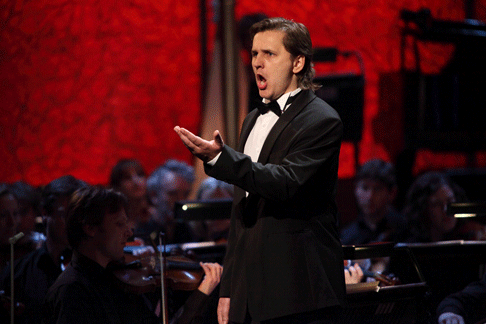
The highlights from the third concert round can be seen on BBC FOUR this evening (Wednesday, June 10) from 7.30pm. The BBC Cardiff Singer of the World 2009 final will be on BBC TWO and BBC Radio 3 from 5.30pm on Sunday, June 14.
The 25 singers are competing for the title BBC Cardiff Singer of the World and receive a £15,000 prize, which is provided by the City and County of Cardiff. The Competition is organised by BBC Wales.
Although winner of his concert Yuriy is not guaranteed a place in next Sunday’s final as the judges wait until they have heard all 25 singers before selecting their top five. It is possible two singers may go through from one concert round and the winner of a concert round not be selected for the final five. Indeed this happened in 2007 when fellow Japanese soprano Mari Moriya won her concert round but did not reach the final.
The 25 singers who represent nations as far afield as Chile and Russia, Australia and Italy have been selected from more than 600 singers from around the world who took part in auditions in 44 locations in more than 30 countries for the biennial competition.
This year all singers taking part will also be eligible to benefit from a new bursary to help towards the development of their musical careers. A follower of BBC Cardiff Singer of the World, Annie Sankey, has left the competition a bequest and a new bursary in her name to support singers who take part in the competition has been established. Menna Richards, Director BBC Cymru Wales said, “The bursaries will help support the studies of competitors, including helping with travel and the purchase of musical scores”.
Twenty of the singers are also taking part in the BBC Cardiff Singer of the World Song Prize which has its own final at St David’s Hall on Friday, June 12.
Both competitions are receiving extensive coverage by the BBC across the networks including BBC Cymru Wales, Radio 3, BBC Two and BBC Four and online.
Tomislav Lučić — Croatia
A te l'estremo addio ... Il lacerato spirito (Simon Boccanegra)
— Verdi
Madamina, il catalogo è questo (Don Giovanni) — Mozart
Susanin's aria (A Life for the Tsar) — Glinka
Izabela Matuła — Poland
Ach, ich fühl's (Die Zauberflöte) — Mozart
Bel raggio lusinghier (Semiramide) — Rossini
Celui dont la parole efface toutes peines — Il est doux, il est bon
(Hérodiade) – Massenet
Csaba Szegedi — Hungary
Largo al factotum (Il barbiere di Siviglia) — Rossini
Perfidi — Pieta, rispetto amore (Macbeth) — Verdi
Deh, vieni alla finestra (Don Giovanni) — Mozart
O Carlo, ascolta ... Io morrò (Don Carlo) – Verdi
Yuriy Mynenko — Ukraine
J'ai perdu mon Eurydice (Orphée et Eurydice) — Gluck
Va tacito e nascosto (Giulio Cesare) — Handel
Parto, parto (La clemenza di Tito) — Mozart
Claire Meghnagi — Israel
Giunse alfin il momento ... Deh vieni, non tardar (Le nozze di Figaro)
— Mozart
Che più giova celarlo ... M'lai resa infelice (Deidamia) —
Handel
Ich wollt' ein Sträusslein binden (Brentano Lieder) — R
Strauss
Non monsieur mon mari (Les mamelles de Tirésias) — Poulenc
Finalists Named For Song Prize
They are:
Javier Arrey, aged 27, baritone, from Chile
Tomislav Lučić, aged 31, bass, from Croatia
Jan Martinik, aged 26, bass, Czech Republic
Yuriy Mynenko, aged 30, counter-tenor, Ukraine
Natalya Romaniw, aged 22, soprano, Wales
Chairman of the panel of international judges John Fisher made the announcement after the panel of judges had heard the 20 singers who had taken part in four recitals over the last four days.
Mr Fisher, chief executive and artistic director of Welsh National Opera, said the judges had heard wonderful singing this week. He said it was “exhilarating and stimulating to hear young singers in such a demanding art form.”
Judging the BBC Cardiff Singer of the World Song Prize were Adam Gatehouse, Editor Live Music BBC Radio 3, John Fisher, Kurt Moll, Ann Murray and accompanist and lieder specialist Helmut Deutsch. The Song Prize jury is chaired by John Fisher. The official accompanists were Phillip Thomas, Simon Lepper and Llŷr Williams.
Each of the 25 singers who are competing for the title BBC Cardiff Singer of the World were eligible to enter the separate Song Prize with its £5,000 prize, a trophy and the offer of a recital as part of the Rosenblatt Recital Series at St John’s Smith Square. The winner may also join BBC Radio 3’s New Generation Artists Scheme.
On Thursday evening Mr Fisher will also announce the names of the artists who have been selected for the finalists of BBC Cardiff Singer of the World with its £15,000 prize, which is provided by the City and County of Cardiff. The final takes place at St David’s Hall on Sunday, June 14.
Both competitions are organised by BBC Wales.
The 25 singers are representing nations as far afield as Chile and Russia, Australia and Italy were selected from more than 600 singers from around the world who took part in auditions in 44 locations in more than 30 countries for the biennial competition.
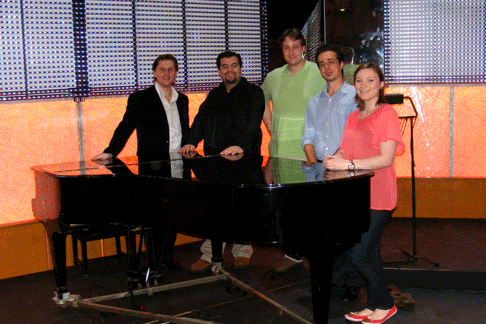 Yuriy Mynenko (Ukraine), Javier Arrey (Chile), Jan Martiník (Czech Republic), Tomislav Lučić (Croatia) and Natalya Romaniw (Wales)
Yuriy Mynenko (Ukraine), Javier Arrey (Chile), Jan Martiník (Czech Republic), Tomislav Lučić (Croatia) and Natalya Romaniw (Wales)
This year all singers are also be eligible to benefit from a new bursary to help towards the development of their musical careers. A follower of BBC Cardiff Singer of the World, Annie Sankey, has left the competition a bequest and a new bursary in her name to support singers who take part in the competition has been established. Menna Richards, Director BBC Cymru Wales said, “The bursaries will help support the studies of competitors, including helping with travel and the purchase of musical scores”.
Both competitions are receiving extensive coverage by the BBC across the networks including BBC Cymru Wales, Radio 3, BBC Two and BBC Four and online.
image=http://www.operatoday.com/BBC-Logo.gif image_description=BBC Singer of the Word product=yes product_title=Finalists Named For Song PrizeJune 9, 2009
Così fan tutte, English National Opera
The staging is an import from Aix-en-Provence, so did at least exist fully-fledged to begin with, but it was nonetheless a major blow to both Kiarostami and ENO that he could not be there to oversee its London revival.
Unlike some other recent opera productions by film directors one may mention, his début does not look or feel especially cinematic. Yes, there are complex animated video projections which provide the backdrop for the majority of the opera, but these seem quite separate from the live action on stage — or rather they seem to add little to the directorial interpretation of the opera as a theatrical piece. The vast calm sea projection looks lovely, but when in the second scene a little red-sailed boat heads slowly across the bay (to collect Ferrando and Guglielmo) it succeeds only in drawing the eye towards it for the entire duration of the scene, detracting attention from the singers. A projected on-stage orchestra for the wedding scene is entertaining at first, but it remains there for the whole of the final scene, and becomes annoying to watch once the real conductor’s beat has drifted slightly out of synch with it.
Otherwise the staging is an entirely conventional and old-fashioned one, disappointingly bypassing any attempt to deal with the opera’s difficult issues surrounding human nature, betrayal, and sexual double-standards. Without the projections (and some really lovely lighting by Jean Kalman) there would have been little else to distinguish this staging from one you might see from a run-of-the-mill touring company in a suburban town hall.
Of course it is highly unlikely that such a town-hall setting would boast two such classy performances as came from the evening’s soprano soloists. First, Fiordiligi: on the evidence of Susan Gritton’s performance of the same role in the previous ENO production, she wasn’t quite in her best voice on this occasion, and remains not entirely comfortable in the lower depths of the role’s enormous vocal range - but she is grippingly passionate, involving, and always intelligent. The other star turn came from young Sophie Bevan, whose confident, spunky Despina was a real highlight, using her diminutive figure to great comic effect in her guises as doctor and lawyer, and singing outstandingly well.
Stephen Page’s incisive and eloquent Don Alfonso easily dominated the two male leads, neither of whom left much of a dramatic mark, and to be honest it was tricky to see quite what the girls saw in them. At least the American baritone Liam Bonner was a vocally attractive and secure Guglielmo, but Canadian tenor Thomas Glenn was lightweight for Ferrando in such a large house, and sang untidily. Mezzo Fiona Murphy, vivacious and sassy as Valencienne in The Merry Widow and Lola in Cavalleria Rusticana, was an warm-voiced but unaccountably characterless Dorabella, and with indifferent diction too.
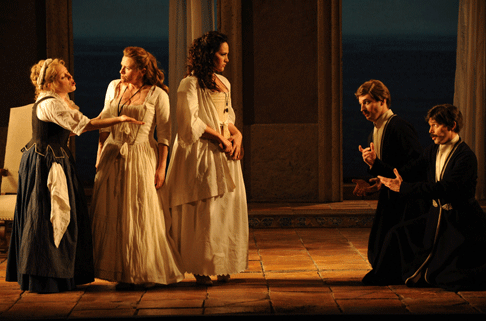 Sophie Bevan (Despina), Susan Gritton (Fiordiligi), Fiona Murphy (Dorabella), Liam Bonner (Guglielmo) and Thomas Glenn (Ferrando)
Sophie Bevan (Despina), Susan Gritton (Fiordiligi), Fiona Murphy (Dorabella), Liam Bonner (Guglielmo) and Thomas Glenn (Ferrando)
The young Swedish conductor Stefan Kingele kept everything brisk and energetic right from the start; the tempo change into the fast section of the overture was brought forward a few bars, so that the second half of the Così fan tutte motif was already charging along at the new pace. He had less success in maintaining a tight ensemble between pit and stage; there were far too many partings of the ways.
The production makes the ending simplistic to the point of nonsense, without any apparent exploration of how the couples’ feelings towards one another may have changed, developed, or turned on their head as a result of the little experiment. None of them seem, ultimately, to have been remotely challenged by it. We are left wondering why Don Alfonso bothered.
Ruth Elleson © 2009
image=http://www.operatoday.com/cosifantutte004.gif image_description=Fiona Murphy (Dorabella), Thomas Glenn (Ferrando) and Steven Page (Don Alfonso) [Photo by Stephen Cummiskey]
product=yes producttitle=W. A. Mozart: Così fan tutte productby=Fiordiligi: Susan Gritton; Dorabella: Fiona Murphy; Ferrando: Thomas Glenn; Guglielmo: Liam Bonner; Don Alfonso: Steven Page; Despina: Sophie Bevan. Conductor: Stefan Klingele. Director: Elaine Tyler-Hall. Designer: Malika Chaveau. Lighting Designer: Jean Kalman. product_id=Above: Fiona Murphy (Dorabella), Thomas Glenn (Ferrando) and Steven Page (Don Alfonso) [Photos by Stephen Cummiskey]
Russian Soprano Wins Second Concert Round in BBC Cardiff Singer of The World
Chairman of the panel of international judges John Fisher made the announcement at the end of the exciting concert in St David’s Hall, Cardiff.
Mr Fisher, chief executive and artistic director of Welsh National Opera, presented the 32 year old soprano with a Welsh crystal trophy to mark her achievement.
Ekaterina was the last of five singers who performed last night. The other four singers 31 year old English mezzo-soprano Anna Stephany, 27 year old Mexican baritone Octavio Moreno, 28 year old baritone, South African Dawid Kimberg and Korean tenor Ji-Min Park, aged 30. Full concert programme at bottom of this release.
A graduate of the Moscow State Conservatory Ekaterina made her debut at the Bolshoi Theatre, as Natasha (War and Peace). She then joined the Bolshoi company and roles she performs there include Liù (Turandot), Micaëla (Carmen), Iolanta (Iolanta) as well as Natasha, Tatyana and Mimi. Ekaterina has also worked at Opéra National de Lyon, Teatro Lirico di Cagliari and with the Danish National Symphony Orchestra, St Petersburg Philharmonic Orchestra and Royal Scottish National Orchestra in Glasgow and Edinburgh. Her future plans include touring with the Bolshoi in 2009, as Tatyana, to Tokyo, La Scala Milan and Ljubljana. In her spare time, Ekaterina enjoys reading and travelling.
These were the second five of the 25 singers who are competing for the title BBC Cardiff Singer of the World and a £15,000 prize, which is provided by the City and County of Cardiff. The Competition is organised by BBC Wales, over this week.
Although winner of her concert Ekaterina is not guaranteed a place in next Sunday’s final as the judges wait until they have heard all 25 singers before selecting their top five. It is possible two singers may go through from one concert round and the winner of a concert round not be selected for the final five. Indeed this happened in 2007 when fellow Japanese soprano Mari Moriya won her concert round but did not reach the final.
The 25 singers who represent nations as far afield as Chile and Russia, Australia and Italy have been selected from more than 600 singers from around the world who took part in auditions in 44 locations in more than 30 countries for the biennial competition.
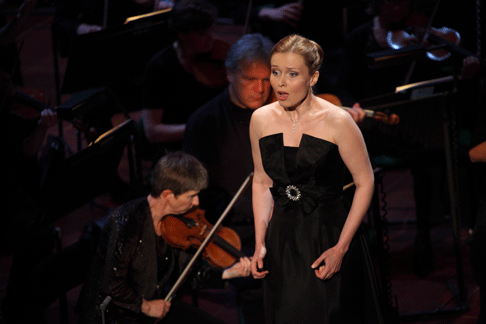
This year all singers taking part will also be eligible to benefit from a new bursary to help towards the development of their musical careers. A follower of BBC Cardiff Singer of the World, Annie Sankey, has left the competition a bequest and a new bursary in her name to support singers who take part in the competition has been established. Menna Richards, Director BBC Cymru Wales said, “The bursaries will help support the studies of competitors, including helping with travel and the purchase of musical scores”.
Twenty of the singers are also taking part in the BBC Cardiff Singer of the World Song Prize which has its own final at St David’s Hall on Friday, June 12.
Both competitions are receiving extensive coverage by the BBC across the networks including BBC Cymru Wales, Radio 3, BBC Two and BBC Four and online.
Concert two programme:
Dawid Kimberg — South Africa
Largo al factotum (Il barbiere di Siviglia) — Rossini
Mein Sehnen, mein Wähnen (Die tote Stadt) — Korngold
L'orage s'est calmé (Les pêcheurs de perles) — Bizet
Ji-Min Park — Republic of Korea
L'amour! L'amour! ... Ah! Lève-toi, soleil! (Roméo et Juliette)
— Gounod
È la solita storia del pastore ... Anch'io vorrei dormir così
(L'arlesiana) — Cilea
Avete torto — Firenze è come un albero fiorito (Gianni Schicchi)
— Puccini
Dein ist mein ganzes Herz (Das Land des Lächelns) — Lehár
Anna Stephany — England
Oh! La pitoyable aventure! (L'heure espagnole) — Ravel
Lieto del dolce incarco — Se Romeo t'uccise un figlio (I Capuleti e i
Montecchi) — Bellini
Dopo notte (Ariodante) — Handel
Octavio Moreno — Mexico
Ya vas lyublyu (The Queen of Spades) — Tchaikovsky
Gioco di rea fortuna! — O Lisbona, alfin ti miro! (Don
Sebastiano) — Donizetti
O sainte médaille ... Avant de quitter ces lieux (Faust) —
Gounod
Ekaterina Shcherbachenko — Russia
Temerari ... Come scoglio (Così fan tutte) — Mozart
Ruskai pogibnu (Tatyana's Letter Scene) (Eugene Onegin) —
Tchaikovsky
BBC Cardiff Singer of the World, Sunday, June 7 to Thursday, June 11 and final on Sunday, June 14, St David’s Hall, Cardiff. BBC Cardiff Singer of the World Song Prize, Saturday, June 6 to Tuesday, June 9 at the New Theatre, Cardiff and final on Friday, June 12 at St David’s Hall. Master Classes taken by the judges, including Dame Gwynedd Jones and Richard Bonynge, New Theatre, Cardiff and the Royal Welsh College of Music and Drama on Saturday, June 13.
Further details of the competition, competitors, jurors, accompanists, orchestras: bbc.co.uk/cardiffsinger
For more information biographies, photography and review tickets contact Mike Smith, 07795 325161. mike@mediasmith.co.uk
image=http://www.operatoday.com/Ekaterina_Shcherbachenko.gif image_description=Ekaterina Shcherbachenko [Photo courtesy of BBC Cardiff Singer of the World Competition] product=yes product_title=Russian Soprano Wins Second Concert Round in BBC Cardiff Singer of The World product_by=Above: Ekaterina Shcherbachenko [Photos courtesy of BBC Cardiff Singer of the World Competition]Royal Ballet’s Ondine heralds new Henze season in London
Ondine is an excellent herald for the opera, and indeed a year of interesting Henze events. Phaedra, (2006) will be heard at the Barbican in London next year, the highlight of a Henze retrospective. In May 2010, the very latest opera, L’Immolazione premieres in May 2010 at the Accademia di St. Cecilia in Rome.
Henze has long had a special place in Covent Garden. Ondine was a high profile commission for a composer still barely 30 years old, and proved to be a major breakthrough. He’d already made his name in opera. Boulevard Solitude (1948) his first opera, (heard in a new production at the Royal Opera House in 2001) is now established repertoire.
Ondine is excellent preparation for next year’s operas. The ballet was commissioned by Sir Frederick Ashton to showcase Margot Fonteyn. Henze’s music thus focuses on images of water, tides and waves, for the sea is Ondine’s element. She’s supernatural, so her music is magically lyrical. When she dances in the waterfall, the colours in the orchestration shimmer around her. In comparison, scenes that take place on land, especially in Act 2, are relatively earthbound, but that’s the essence of the plot. Palemon dies, but Ondine lives on, immortal.
The music flows so seamlessly into dance that you can almost see semi quavers enacted in movement. Every note reflects in dance. Pizzicato becomes en pointe, the interplay of piano, harp, and celeste become intricate ensemble. The guitar part is more than mere “Italianate colour”, for Henze loves the instrument and has written more for it than any modern composer.
Seeing Ondine in performance shows just how good a composer Henze was and is. Sir Frederick Ashton and the audiences of 1958 found the music difficult, but Henze, a devoted balletomane, wrote intuitively for dance. Now the music poses no problems. Instead, we can appreciate how it respects the physical demands of ballet. Despite the undulating, wavering beauty of the scoring there are firm undercurrents and a strong dramatic pulse.
The water spirits form a circle, their arms undulating, like a giant sea anemone, moving with the ocean tides. Graceful as the image is, it’s also powerfully muscular, underlined by the depth and energy of the music. Sea anemones look delicate, but they’re strong, a lot like ballerinas. I learned Ondine from the audio recording conducted by Oliver Knussen. Now the image of the ondines in the corps de ballet will remain with me.
The sets were designed by Lila Di Nobili, who also designed the British premiere of Elegy for Young Lovers at Glyndebourne in 1961. Sir Frederick Ashton wanted to pay tribute to 19th century ballet tradition, so the set is lushly romantic, complete with proscenium arches, like a cherished museum piece. Against this background, the dancers seem all the more youthful and vibrant.
Both Ansanelli and Hristov were replacements for scheduled dancers. Given that these roles were immortalized by Fonteyn and Michael Somes, they did well. Most impressive, though was Kenta Kura’s Tirrenio. It’s a wonderful character part, which Kura made wholly convincing. When he leaps on stage, his costume flowing in the air, he really does seem a powerful, mercurial Lord of the Mediterranean. The corps was disciplined and energetic. The Royal Opera House chorus is justly famous for its ensemble work : perhaps sharing facilities with the Royal Ballet contributes.
In April the Royal Opera House produced an unusual double bill – Handel and Purcell – but with an added attraction, combining opera with dance. Ballet and opera audiences don’t mix often enough. Perhaps, given Henze’s facility for writing for both genres, we’ll see more of his work in future years.
Anne Ozorio
image=http://www.operatoday.com/Henze.gif image_description=Hans Werner Henze product=yes product_title=Hans Werner Henze: Ondine product_by=Alexandra Ansanelli (Ondine), Valeri Hristov (Palemon), Laura Morera (Berta), Kenta Kura (Tirrenio), Artists of the Royal Ballet, Robert Clark (solo piano), Barry Wordsworth (conductor). Royal Ballet, Royal Opera House, London. Frederick Ashton: choreography.All was right but the opera itself
By David Patrick Stearns [Philadelphia Inquirer, 9 June 2009]
For those who believe divine intervention works amid the chaos of the opera world, Opera Company of Philadelphia’s production of The Rape of Lucretia seems meant to be. In its first solo foray into chamber opera at the Kimmel Center’s Perelman Theater, the casting represents a harmonic convergence of the right singers in the right roles in the right theater. Then you must ask why any divinity would intervene for an opera that has such difficulty saying what it means.
Japan Wins First Concert Round in BBC Cardiff Singer of the World 2009
Chairman of the panel of international judges John Fisher made the clearly popular announcement at the end of the concert in St David’s Hall, Cardiff.
Mr Fisher, chief executive and artistic director of Welsh National Opera, presented the 30 year old soprano with a Welsh crystal trophy to make her achievement.
Eri shared this first concert with two other sopranos, 25-year-old soprano Dana Bramane, Latvia and 27-year-old soprano Emiliya Ivanova, Bulgaria along with 30-year-old baritone Etienne Dupuis, Canada and 23-year-old bass Fernando Javier Radó, Argentina.
Eri is a graduate of Osaka College of Music and is currently a member of the Jette Parker Young Artists Programme at the Royal Opera House, Covent Garden. The 31-year-old soprano immediately won the hearts of the packed audience with sparkling singing of the bright ‘Quel guard oil cavaliere’ from Donizetti’s Don Pasquale followed by emotionally charged arias from Massenet’s Manon and Guonod’s Roméo et Juliette.
These were the first of the 25 singers who are competing for the title BBC Cardiff Singer of the World and receive a £15,000 prize, which is provided by the City and County of Cardiff. The Competition is organised by BBC Wales, over this week.
Although winner of her concert Eri is not guaranteed a place in next Sunday’s final as the judges wait until they have heard all 25 singers before selecting their top five. It is possible two singers may go through from one concert round and the winner of a concert round not be selected for the final five. Indeed this happened in 2007 when fellow Japanese soprano Mari Moriya won her concert round but did not reach the final.
The 25 singers who represent nations as far afield as Chile and Russia, Australia and Italy have been selected from more than 600 singers from around the world who took part in auditions in 44 locations in more than 30 countries for the biennial competition.
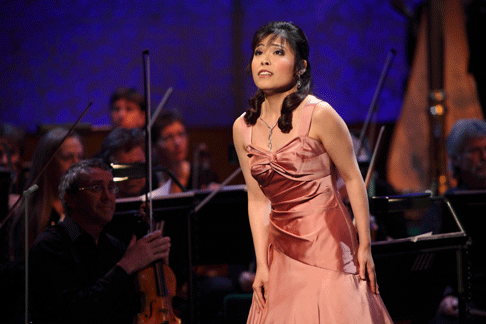
This year all singers taking part will also be eligible to benefit from a new bursary to help towards the development of their musical careers. A follower of BBC Cardiff Singer of the World, Annie Sankey, has left the competition a bequest and a new bursary in her name to support singers who take part in the competition has been established. Menna Richards, Director BBC Cymru Wales said, “The bursaries will help support the studies of competitors, including helping with travel and the purchase of musical scores”.
Twenty of the singers are also taking part in the BBC Cardiff Singer of the World Song Prize which has its own final at St David’s Hall on Friday, June 12.
Both competitions are receiving extensive coverage by the BBC across the networks including BBC Cymru Wales, Radio 3, BBC Two and BBC Four and online.
BBC Cardiff Singer of the World, Sunday, June 7 to Thursday, June 11 and final on Sunday, June 14, St David’s Hall, Cardiff. BBC Cardiff Singer of the World Song Prize, Saturday, June 6 to Tuesday, June 9 at the New Theatre, Cardiff and final on Friday, June 12 at St David’s Hall. Master Classes taken by the judges, including Dame Gwynedd Jones and Richard Bonynge, New Theatre, Cardiff and the Royal Welsh College of Music and Drama on Saturday, June 13.
Further details of the competition, competitors, jurors, accompanists, orchestras: bbc.co.uk/cardiffsinger
For more information biographies, photography and review tickets contact Mike Smith, 07795 325161. mike@mediasmith.co.uk
image=http://www.operatoday.com/Eri_Nakamura_02.gif image_description=Eri Nakamura [Photo courtesy of BBC Cardiff Singer of the World Competition] product=yes product_title=Japan Wins First Concert Round in BBC Cardiff Singer of the World 2009 product_by=Above: Eri Nakamura [Photos courtesy of BBC Cardiff Singer of the World Competition]June 7, 2009
A shockingly different Lulu at the Royal Opera House, London
Pared down to essentials, all attention is on the music. The stage is almost empty, no props, no furnishings. At first you think, why stage this at all, then? Why not just a concert performance? But gradually it dawns that the “empty” space isn’t empty at all but inhabited by the music, uncompromising and unadorned. That’s why it’s so disturbing. Without décor to cushion the narrative, it’s impossible to escape.
The word “concept” is sneered at in our anti-intellectual world, but without intellect we are no more than beasts. Berg was an extremely conceptual composer. Lulu is constructed like a complex maze, with mathematical symmetries and interrelationships. Berg was obsessed by secret codes and numerology, with patterns and images shifting as if in a kaleidoscope. Berg is doing much more than telling a story in sound. He’s creating a whole new concept, where ideas are expressed through abstraction. He’s not literal, so this very non-literal production reveals just how radical his ideas could be.
The stage is bare but for a wall of glass. Like the glass, Lulu is opaque, impenetrable. Like Lulu, the glass takes on whatever role is projected onto it, whether the scene takes place in a mansion, prison or slum. The glass is Lulu’s mirror image. No wonder there’s no need for a painted portrait. The glass is staring us in the face.
Although the designs look sleek and sophisticated, danger lurks beneath the surface. Twice the narrative is interrupted by news of a revolution in Paris. Then the Third Act takes place in Paris. Everything’s askew like The Cabinet of Dr Caligari where you don’t know who the madman is, doctor or patient. So there’s no film sequence in this production. It “is” the essence of film, and of the opera, and it’s even in black and white.
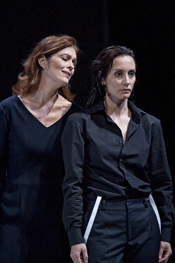 Jennifer Larmore as Countess Geschwitz and Agneta Eichenholz as Lulu
Jennifer Larmore as Countess Geschwitz and Agneta Eichenholz as Lulu
The Caligari reference is relevant for throughout this opera people are becoming what they are not, pretending to be someone else, reappearing in different forms. It’s in the music too, with its intricate constructions. So the Professor of Medicine sits with his back to the audience as Lulu fools around with the painter, has his heart attack then rises discreetly from the dead and walks off to become theatre manager and banker. The Painter doesn’t have to commit suicide “convincingly” because he comes back as The Negro. Berg isn’t being naturalistic, he’s playing games of patterns and subterfuge. If Loy’s production is confusing, that’s because the opera is about confusion.
This is not “Lulu for Beginners”, though, conversely, if it’s taken entirely on its own terms, without assumptions of what opera “should” be, it might even be easier to grasp the concept of Lulu as a musical puzzle The first time I saw Lulu was 1978 - the original of the 3 act version - and was so shocked by the passive anti-drama of Lulu’s personality that I didn’t realize that this was exactly what Berg wanted to do. Here, Loy has taken away the obvious signposts to narrative, so we’re forced, like Lulu, to be constantly alert, always aware that things may not be what they seem, and be prepared to shift and adjust. We are drawn into the jungle of shadowy dangers: hence the references to Africa (unknown territory), to snakes and predatory men. It’s a far deeper insight into Lulu’s background than the basic assumption that she was abused as a child. Loy’s implication is that the whole world’s a place where people are forced to play tricks to survive, like the Animal Trainer’s charges.
No doubt there’ll be huge opposition to this Lulu but it’s one that will keep generating ideas for a long time to come. Spartan as it is, each detail is significant. For example, when Dr Schön embraces Lulu, his arms go round her, but his palms are stretched outward. When he starts to disintegrate emotionally in Act Two, there’s a smudge of greasepaint on one side of his face. Lulu had worn such makeup when she was a dancer, and he is a man about to marry someone else. Now he’s the vulnerable one. These details are fleeting, easily missed and may mean different things, so repeated visits to this Lulu are in order.
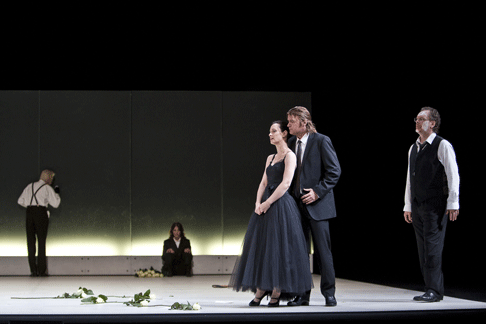 A scene from Lulu
A scene from Lulu
Indeed, the full impact of this production may not emerge until long after it’s over. Since coming away from it, I’ve been thinking about Berg’s obsessive sense of order. If the world is in perpetual, confusing chaos, then compulsive orderliness is a means of staving off danger. Berg’s symmetries and palindromes aren’t simply pattern making but a kind of secret incantation. Was he on the verge of something really radical when he died? We shall never know but it’s stimulating to wonder.
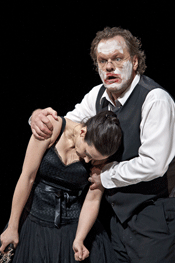 Agneta Eichenholz as Lulu and Michael Volle as Dr Schön
Agneta Eichenholz as Lulu and Michael Volle as Dr Schön
Because this production throws so much emphasis on the music, it’s quite a surprise at first how soft edged the orchestra sounded. Because Boulez is so exceptional, I have to adjust to anyone else. In rehearsals, Antonio Pappano has emphasized the Viennese aspects of this opera, and its submerged romanticism. Submerged, like Lulu’s tragedy. Despite the violence in this opera, it’s tender and dignified. So I can see where the soft focus is coming from. It acts like a counterbalance to the stark sharpness of the staging: Boulez conducting a production like this would be almost too intense to bear.
Agneta Eichenholz was Lulu. She’s quite experienced though mainly in Sweden, which is perhaps appropriate for a Lulu, whose background is unknown. A First Night at Covent Garden was perhaps the highest profile she’s ever had, so if she sounded tense, it’s completely understandable.. It’s a difficult part to sing, and to some extent shrillness fits in with the character. She doesn’t quite have the hypnotizing presence of Christine Schäfer, but it really is asking too much of anyone to expect such standards.
Michael Volle’s Dr Schön is a benchmark realization, all the more impressive because it’s his first time in the role, though he sang Wozzeck only a few months ago. This is Dr Schön’s tragedy as much as Lulu’s. He’s a man who showed compassion when he took Lulu off the streets, even if he may have got something back for doing so. Lulu clearly loves him, though she’s incapable of giving him the same kindness. Because Volle’s Dr Schön looks vigorous and in his prime, his disintegration is all the more distressing. He embodies Berg’s theme of control and chaos: an authoritative, powerful voice but the actorly skills to transit from magnate to tortured soul.
Paradoxically - Lulu is full of paradoxes - the most unrealistic scene in the opera occurs when Countess Geschwitz and Lulu swap clothes and personalities. That couldn’t happen in real life but in Loy’s production the two women really do look alike. Jennifer Larmore’s Countess Geschwitz is also a far more sympathetic portrayal than the butch Cruella DeVille some assume gay people must be. Berg’s sister Smagarda was lesbian, so he knew they were people just like anyone else. Again, this production captures the essence of the opera by not giving the game away with obvious clues. You have to concentrate when Larmore and Eichenholz aren’t singing to keep track of which is which.
Sturdy performances from Klaus Florian Vogt as Alwa and Peter Rose as the Animal Trainer/Athlete. Schigolch, though, might have needed greater definition. Unlike the other characters, he stays the same. He’s the animal who can’t be tamed, and a counter to Lulu herself, so more should have been made of the role. Gywnne Howell sang well, but the wild edge to the part wasn’t present.
Get to this production. Chances are it won’t be seen too often as it’s hardly box office candy. Some ladies sitting near me were day trippers from the country on a package tour of the capital. They must have wondered what hit them.
Anne Ozorio
image=http://www.operatoday.com/LULU-0905300613-AGNETA-EIC.gif imagedescription=
product=yes
producttitle=Alban Berg: Lulu
productby=Agneta Eichenholz (Lulu), Michael Volle (Dr Schön, Jack the Ripper), Klaus Florian Vogt (Alwa), Gywnne Howell (Schigolch), Peter Rose (Animal Trainer/Athlete), Will Hartmann (Painter. Negro), Jennifer Larmore (Countess Geschwitz), PhilipoLangridge (Prince/Manservant/Marquis), Jeremy White (Professor/Theatre Manager/Banker/, Heather Schipp)Dresser/ Schoolboy/Groom), Frances McCafferty (Mother), Kostas Smoriginas(Journalist), Vujani Mlinde (Manservant), Monika-Evelin Liiv (Gallery Owner), Simona Mihai Girl), Orchestra of the Royal Opera House conducted by Antonio Pappano, Christof Loy (director), Herbert Murauer (design).
product_id=Above: Agneta Eichenholz as Lulu
All photos by Clive Barda courtesy of the Royal Opera House
Schubert : Winterreise — Middle Temple Hall, London
This concert took place in Middle Temple Hall, deep in the warren that is London’s Inns of Court. The Knights Templar built the first buildings, and Sir Francis Drake was a regular in Elizabethan times. Sitting in this magnificently panelled hall, you’re surrounded by history. It’s an experience that gives Julius Drake’s series, now in its fourth year, a unique ambience.
The surroundings threw the stark desolation of Winterreise into sharp contrast. Christoph Prégardien has sung some chillingly prescient Winterreises. His light, clear tenor works well because it enhances the vulnerability of the protagonist better than an opulent lower timbre with lusher resonance. This was perhaps not one of Prégardien’s finest performances, but the occasional rough edges and infelicities of phrasing were not necessarily a fault. Indeed, they added a certain immediacy : too polished a performance can dull the harshness of the situation.
Yet Winterreise is not just about the protagonist. The protagonist operates in a specific, clearly delineated landscape. Schubert recognizes the importance of Wilhelm Müller’s recurrent nature imagery. The piano part is extraordinarily descriptive. We hear the frozen raindrops, the trudge of the footsteps on hard ground. Deep snow muffles sound. The protagonist is alone in the stillness. Julius Drake’s playing was lucid, each image precisely evoked. Particularly impressive was the way he created the strange sounds of distorted music, a theme not often appreciated in performances less cognizant of the piano’s role.
In the last song, the protagonist encounters an intinerant beggar who plays a hurdy gurdy as he wanders from village to village. No one listens, he’s chased by dogs, yet still he plays. The piano is a far more sophisticated instrument than the Leiermann’s primitive machine, but perhaps Schubert is telling us about the power of music. It’s almost an act of faith. Drake recognizes how early the hurdy gurdy makes its presence felt. There it is, in Mut, in the jerky, folk like phrases. Its maddened refrain heralds the appearance of the beggar, whoever he may be, wherever he may lead.
Anne Ozorio
image=http://www.operatoday.com/ChristophPr%C3%A9gardien.gif imagedescription=Christoph Prégardien [Photo by Rosa-Frank.com]
product=yes producttitle=Song in the Middle Temple, London productby=Christoph Prégardien, (tenor), Julius Drake (piano) product_id=Above: Christoph Prégardien [Photo by Rosa-Frank.com]